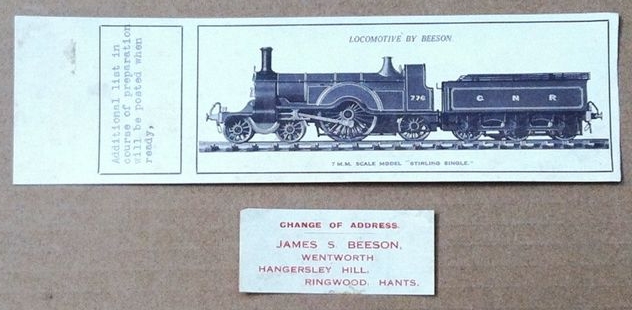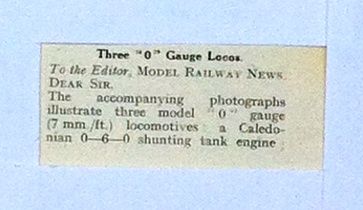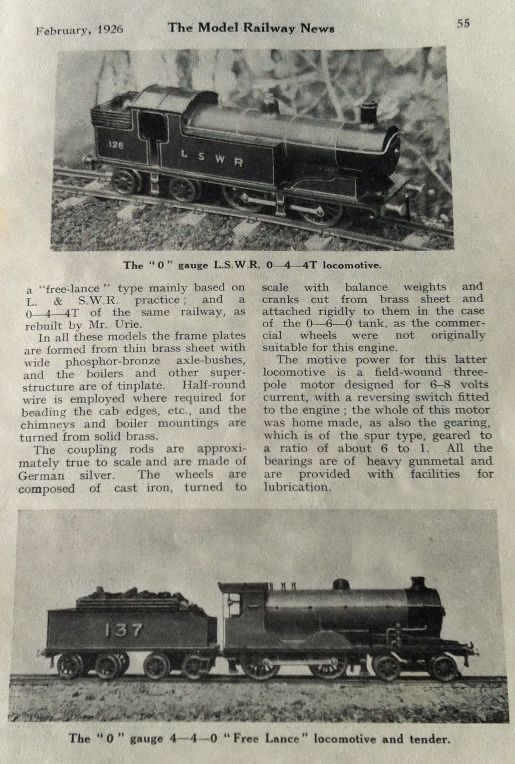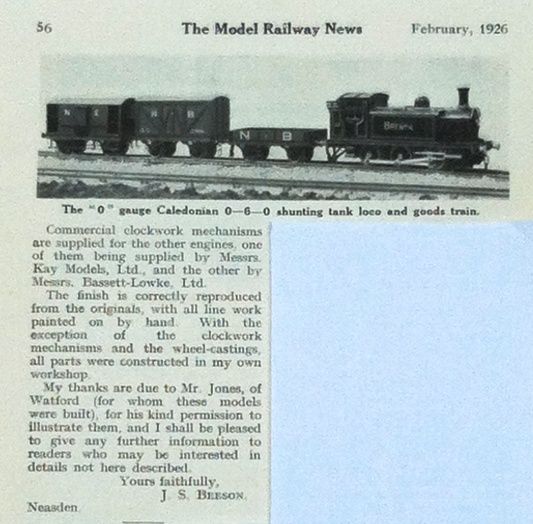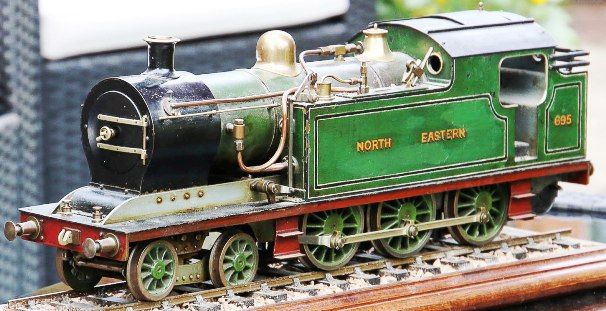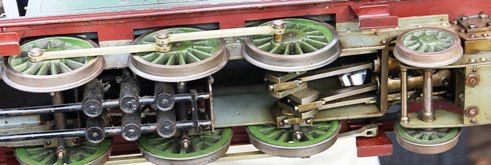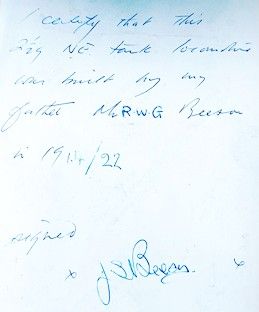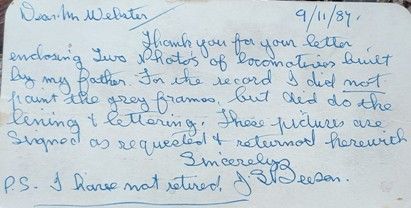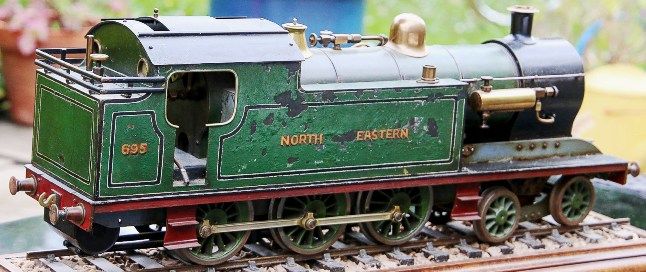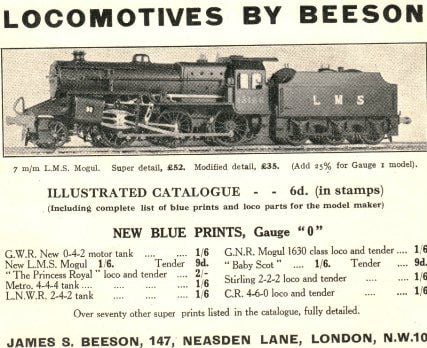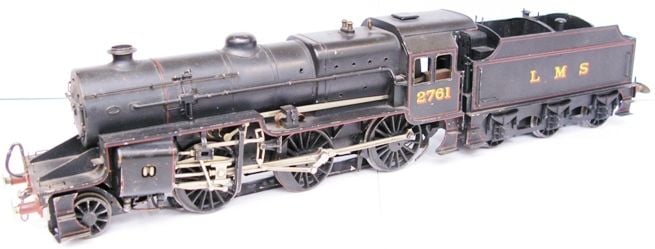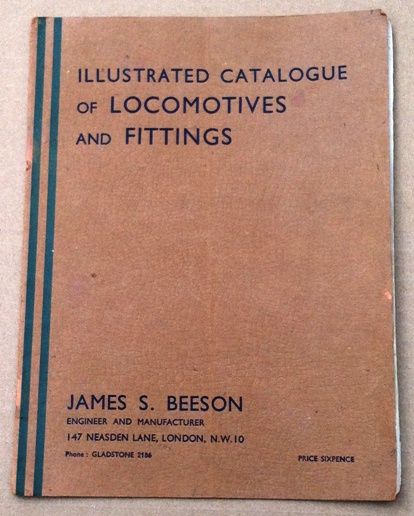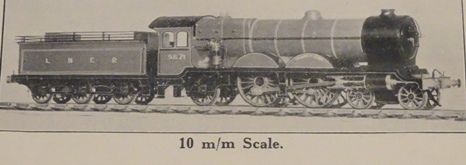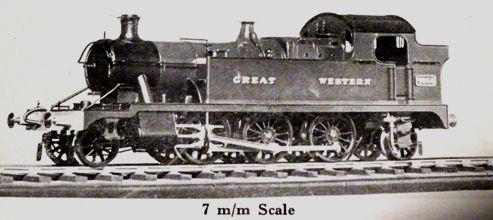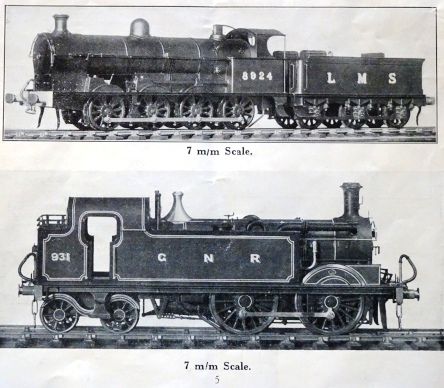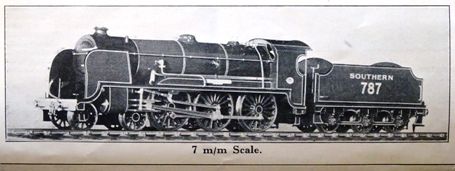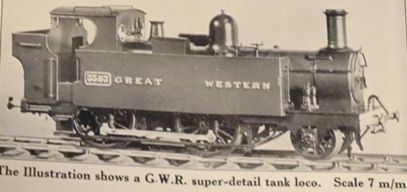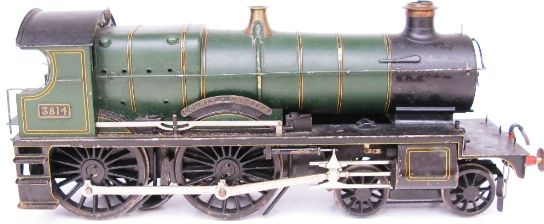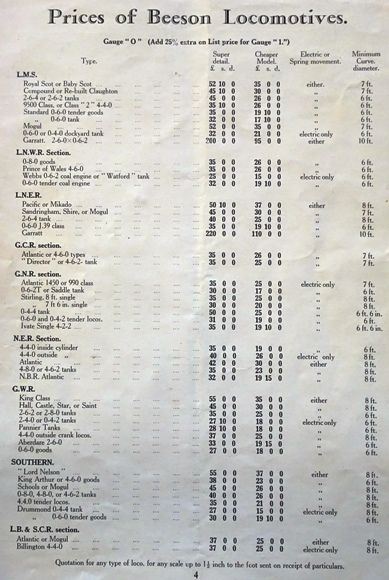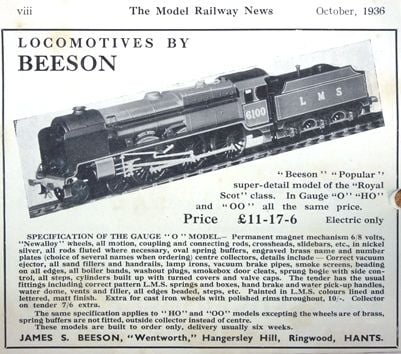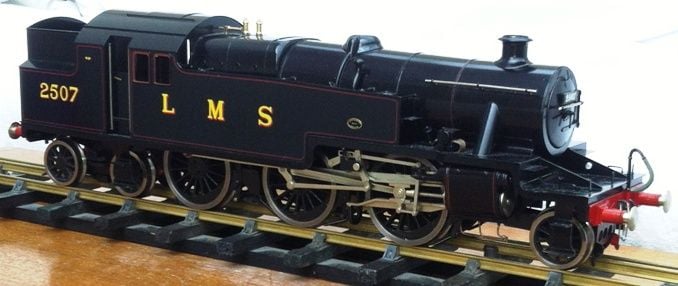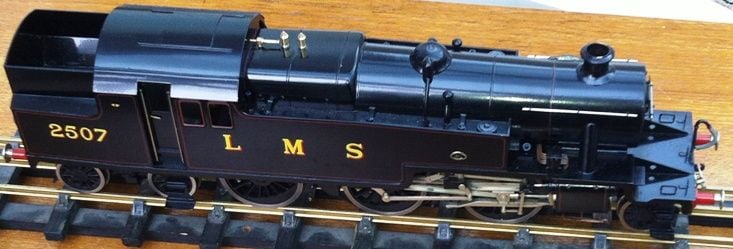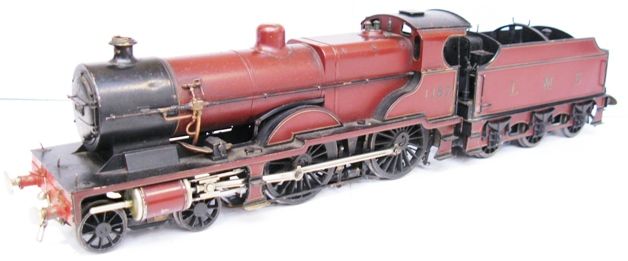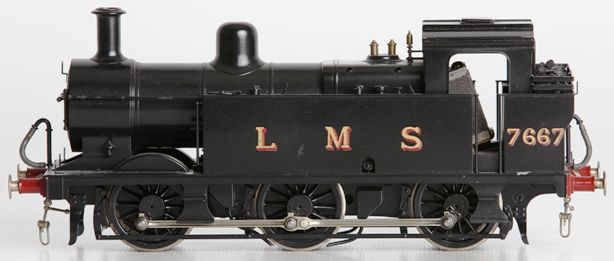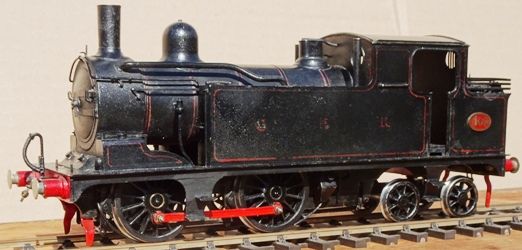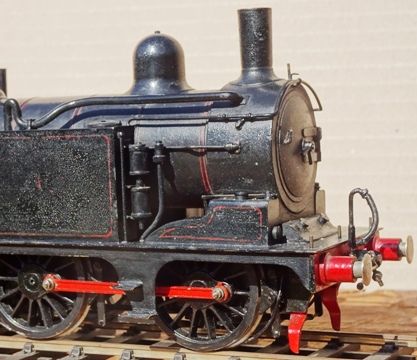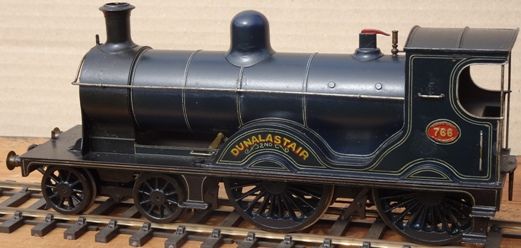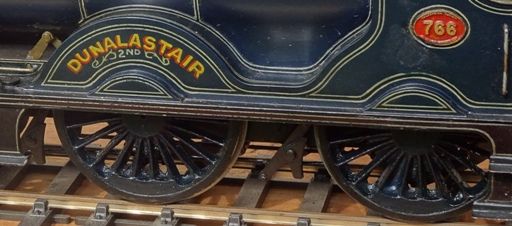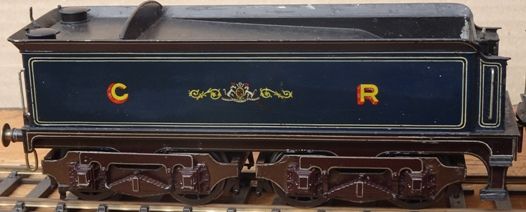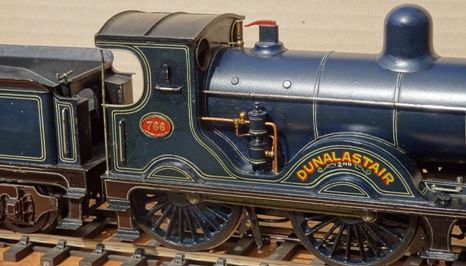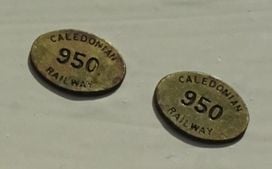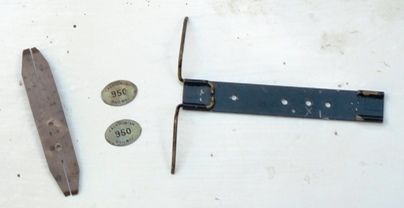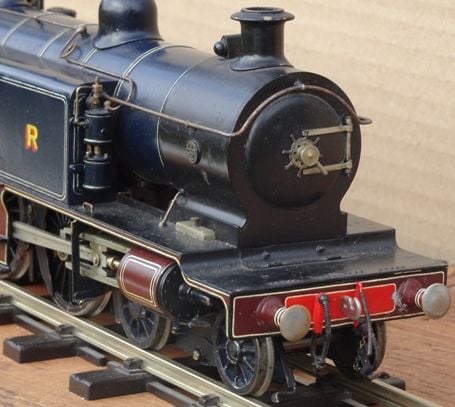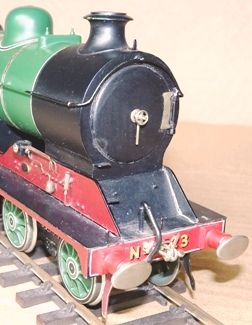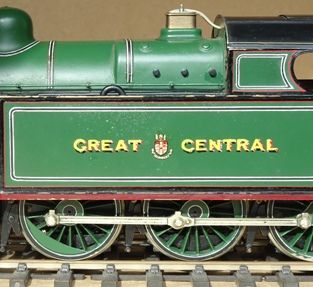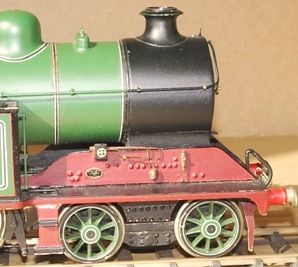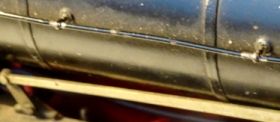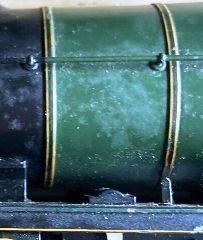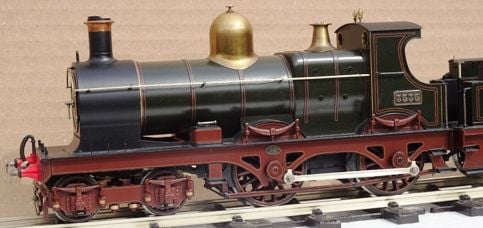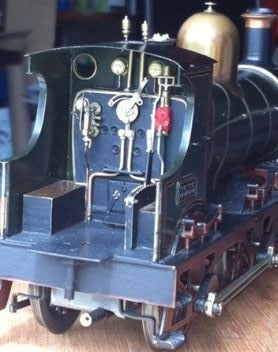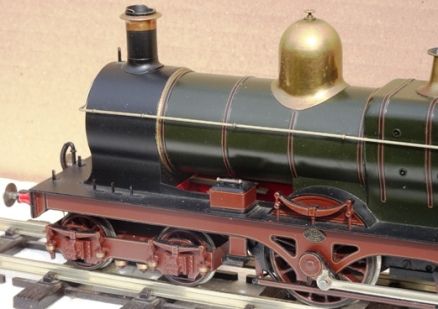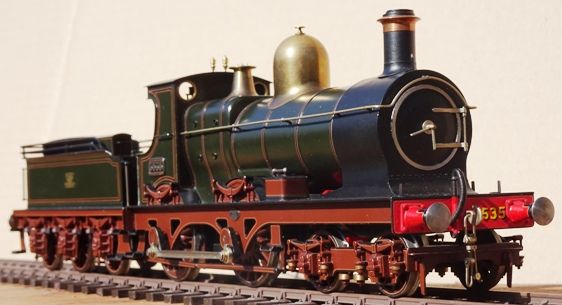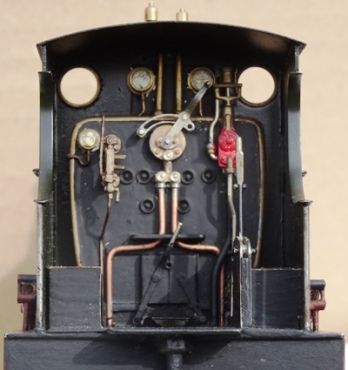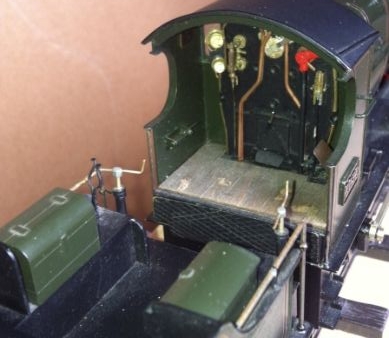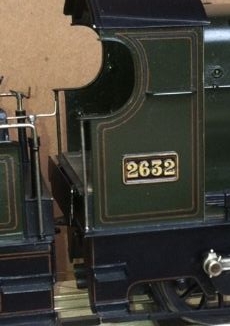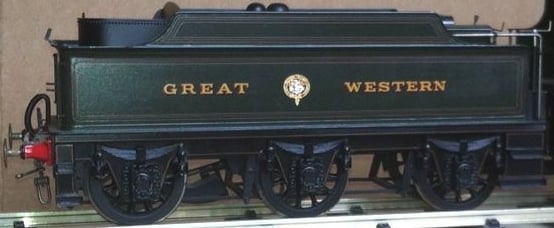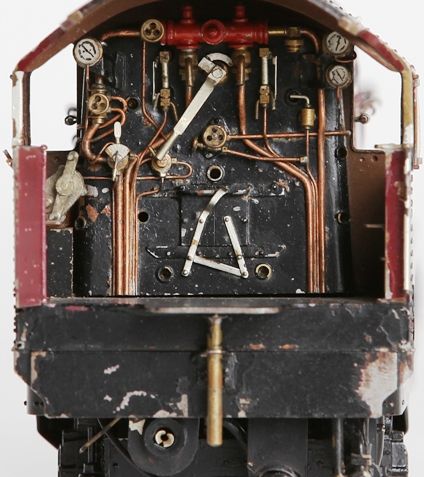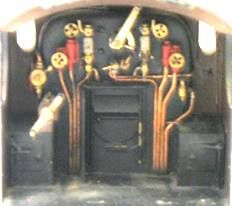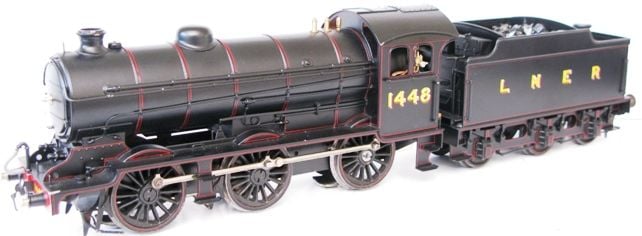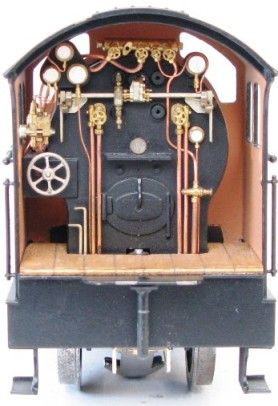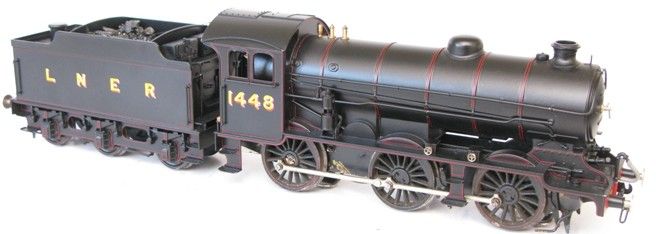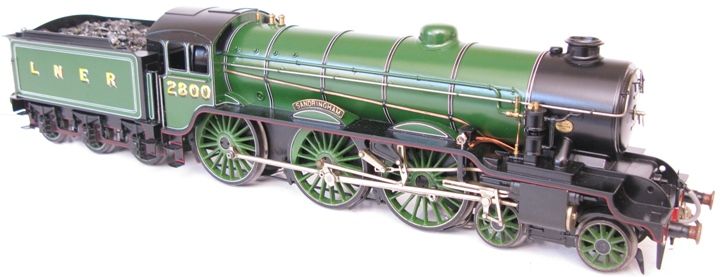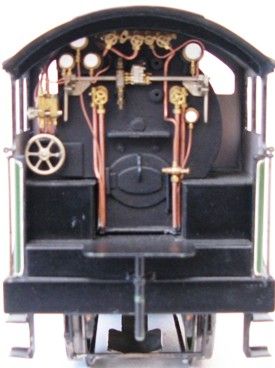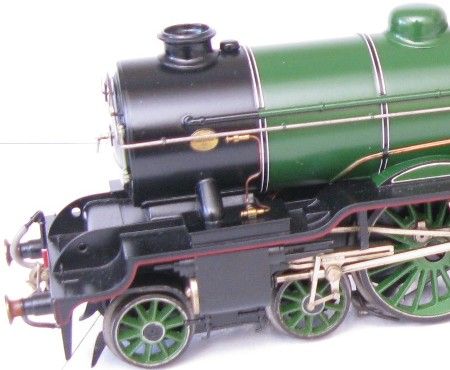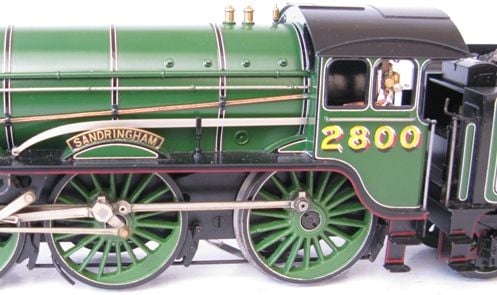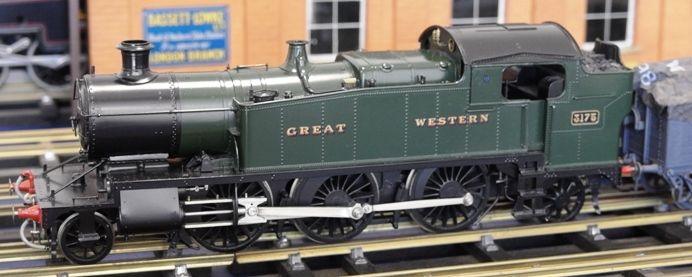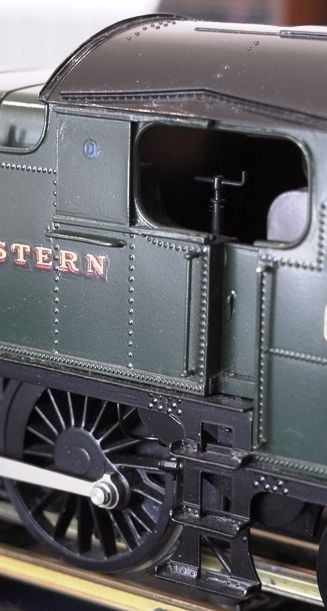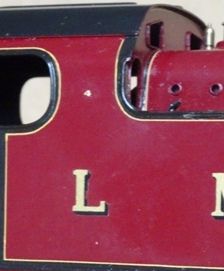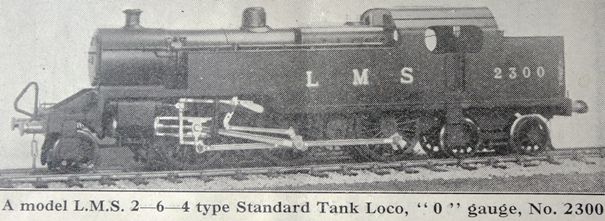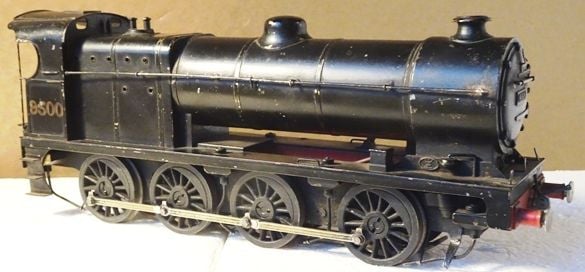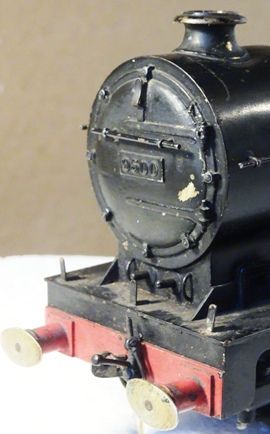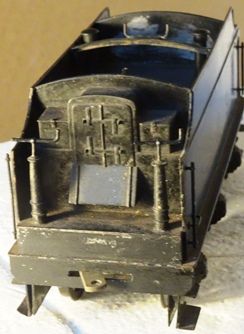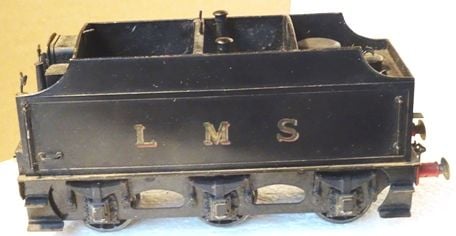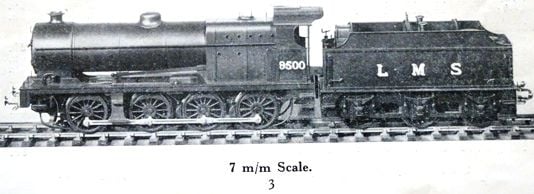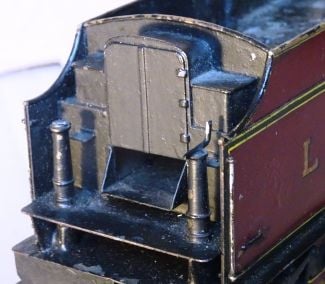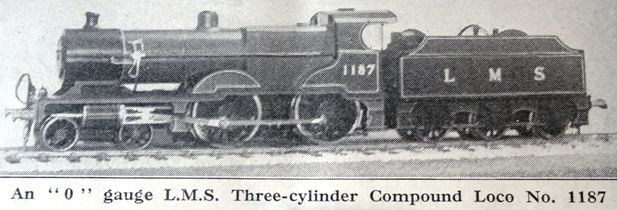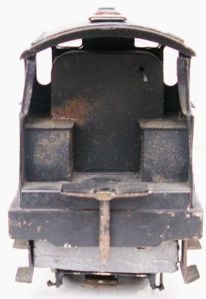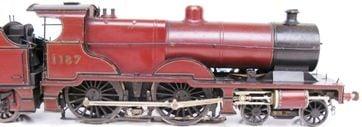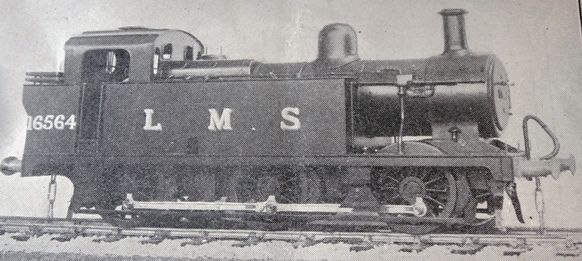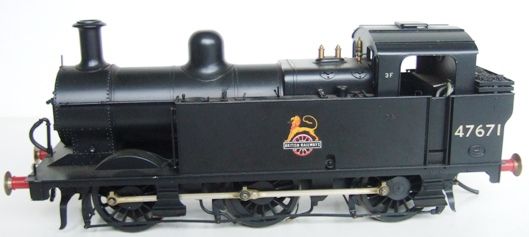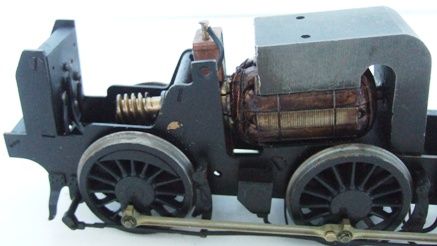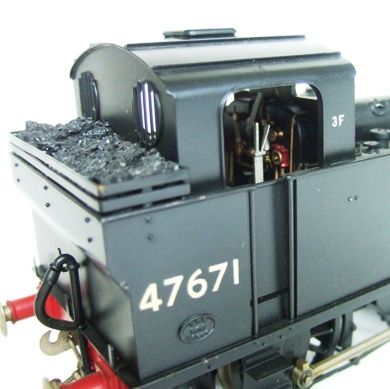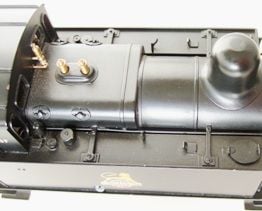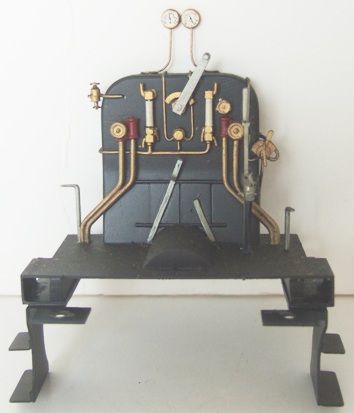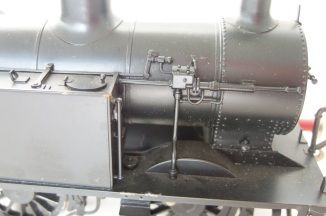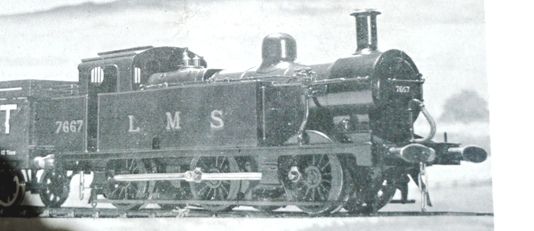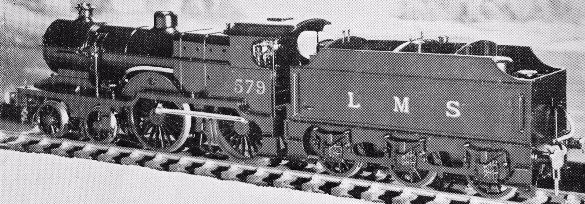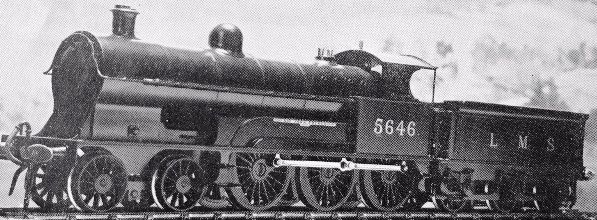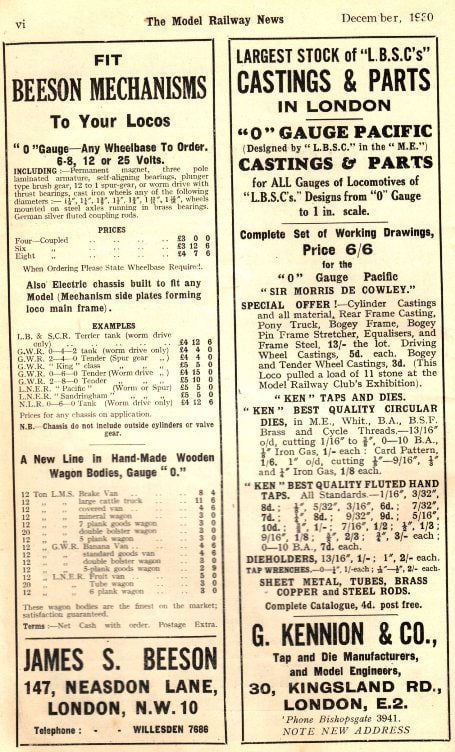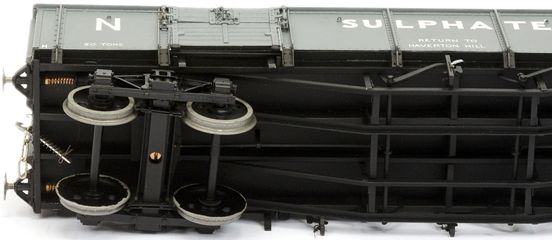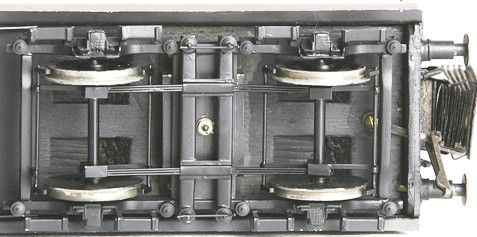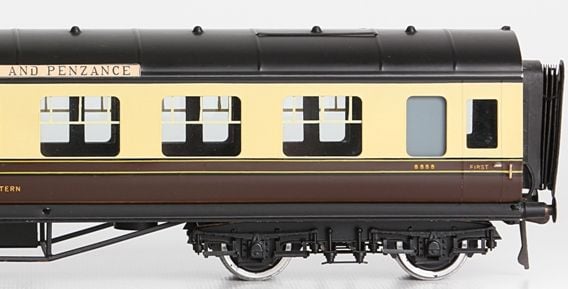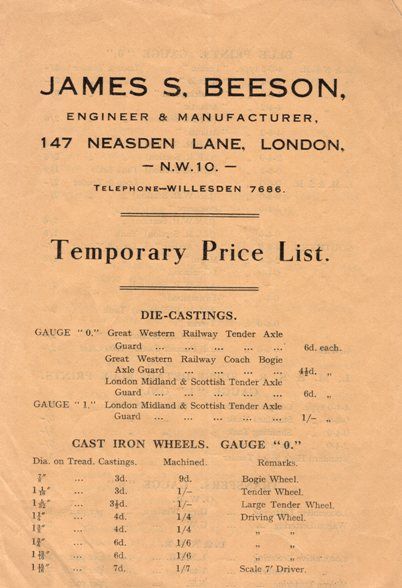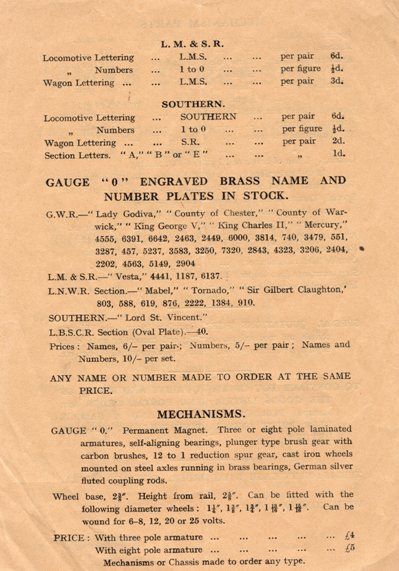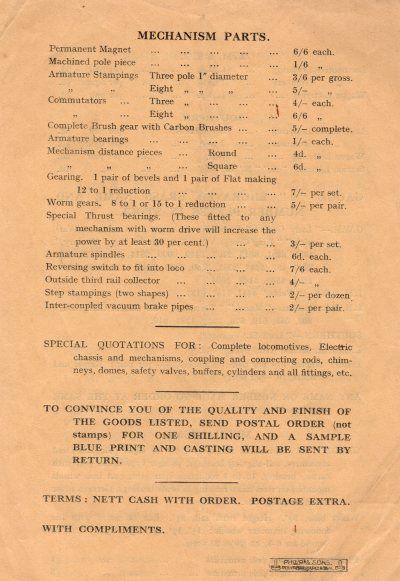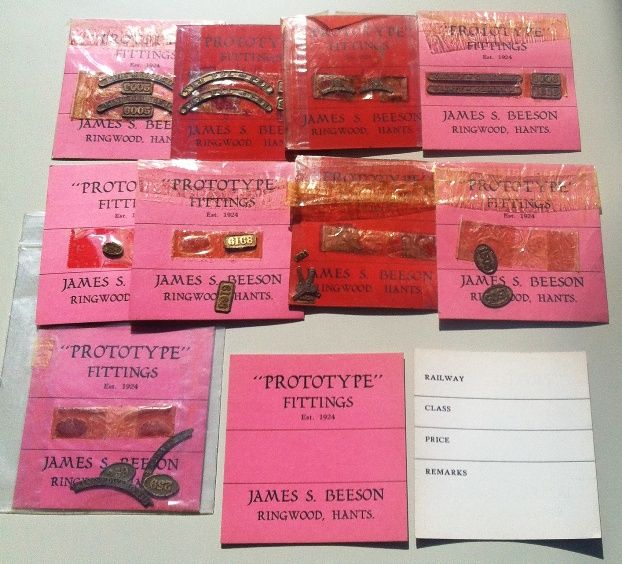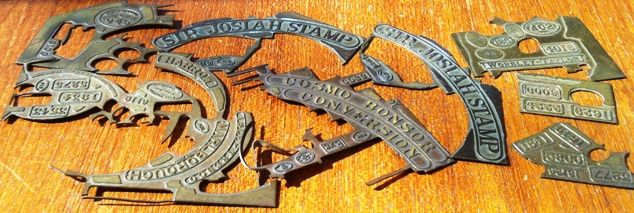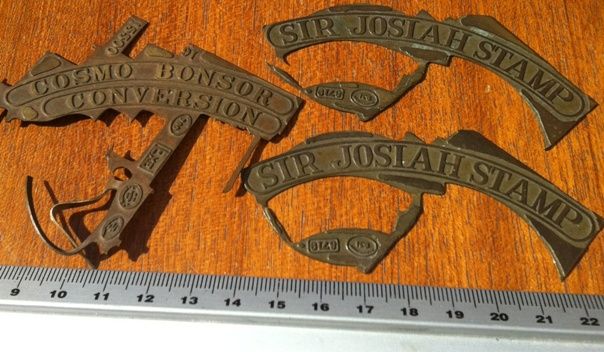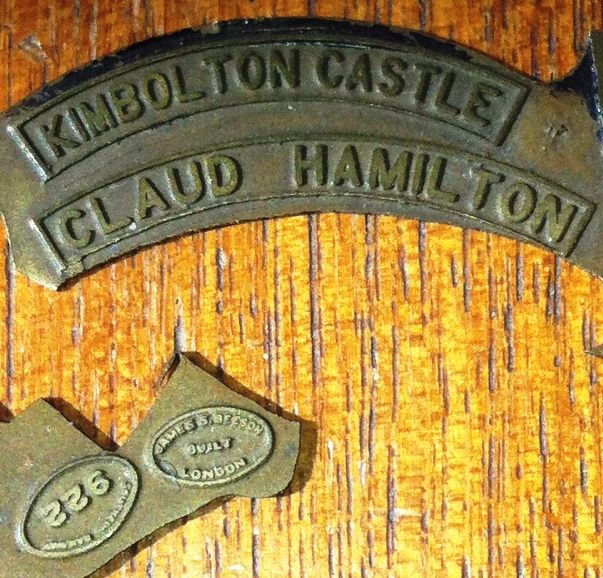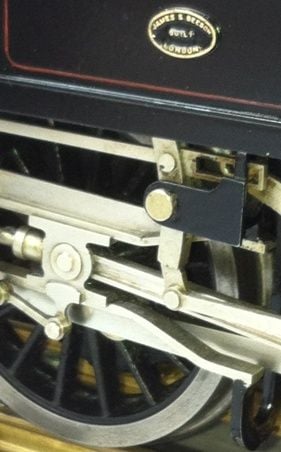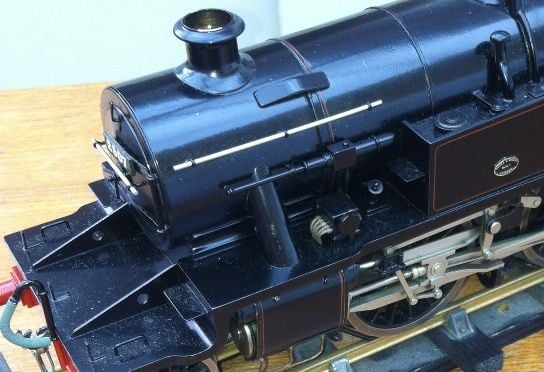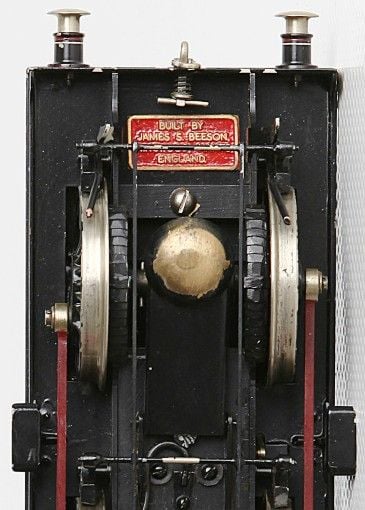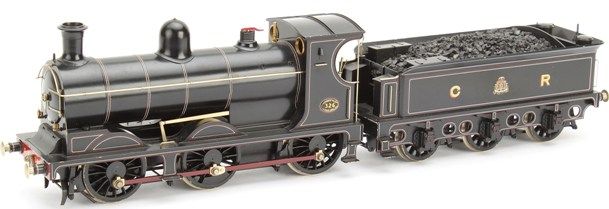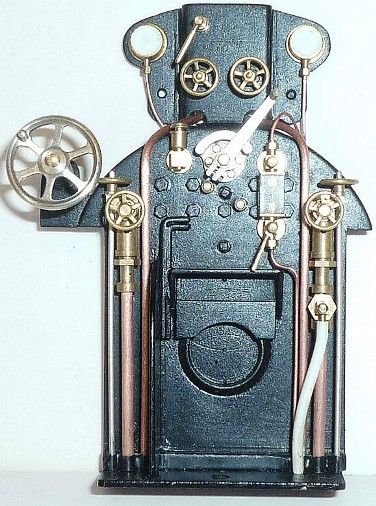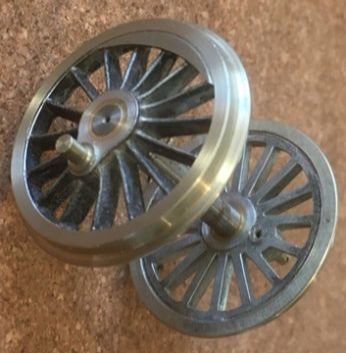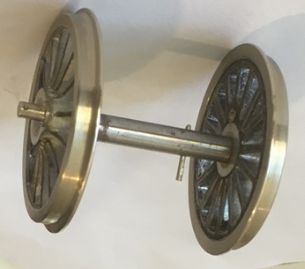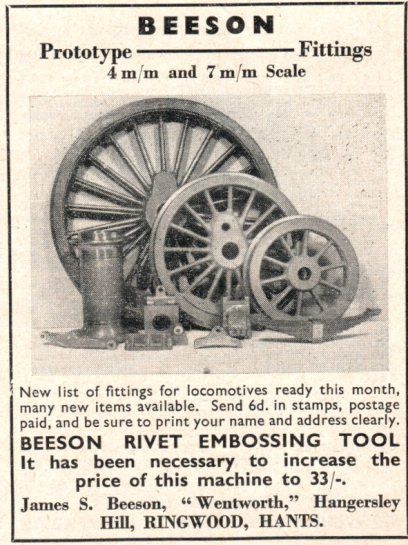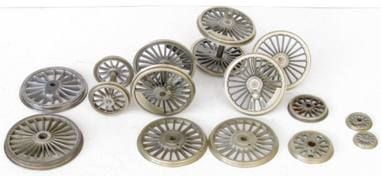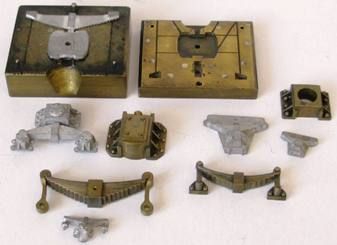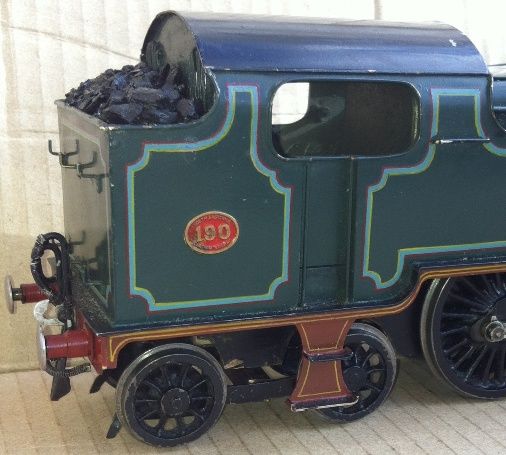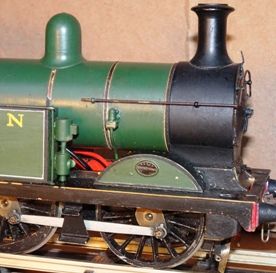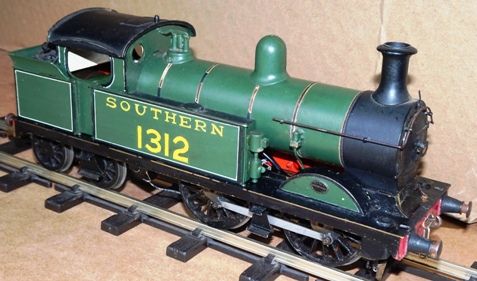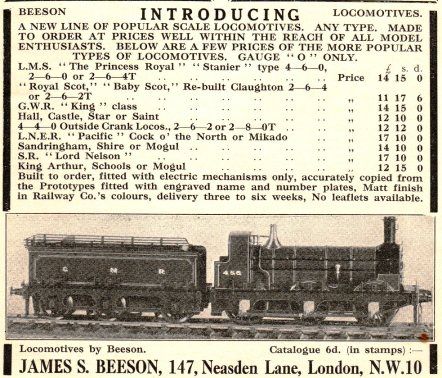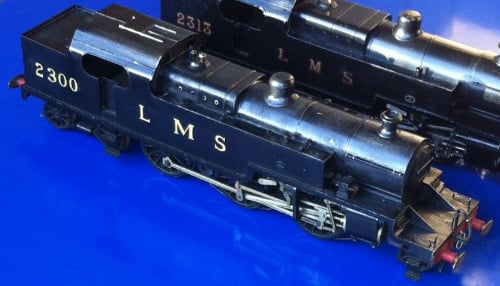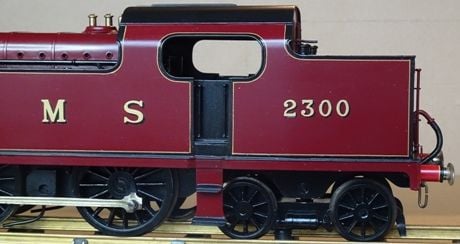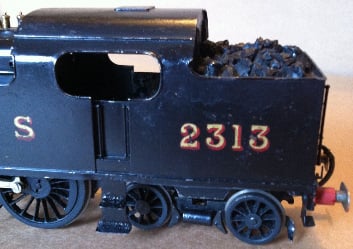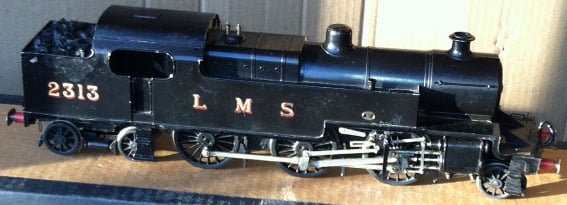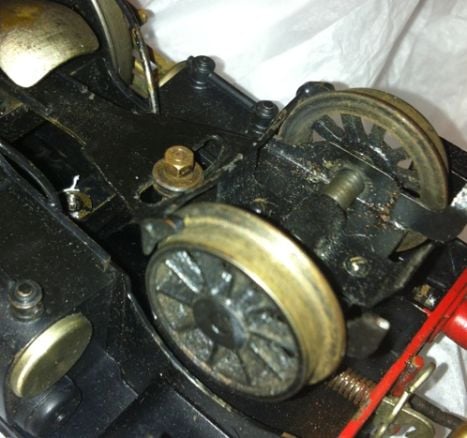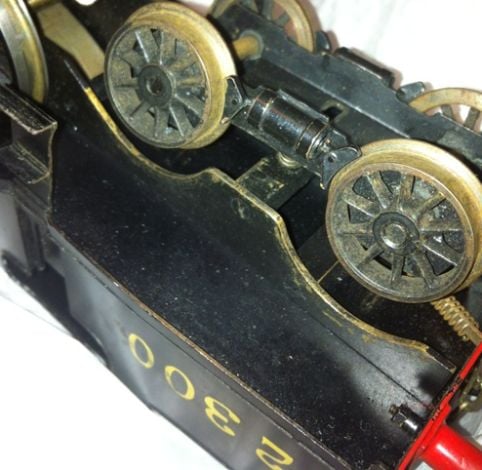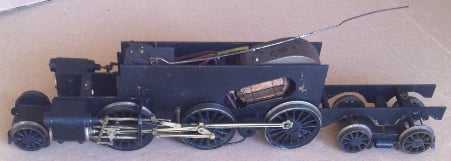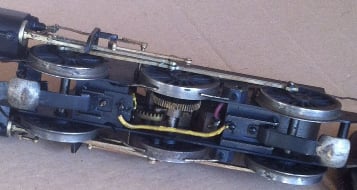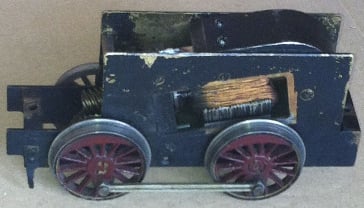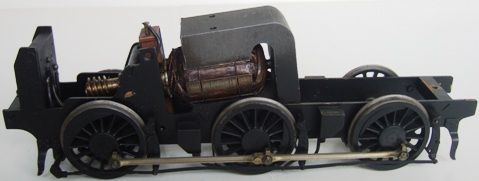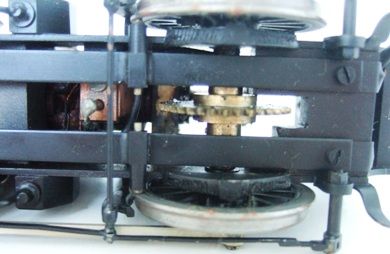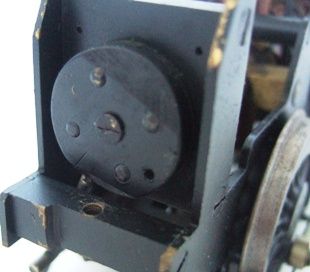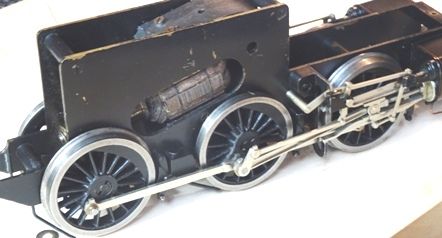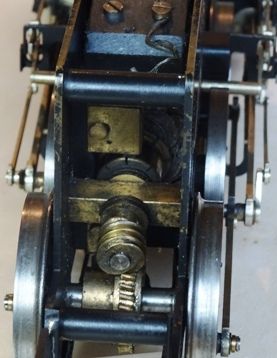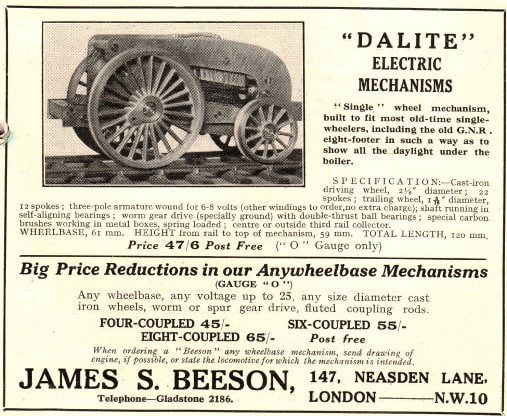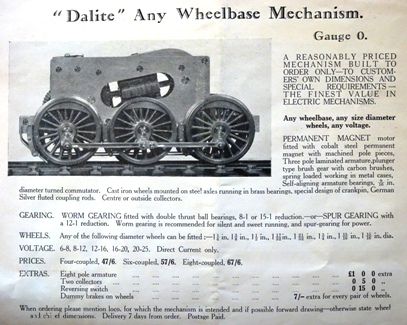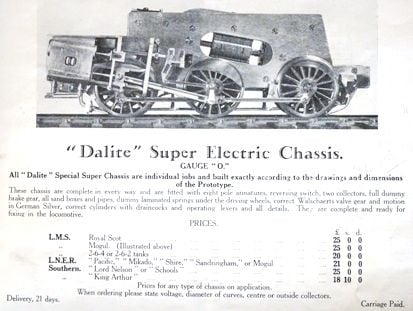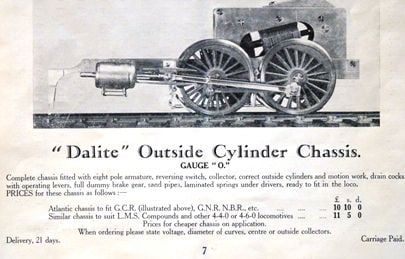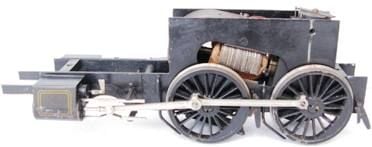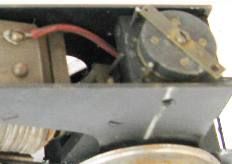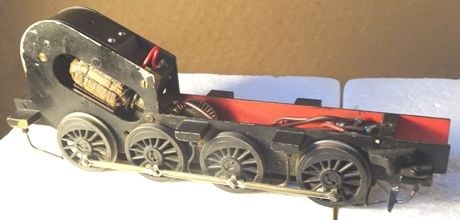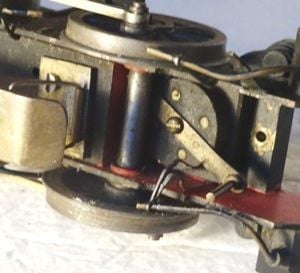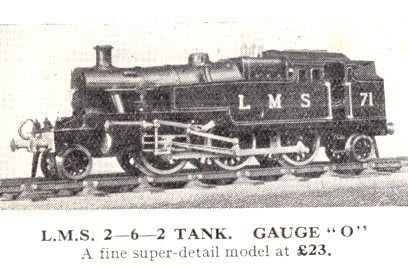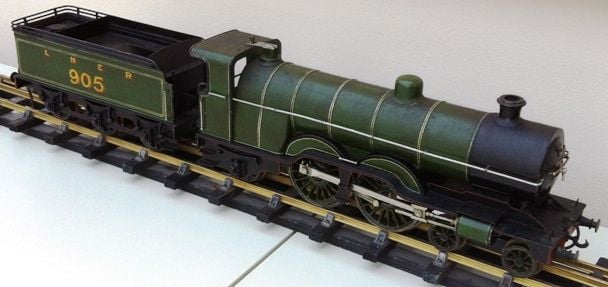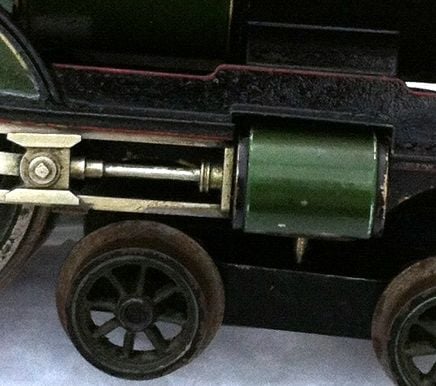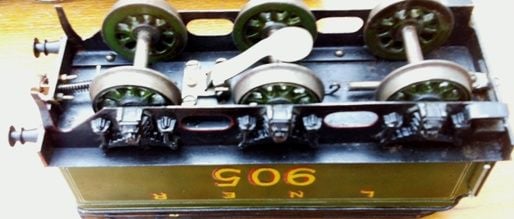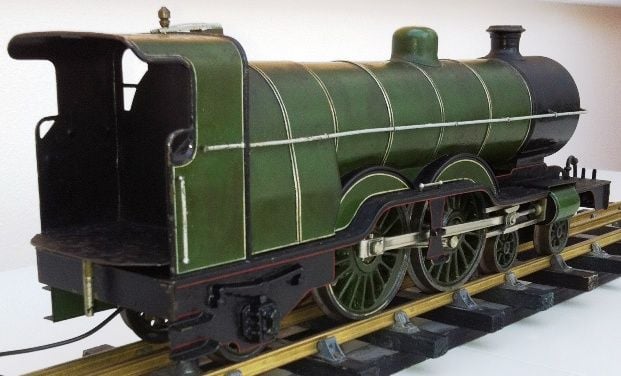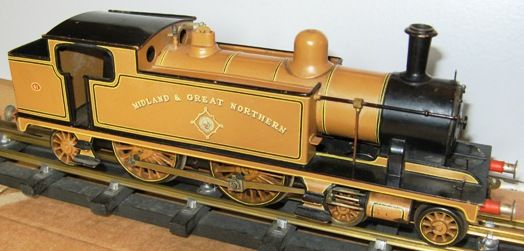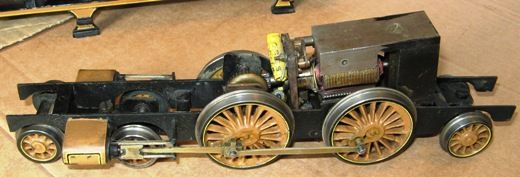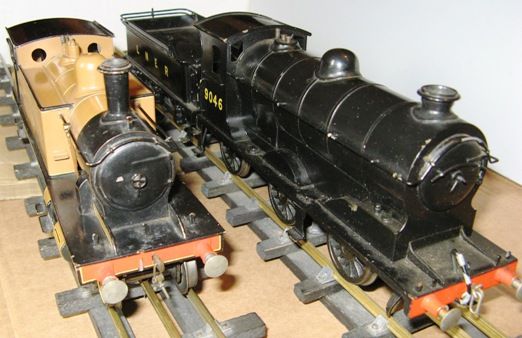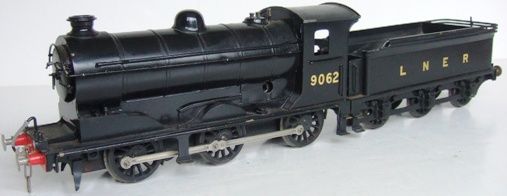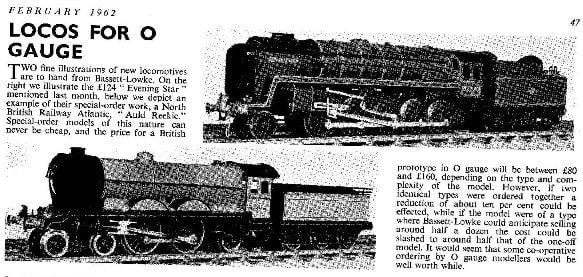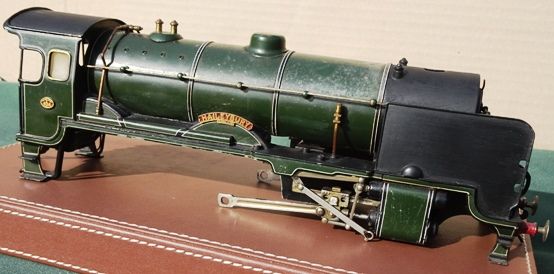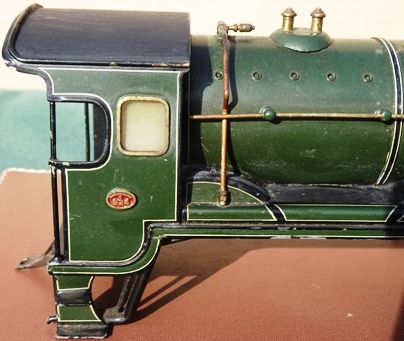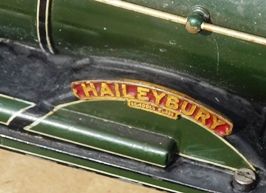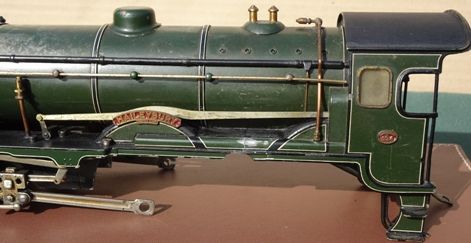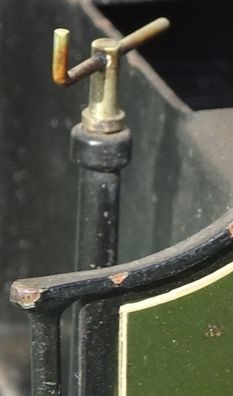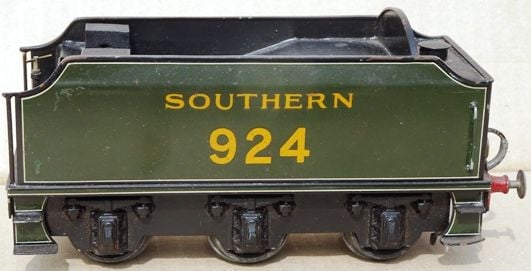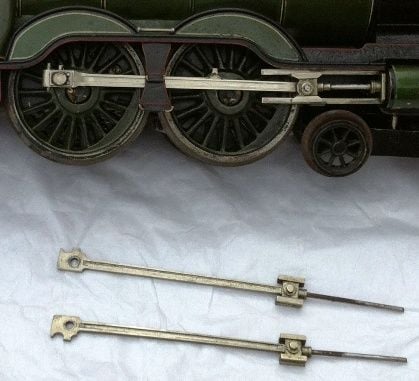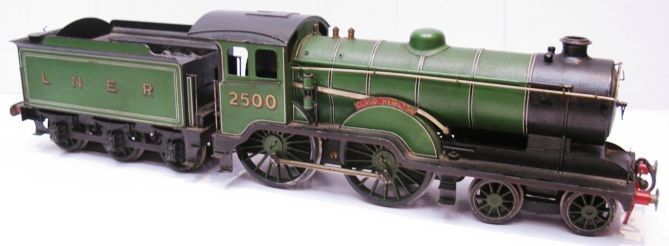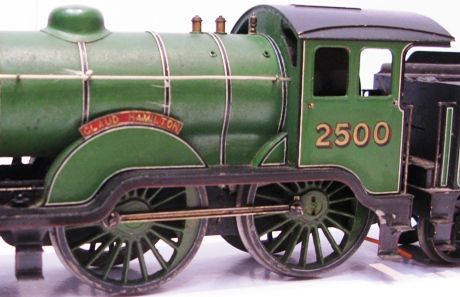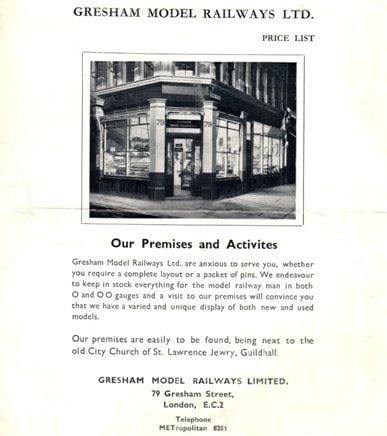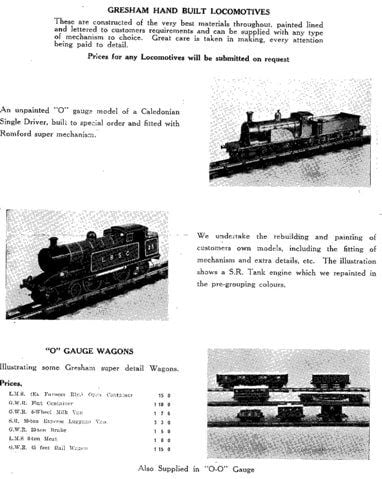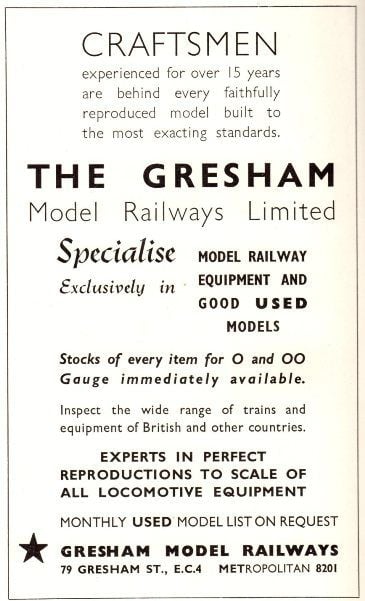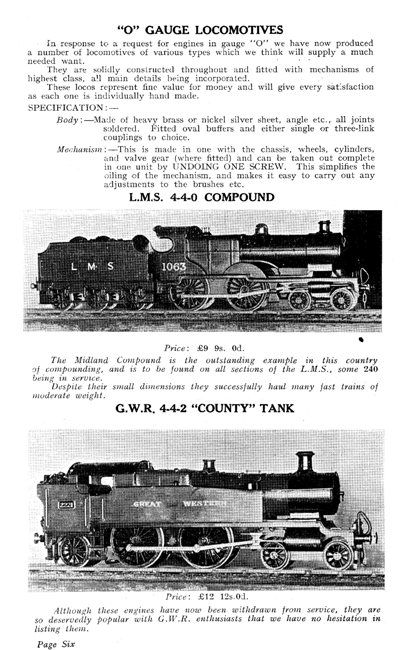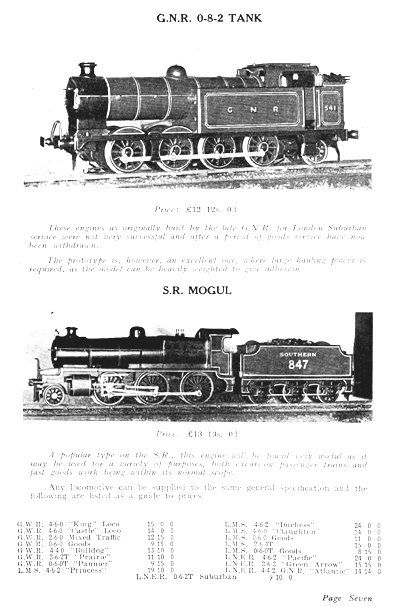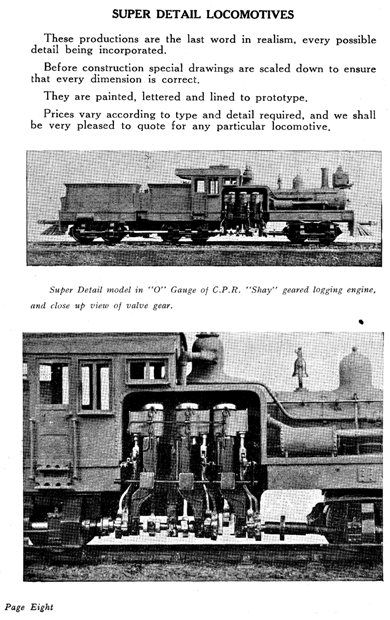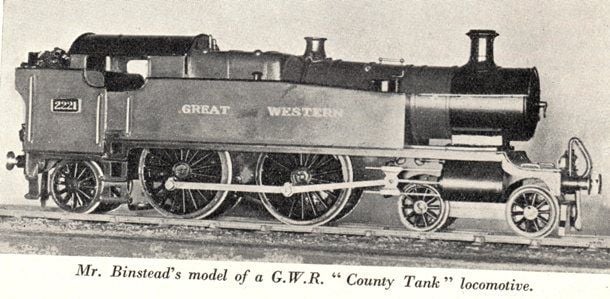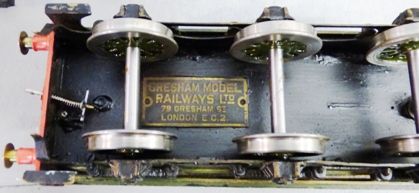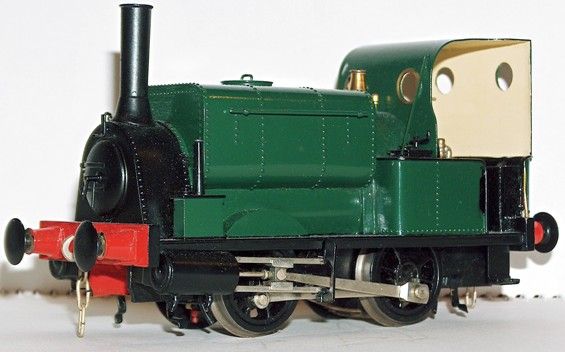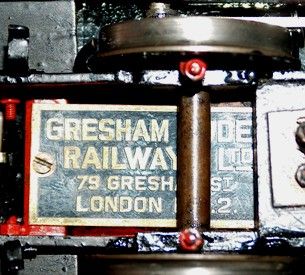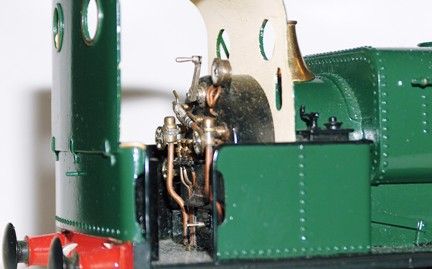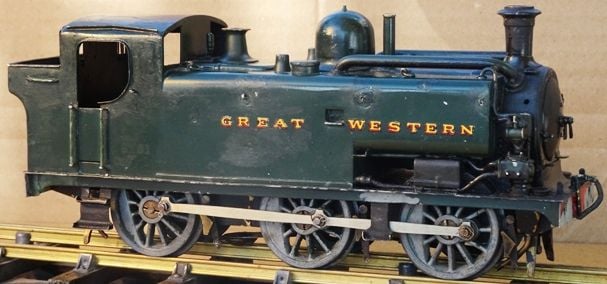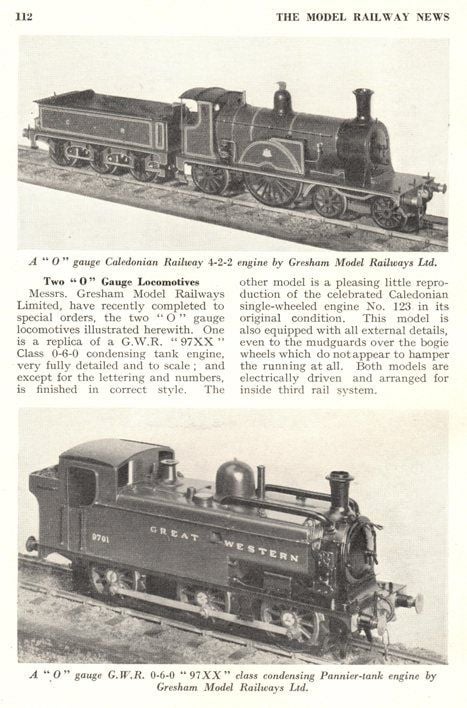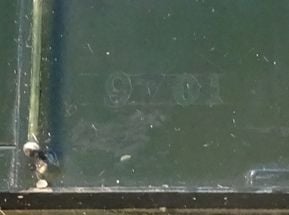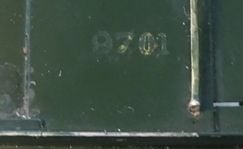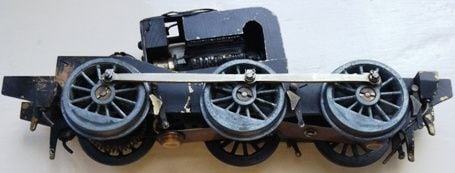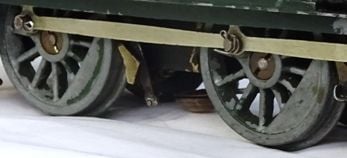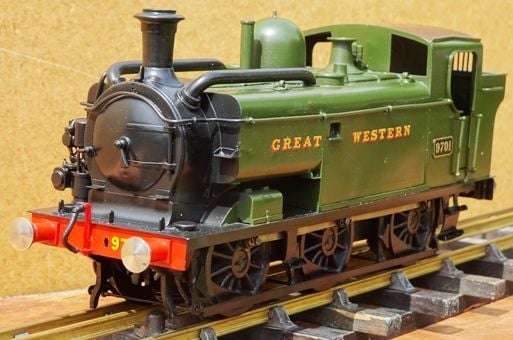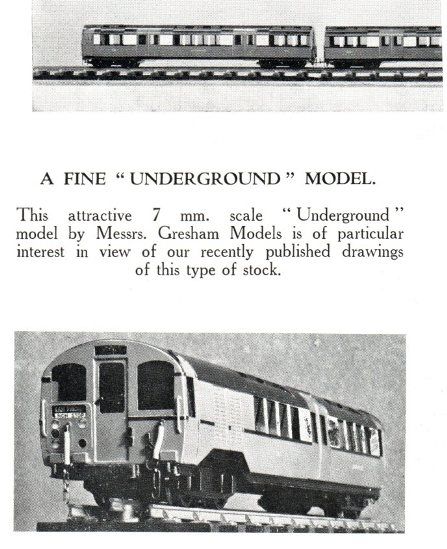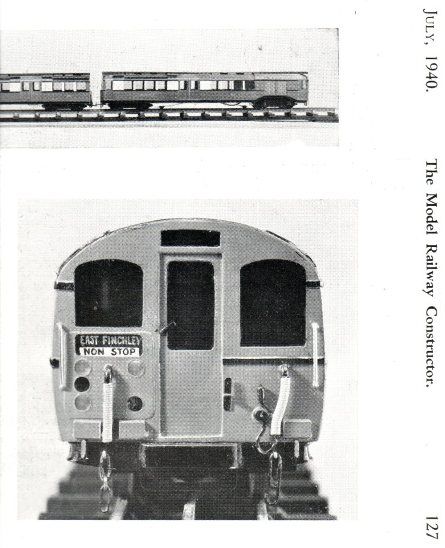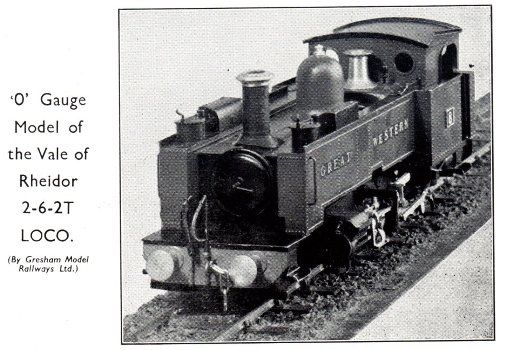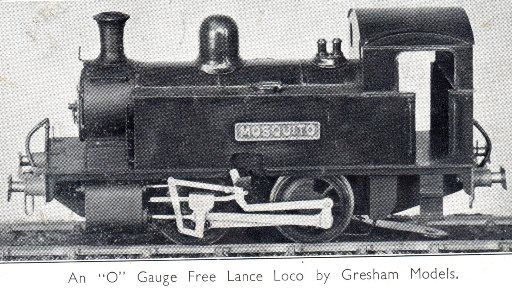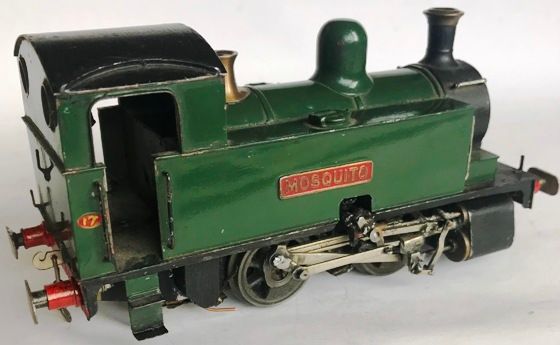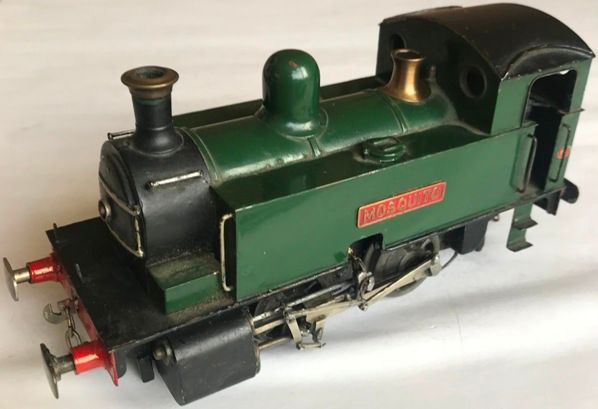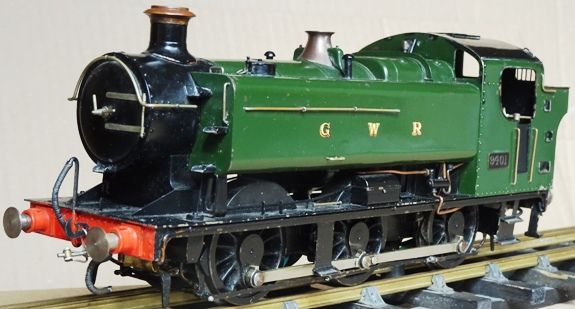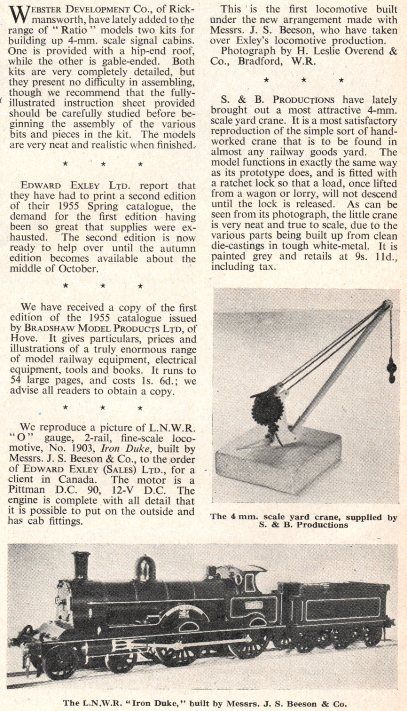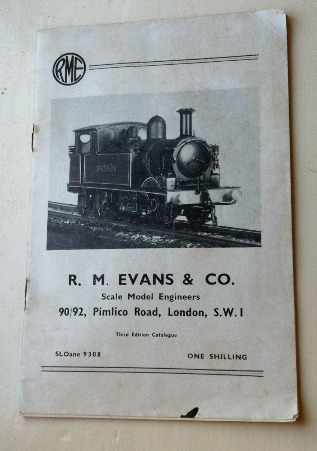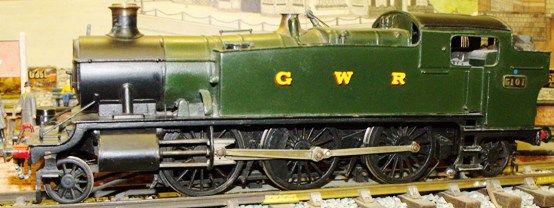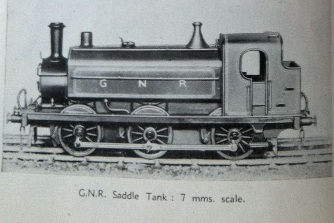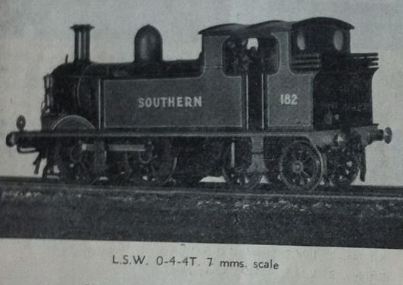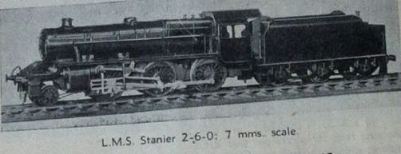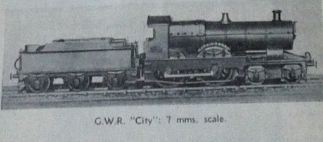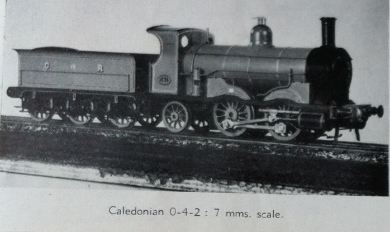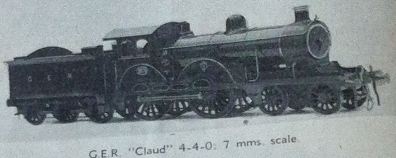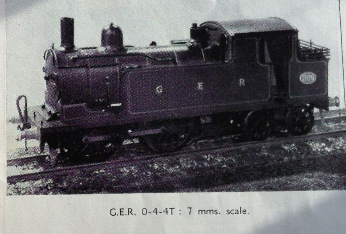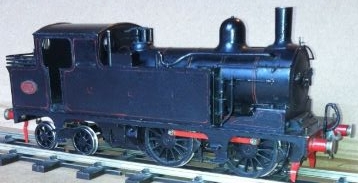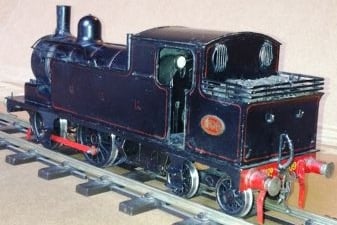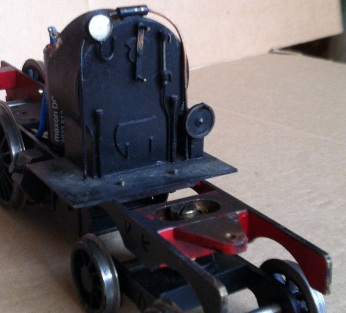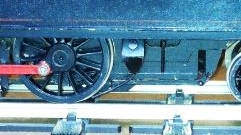
Beeson, Mills & Evans (RME)
..... This section was most recently updated in August 2024 .....
Beeson's earlier 0 gauge locomotives, including Beeson for Bassett-Lowke, Mills, Gresham Models, Exley and Evans Copyright is retained by M.L.Harrison for all text and photos, except for those taken by other owners and enthusiasts. M.L.Harrison 2020 © All rights reserved.
Illustration B1a. A paper slip which may have come with the catalogue shown below, together with Beeson's change of address label.
Introduction J.S.Beeson is generally seen as one of the greatest of the professional model locomotive builders, and the engines he produced are exceptionally well made. His super-detailed models have been illustrated and discussed in depth in various publications, and the locos from his later decades of production have been especially admired. Levy (referenced in full below) refers to Beeson's own view that his work from the 1960s onwards was the most important (p. 193), and the great artistry and engineering skill involved in his fine scale model-making in that period have been widely acknowledged. Locomotives made or rebuilt by Beeson in these later years command very high prices. Less seems to have been reported systematically in the literature about the earlier (and often relatively more simplified) coarse-scale (or perhaps more correctly 'standard scale') engines that Beeson sold either directly or through other retailers. This is despite the numerical significance of the pre-war and early post-war engines as a part of his total output, and their considerable historical interest. As regards the Beeson locos sold through other firms, Ganderton goes so far as to suggest that in the period between the two world wars the "special and production orders from other companies ... provided the backbone of his income." (cited below, p. 22). Since starting work for this review I have several times encountered assumptions or expectations from model railway experts and enthusiasts that a Beeson engine will always be identifiable from its wonderful cab detail, its embossed rivets, its beautiful wheels, and its accurate representation of fine details and fittings. This thinking can be very misleading. I suspect that perhaps there may have been some tendency to 'project' later high standards of representation back in time when dating specific models, so that early dates in the 1930s and even in the 1920s have been considered for a model that has the hall-marks of post-war practice. This is very understandable given the lack of formal records, but in one or two cases may have confused the historical picture. We comment on specific instances below when reviewing the locos of Stewart Law and T. Stanley Harrison. Given the limitations in what is currently covered in the literature or accessible via the internet, this section of our website shows quite a few examples of earlier and relatively plain Beeson models, made before the 1960s. Some later or fully-finescale models will also be mentioned, but the central focus will be on the three-rail ones. As quite a few Beeson locos were probably sold through Milbro, some coverage is in any case necessary to enhance our account of Mills products. At the same time, it may be useful to show a substantial group of Beeson's three-rail locos because his output formed such a significant component of the 'top end' of model loco production during the decades that are of most interest for this website. Certainly, his work featured many times in the model railway press over a long period, and a tank engine made by Beeson for G.P. Keen can be seen in the very first issue of the Model Railway News, in 1925, where the maker was referred to as "Mr. Beeson, Junr." (1, 1, January, p. 5). His father (R.W.G. Beeson) had also been involved in making models, and an example of his work is featured below under our heading, 'A Family Link'. This engine has lining and lettering by J.S.Beeson (see Illustrations B2a-B2f). In effect, J.S.Beeson's 3-rail locos (including those sold under the names of other firms) can help exemplify ongoing and developing best practice within the commercial constraints and customer expectations of the vintage 0 gauge period; when 3-rail coarse-scale running was widespread, when detailing remained modest on most models, and when precise "accuracy to prototype" carried less importance than in subsequent decades. There were certainly some highly-detailed and very exceptional locos made by Beeson before the war and in the 1940s. For example, Ganderton shows an LMS Princess for Bassett-Lowke and an LMS Compound; see Ganderton, pp. 106-107, 114-115. Yet many of his three-rail engines were much simpler. Viewed in their historical context these plainer models remain outstanding for their quality, even though they lack rivet detail or other refinements expected in later years. Pre-war and early post-war models may also provide indicators of the impact commercial pressures had in generating simplifications in the representation of features from full-sized prototypes. For instance, an engine might be sold without any cab detail, or with a highly simplified backhead to meet a cost specification (see example below for R.M.Evans). Going further, some customers might even want models that were 'free-lance' designs, and a builder might be asked to provide them. In writing to The Model Railway News in 1926, Beeson mentioned and illustrated a loco of this kind, alongside two neat but plain-looking engines of more recognisable types (J.S.Beeson,"Three '0' Gauge Locos", letter, 2, 14, February, pp. 55-56). The letter is reproduced below in three parts, and it contains interesting indications of the maker's practices at that time.
Illustrations B1b, B1c and B1d. A letter from Beeson published in The Model Railway News in February 1926. The locos shown are fairly plain, and one is to a free-lance design. Mention is made of the use of tinplate for boilers and other super-structure, of chimneys and boiler mountings "turned from solid brass", and of the use of "Half-round wire" for beading, etc. (See MRN, 2, 14, pages 54-56.)
A family link Beeson's father built models, and Ganderton's book refers to him as an accomplished amateur model engineer (see publications below, page 12). I am grateful to the owner of the model shown now for providing some photographs of it. It is an engine made by R.W.G. Beeson in one of the larger scales. The correspondence included below gives an unusually clear indication of provenance, and of the role J.S.Beeson had played in creating the lining and lettering. It seems that Beeson the master modeller grew up in an environment where engineering skills were well undestood.
Illustrations B2a-B2f. A loco in one of the larger scales, built by J.S.Beeson's father, and with lining and lettering by J.S. Beeson himself.
Beeson's output Through some of the pre-war years Beeson advertised frequently in the model railway press, and when doing so included quite a few pictures of his locomotives. The models look really excellent and very well detailed when compared with what was generally available in the period. Understandably, the majority of Beeson's locos shown in the years before the mid-1930s were probably for three-rail, did not have much (or any) rivet detail, and were not for finescale running. Some of his advertisements were themselves impressive in presentation terms. I would guess that the LNER pacific portrait below must have seemed particularly striking when it appeared in 1932.
Illustration B2h. Beeson's advertisement in The Model Railway News for November 1932; 8, 95, page v.
Illustration B2i. This is another advertisement that I think must have impressed, with its image of a highly attractive model. Even a 'modified' version was £35. One of this class of Beeson engines came to auction in December 2008, but was withdrawn before the day of the sale. Perhaps it was sold privately for a high price, or retained for family reasons. The 2008 sale catalogue illustration showed what looked like a superb model, in black LMS livery. I understand that another 'crab' like that one (although in maroon) was also reported (with images) some years ago, having been expertly improved by its then owner before being sold. I doubt if the one shown in the above advertisement had any representation of rivet detail. In 2023 an auction at Gilding's included another black crab as part of a small group of early Beeson engines, and we show a photo of that model below. We comment again later on the Gilding's locos when referring to the Stewart Law model railway. The crab shown in the advertisement above may well have been a model supplied to Stewart Law in 1932/1933. This advertisement appeared in The Model Railway News, April 1934, 10, 112, p. iii.
Illustration B2j. Many thanks to the owner of this loco for letting me show it here. I think this Beeson model probably dates from the early 1930s, and is similar to the one shown in the advertisement above.
Illustrations B2l and B2m. Beeson seems to have made quite a few freight locos, such as the GWR 2-8-0 and LMS 0-8-0 seen in Model Railway News advertisements here (although large freight locos did not feature very strongly in catalogues from some of the larger mainstream producers). Our scan of the LMS engine has not come out well enough to show things clearly, but interestingly the model has some rivet detail. The 2-8-0 advertisement appeared in April 1931 (see 7, 76, page iv), and the 0-8-0 one in March 1933 (see 9, 99, page v). There is a similar picture of an LMS model included in Beeson's catalogue.
Illustration B2n. This model looks very impressive (although reproduction from the magazine advertisement has not been very successful). This too is from The Model Railway News; see September 1936, 12, 141, page xii.
There seems to be little substantial documentation about the shift Beeson made in his overall production towards two-rail fine-scale super-detailed modelling, other than through accounts of specific locos and their histories. Some published general statements about what was done rely heavily on memories of events or conversations, or later reflections about early practices and dates. Nonetheless, it seems reasonable to say that Beeson's output may well have been quite mixed from the mid-1930s up into the 1950s, with some highly detailed models being made to two-rail or 3-rail standards alongside other sales and commissions for more traditional products. It is clear, however, that by the time a review of two of his locos appeared in the Railway Modeller in October 1960, Beeson was working at a very high level in terms of accuracy to prototype when building models to order for direct sale to customers (see 11, 120, page 247, with pictures of a GWR prairie tank and a BR standard tank). The reviewer mentions rim insulation and flanges on all driving wheels, and notes that the bodies were made entirely of nickel silver. At the same time, however, the maker might well still have been ready to work to different standards when fulfilling commissions for commercial retailers. Beeson also had an additional impact through supplying high quality fittings and components. We include a few pictures below of Beeson loco name and number plates and parts, as reminders of the quality of what was available for other builders. Through the help of a knowledgeable enthusiast for Beeson's work, we are also able to illustrate briefly one of Beeson's wagons and a very rare set of coach bogies. There is then some comment on Beeson's contributions through supplying major loco parts and wheels, undertaking painting work, etc. I should add that I do not have any specialist knowledge or expertise in relation to Beeson's model-making, and am very grateful for the helpful advice I have received about his locomotives from time to time, especially from several valued informants with extensive experience of restoration, repair or building work in the vintage trains field. Collectors and dealers sometimes may be rather partisan about 0 gauge vintage trains in one way or another, but I have frequently found restorers and engineers rather less so. Beeson's advertising in the inter-war years was not always to show the kinds of engines he was offering. As we shall discuss later, Beeson built locos primarily in tinplate in that period (as did quite a few other makers). It is amusing to see how he emphasised his own use of this material in an advertisement from 1931. I suspect this was probably much more about inventive marketing than the challenge he was supposedly responding to.
Illustration B2o. Thanks are due to Jonathan Lewis for alerting me to this advertisement, and for locating another Beeson one shown below about Special Offers that appeared in the same journal issue. (See The Model Railway News, October 1931, 7, 82, page v.)
Beeson's catalogue We will now show the cover and some of the illustrations from Beeson's catalogue, which give a good impression of the kinds of loco models he was making in the late 1920s and early 1930s. My copy is a rather worn one, so the reproductions here are not particularly good, but I hope they are sufficient to show the high quality being aimed for by the maker. Most loco pictures in the catalogue show models without any obvious rivet detail. Some further images from the catalogue will be shown later to illustrate specific things. There is some overlap between the catalogue illustrations and Beeson's individual advertisements in the press. Illustration B3a. Beeson's catalogue is widely known. It contains selective illustrations and an account of what was available (or going to be available) at the time of its publication. Beeson advertised it in The Model Railway News in May 1933 (9, 101, page v); Ganderton puts publication a year earlier (cited below, p. 23). It is not too difficult to find a copy.
Illustrations B3bi-B3bviii. Some of the locos shown in Beeson's catalogue from the early 1930s. An illustration he included of another 0-8-0 is shown later, in our discussion of Stewart Law's models. We also show later some of the mechanisms as illustrated in this catalogue.
Illustrations B3j and B3k. This loco is a Beeson County 4-4-0 that was recently discovered by an enthusiast, and closely matches the catalogue picture reproduced above. I am grateful to the owner for letting me have these two photographs, and others we show later of the mechanism and specific details. The upper photo shows the engine as it now is, with a new pickup added by the present owner. When it was found it still had the original pickup system which seemed to match the catalogued model, and was to enable 'outside third' running. This can be seen in our lower picure. I understand that at time of writing (January 2024) the tender is currently undergoing a full restoration. It seems very likely that this is the catalogued model, and conceivable that it was made for a well-known enthusiast such as Norris.
Illustration B3mi. From this advertisement it looks as if Beeson's engines were very expensive for the early 1930s, when this price list was included in his catalogue. This may be a little misleading, however, as cheaper models were also featured or referred to in some of his 1930s advertising. We discuss and illustrate this issue again later on this page, but highlight two examples now. This is to illustrate what could be offered by Beeson in the 1930s at a relatively low price.
Illustration B3mii. This is from early in the decade, and as well as the prices it is interesting to see reference to a B.L. Junior Permag mech. It is not clear how far general economic conditions were playing a part in Beeson's activities in this period. See The Model Railway News, October 1931, 7,82, page v. Thanks to Jonathan Lewis for alerting me to this advertisement.
Illustration B3miii. An advertisement from The Model Railway News, 12, 142, October 1936, page viii. There is some reflection along the loco body in our image. This offer stands out for its relatively low price. One of these Royal Scots would have directly undercut the Milbro version, which was available for £13-10 shillings in 1935-36. It is difficult to know how Beeson brought his costs down sufficiently to sell at this price, but options could have included using a simpler and cheaper mechanism (and no reversing switch), cheaper fittings (perhaps including soft metal ones), using transfers, and absence of brake gear. The advertisement only refers directly to the use of cheaper wheels (similar to those deployed by Leeds and Milbro). It is hard to be certain exactly what savings were being made, and we cannot be sure whether details on the example shown above would all have appeared on the Royal Scot models that were actually supplied. Perhaps Beeson might also have economised by building these locos in collaboration with another maker or employing his own personnel, or by incorporating mechanisms and even some fittings supplied by another company. In a later section we add further material about his cheaper engines. We show later a Beeson Scot ('Sherwood Forester') that is very likely to be from this period, and has simplified representation for its washout plugs, but nonetheless very good fittings. For that particular loco a link with Exley seems a possibility.
Some other useful publications (readers interested in Beeson will probably already know all these): Amongst useful publications are those below. Coverage on websites has generally been very limited, and that is one reason for providing something on this site about the earlier engines. Ellis, Hamilton, "Model Railways; 1838-1939", Allen & Unwin, London, 1962. [Has some very good photographs opposite page 96 and following page 104.] Ganderton, R.A., "James Stanley Beeson 1906-1990", Faculty Publishing, Poole, 1999. [The largest publication, with many fine photographs.] Harrison,T.S., "Four Gauge 'O' Locomotives", The Model Railway Constructor, November 1945, 12, 140, page 169. [Interesting description and pictures of Beeson engines commissioned by the author.] Levy, A., "A Century of Model Trains", New Cavendish Books, London, third impression, 1978, pages 193-206. [A very valuable chapter.] Levy, A. (ed.), "The Trains on Avenue de Rumine", New Cavendish Books, London, 1982, pages 170-173. [Contains a short J.S. Beeson section presenting four locos that are "mainly from the middle post-war period", 1950-1965; together with pictures of two of these engines hauling Exley coaches.] Model Railway Constructor, "Beeson Model Locomotives at Work - 1", 46, 537, January 1979, pages 20-21; "Beeson Locomotives at Work - 2", 46, 538, February 1979, pages 84-85; "Beeson Locomotives at Work - 3", 46, 539, March 1979, pages 138-141. [Useful illustrations from a large fine-scale layout.] Model Railway News, "The work of a perfectionist; An '0' Gauge Model of L.M.S.R 'Duchess of Montrose' ", 33, 391, July 1957, page 168. [Three good illustrations of a top quality Beeson model, including the complex cab detail. Page 167 of the same issue features a photograph of a model of LNER Pacific 2573; a loco by another maker that had been rebuilt by Beeson as a commission from Exley.] The Model Railway News, "Trade Topics", 26, 303, March 1950, page 50. This shows a Beeson LMS pacific (6234) and LSWR 4-4-0 tender loco. [Beeson parts are discussed, and the range of available 7 mm scale wheels is described. The review noted that the 'centres are die-cast in special alloy which can be soldered', and that they have 'case brass or nickel-silver hubs and cast-iron tyres'. They were available for 3-rail or 2-rail. A die-cast dummy laminated spring with axlebox and hangers had also been produced, to create some 'detail behind the wheel'.] Stewart Law, E., "New Locos for an L.M.S. 'O' Gauge Line", The Model Railway News, July 1933, 9, 103, pages 184-185. [Four good examples of Beeson engines commissioned for a specific three-rail layout that would have been of high status in the coarse/standard-scale era.]
Characteristics and features of the earlier 0 gauge locomotives Beeson locomotives were made over a long time period, were sold through a variety of outlets, and were commissioned against the backcloth of changing commercial environments and developing customer preferences. Bearing these factors in mind, as well as Beeson's considerable capacity for innovation and adaptation, it might be difficult to be certain today about continuities and uniformities in his specific detailed construction and design practices. This note of caution takes on added weight when one considers the very large numbers of engines Beeson is thought to have produced in the coarse-scale era. Dozens of models would probably be needed as an adequate sample to confirm some of his practices accurately and with certainty. Nonetheless, it is generally expected that the 'build quality' found in Beeson models will be outstandingly good, and that the motion, fittings, paintwork and lining will usually be superb. It is also known that the materials used for body-work changed over time. I am informed that loco and tender bodies were generally made of tinplate in the earlier years (although even then nickel silver could be used occasionally by Beeson for a component such as a smokebox door). Then his locos were made of tinplate or of tinplate and nickel silver, and subsequently of nickel silver alone. The shift towards nickel silver was a factor that also affected other model railway engine producers from the late 1930s onwards. A note of caution needs adding here, however, because Beeson would have carried forward into the post-war years any remaining stocks of tinplate loco body parts prepared before the war. Thus they could be made use of later on, as appropriate. A knowledgeable enthusiast has described to me a good example on this; a Beeson Black Five loco he has in BR livery, which is in tinplate rather than nickel despite being a post-war engine. As far as materials used for the most important fittings are concerned, I understand it is unusual to encounter soft metal employed for major components such as chimneys, cylinders or a dome on a Beeson engine, although this can happen (and a relevant example appears below from the cheaper of his pre-war ranges). It would be expected that key items generally would be of brass, but cylinders on locos may incorporate or be made of tinplate (or nickel). These comments do not necessarily apply to items such as axle box covers. Additionally, there are a couple of specific pointers touched on in Ganderton's book, that might sometimes help an initial identification of a possible Beeson model from the three-rail years. Ganderton notes the characteristic style generally adopted by Beeson for engine-to-tender connections when the motor was in the loco (see Ganderton, cited above, p. 22, and the illustration there of 'Sir Menaduke'), although the exact form this took in the pre-1960s models seems to have varied a little. Also, many Beeson locos have small neat wires or pins through the crank pins to hold the coupling rods on. Ganderton notes this on a 1930s GER 2-4-0 featured at pages 120-121 in his book. He writes, "The coupling rods are fluted and the crank pins have cotter pins fitted to retain the rods in place" (p. 120). Of course, the wires through the crank pins might sometimes have been removed from Beeson engines during conversion to two-rail and finer scale running, and perhaps there were periods when they were not used by the maker anyway. Furthermore, a Beeson loco commissioned through another firm might have something different. The literature provides only slim information. It is worth adding, however, that as far as I can tell this method of holding the coupling rods only appears relatively rarely on locos by other makers from the vintage years (for the use of split pins in this context see our section on Milbro locomotives). I have been told that hand rails were commonly held in place by split pins on Beeson locos, rather than by shaped hand-rail knobs, although this probably applied more particularly in Beeson's pre-war and earlier post-war decades. A similar approach may be found on Milbro locos (although for these there may have been some tendency to fix the handrails in a little closer to the loco body), and with various other makers. Some photographs in Ganderton's book feature later models on which more developed fittings can be seen holding the handrails (and we show in this page a GCR tank loco that illustrates this). In December 2023 I noted split pins that seemed to have been systematically enhanced on an early Beeson loco, and this had clearly been done when the model had been made. Neat round 'bases' had been added to make each pin appear more realistic. It seems that a similar approach might have been made on one or two of the engines shown in Beeson's catalogue (including the County 4-4-0 shown above). I have never seen this tactic mentioned anywhere when Beeson was being discussed, but perhaps it proved too time-consuming for him to adopt universally. I do not know whether it was deployed on a large number of models over a substantial perod, or on only a limited number for a short time. Anyway, I have added photos below of details from two locos to show examples of this practice, alongside the picture of the GCR tank loco fittings mentioned above. Several years ago I was also advised that an additional point about loco recognition is that Beeson's marking-out lines can sometimes be seen here and there beneath his paintwork. In some instances I have found quite a few such markings on a Beeson loco from the 3-rail years, and only a minority of items seem to have none at all. To these various possible identifiers we probably should add the point that his hand-painted liveries, lining and letterings are exceptional. With deteriorated eyesight I have to use magnification to appreciate fully the work that Beeson put into these. Many of the earlier Beeson models do not have any representation of rivet detail, or perhaps only have a limited amount. It seems to be generally understood, however, that when rivets are represented by Beeson they usually look beautifully neat. Ganderton discusses Beeson's approach to this, and gives an excellent account of Beeson's rivet embossing tool, and of how it was used to achieve very accurate results (see pages 72 and 74). It does not seem clear, however, when Beeson started to use this embossing tool. I am not at all expert on the histories here, but as far as I can tell there is relatively little evidence at all in the pre-war advertising to suggest any preoccupation in those years with reproducing rivet detail. No doubt Beeson would provide it in the earlier periods if requested, and would have charged a substantial extra sum for doing it. On the other hand, reports about specific locos (apparently based on recollections as well as provenances) do indicate that some superb Beeson models were built in the later 1930s with very extensive reproductions of rivets. If that is correct (which it certainly seems to be), then presumably he will have been using the device or something similar at that time. It seems that Beeson claimed in mid-1950s advertising that he had been using his rivet tool in his own modelling work for twenty years. This was in the context, however, of making an offer to sell customers a rivet embossing tool like his own. In the absence of more evidence, it seems probable that Beeson began to deploy his rivet embossing techniques systematically on his more expensive commissions some time in the middle years or second half of the 1930s. This leaves open the possibility that a few 1920s/1930s Beeson models that have rivets today did not have them when made (although an upgrade of that kind would have been troublesome, and I've never been shown any direct evidence for it). It also points to a possible contrast with Bernard Miller's practices in the pre-war years. Miller seems to have been trying to incorporate some rivet detail a bit earlier, and indeed at one point in the early 1930s offered rivetted smokebox wrappers as a means for enthusiasts to upgrade their own models. In our section about Miller and Miller Swan, we tentatively suggest that Miller nonetheless compromised on many of his pre-war models by representing rivets in the smokebox area but not necessarily everywhere else. He also seems to have made some models in his earliest period without representing rivets. Identification of UK vintage loco models in some cases can be very difficult, and in the case of potential Beeson models there are complicating factors. These include his involvement in supplying parts and fittings for other makers, the modifications, additions and refurbishments made to his earlier models in later periods, and attempts by other builders to follow in his path. There has also been some repainting of his models. We touch upon these issues later. As well as the engines that Beeson built and sold, there are certainly other models where (directly or indirectly) he could be said to have had a hand or influence in their production.
A few illustrations of Beeson's work (most of the locos shown are 3-rail models, or were originally for 3-rail when built)
Illustrations B4a and B4b. A 3-rail LMS 2-6-4 Stanier tank loco by Beeson. I understand that this loco is made primarily of tinplate. It was repaired and repainted by the highly-regarded restorer Simon Greenwood, in 2007. Further pictures of this model are shown below in Illustrations B12a and B12b, and its mechanism appears in Illustrations B18e and B18f. Apparently the first ten (full-sized) engines of this class were built by the LMS with straight sides to their coal bunker tops, as on this model (see Haresnape, B., "Stanier Locomotives; a pictorial history", Ian Allan, London, 1981 edition, pp. 52-53).
(This loco has some good rivet detail at the front, but not elsewhere.)
(Nice detailed representation here too.)
Illustrations B4c-B4f. A 5700 class pannier tank for three-rail running, currently fitted with a skate pickup. Given the long life of this class and its significance for GW enthusiasts, it is probable that Beeson made quite a few of these. This one would most likely have been produced in the 1940s or 1950s. It has been fitted with a large Romford mechanism, but my guess is that this was not put in when the model was built, but was a later replacement for something else. The paintwork on the hidden underside of the body has been stripped completely, and I cannot be certain of the origin of the wheels. Conceivably the loco might have had some cab detail when made, but a large box shape containing the rear of the Romford motor currently occupies the front of the cab space. Nonetheless, I think this is a really excellent model with nice detail. This particular Beeson engine is something of a 'transition' example, being made of nickel silver but for three-rail. It includes very good rivet detail, but only at the front (see above). There is also quite a lot of metalwork below the tanks, to 'box in ' and conceal the mechanism, as was frequently the case with such models before the war. N.B. When this loco came up in auction, there was substantial erosion and on-going loss of paint on parts of the body. At time of writing (August 2024) parts of the green paintwork on the body have been renovated, but these areas need further tidying. The model had also lost its front and rear couplings, the fitting from the top of its dome, and the fittings from below the tanks on each side immediately in front of the cab. These losses have all been addressed, with adapted injector castings from the 'Reynalds Range' used as replacements for the latter. There is still one broken fitting to be repaired, and some small areas which have lost their black paint .
Illustrations B5a-B5c. Many thanks to the owner of these three LMS locos for making their portraits available for this site. The Royal Scot 4-6-0 shown here is a Beeson three-rail model that was made in 'war-time' black. It has not been altered by the adding of detail (which has sometimes happened with the earlier locos), but has been repainted expertly. The illustration usefully shows the engine-to-tender connection (cf the picture of a Beeson for Mills Jubilee shown below). We refer to another Royal Scot model later on this page. The Compound 4-4-0 dates from the early 1930s, and appears to be in original condition apart from very minor damage and a changed pickup arrangement. It features again later on this page when the Stewart Law layout is being discussed. I am informed that this LMS 'Jinty' tank was initially built for 3-rail by Beeson, and then converted by him for 2-rail running in the 1940s. The chassis was also subsequently rebuilt by the maker. The Compound and Jinty both have brake gear. It is useful to note this Jinty's cabside number, 7667, which it carries also on its smokebox door. It seems quite likely that this was Beeson's standard numberplate for an engine of this class over a substantial period. This is indicated by the picture of a different Jinty with the same number that is shown in the 1945 article by T. Stanley Harrison included in our publications list above. See later on this page for a reproduction of that photograph. We also show there a third jinty, probably made originally for 3-rail, but subsequently re-built for 2-rail and repainted in BR livery. Although most likely made in the late 1930s or 1940s, that model has rivet detail.
Illustrations B6a and B6b. Beeson Great Eastern Railway 0-4-4 S44 Class tank loco (LNER G4). Although the surface of the paintwork on the sides of this engine has deteriorated badly, and the GER lettering has been eroded, the model nonetheless has quite a lot in common with two Beeson Great Eastern locos shown in Ganderton's book (cited above) and built in the 1930s. Page 14 of that book shows a 2-4-2 tank, and page 120 shows a tinplate 2-4-0 tender loco. One of these was apparently converted to fine scale, and the other also appears to have been set up for fine-scale two-rail running. They appear in excellent condition, albeit perhaps relatively plain-looking locos (see caption for the 2-4-0 on page 120). Whereas the G4 is in plain black, both those in the book seem to be in GE dark blue livery, with black-painted smokeboxes and cream or white cab roofs. As far as I can tell from internet sources, this seems correct to prototype, so I am not sure why the 0-4-4 above is all in black. Its paint looks original, so the livery may have been requested when the loco was commissioned, or perhaps just the roof was changed from a lighter colour at some stage. One option now would be to have it part-repainted and re-lettered This 0-4-4 tank loco is believed to be by Beeson for Evans (see sub-section below on R.M.Evans for fuller comment and more photos). It was built for three-rail running but converted later to two-rail and given a new mechanism, wheels, etc. I am not sure whether the bogie is original or a later one. When acquired the engine had lost some of its small fittings near the front, possibly partly because a large weight had been pushed into the smokebox and the front of the boiler. Perhaps one reason for putting the weight there was to help balance the engine on the track, at the time when the original mechanism and wheels were being replaced with more modern and lighter items. Alan Crompton - a highly skilled restorer - created some new parts to replace those that had been lost, so nothing is now missing! In my view this loco is an excellent example of a small engine from the 'top end' of commercial 3-rail model-making in the late 1930s/1940s.
Illustrations B7a-B7d. These photographs offer some illustration of Beeson's painting, lining and lettering, demonstrating his mastery in the creation of artwork. The loco is a tinplate Caledonian 4-4-0 tender engine that was originally a three-rail model. One of its previous owners had it rebuilt and re-wheeled for two-rail fine-scale running and given a modern motor, this work apparently being undertaken in the mid-nineties by Brian Broumpton. It seems that amongst its earlier owners had been the well-known enthusiast, modeller and expert Vic Reader. The model came up for auction on Ebay in 2014. There has been some very minor damage or alteration to metal framing below the main bodywork, and some low quality renovation of small patches where paintwork previously had been eroded. The paint thus needs tidying here and there. The loco would also benefit from some nicer wheels. These things apart, it seems generally to be in excellent condition. Although the owner who had it rebuilt apparently had been told it was a very early Beeson model, it is harder to date the engine now because the original mechanism and wheels have been removed. My guess, however, is that it was probably made before the second world war. There is substantial metalwork inside the cab, designed to 'box in' the original motor, and perhaps this might fit with the model being from the pre-war years (and possibly even an item commissioned through one of Beeson's commercial customers such as Milbro). A small point of interest is the use that Beeson made on this loco of some relatively modest 'standard' fittings to represent washout plugs, just as he did on the first of the Claud Hamilton locos that are shown later below. Ganderton's book (cited above) contains many illustrations of locomotives with beautiful paintwork and lining.
Illustrations B7e-B7j. Continuing the theme of Caledonian paintwork and lining, these pictures show an unusual model that I think Beeson probably played a major part in producing, or may well have built. The loco was converted by a previous owner from 3-rail to 2-rail running, and was given modern number plates that I am informed are truer-to-prototype. The original plates are shown above along with the (removed) outside-third pickup, which is clearly professionally made. I have so far been unable to examine and discuss this model properly with expert contacts/advisors, due to the impact of restrictions associated with the virus. Nonetheless, it seems to me that some of the detailing is exceptional for a three-rail engine, while the paintwork, lining, lettering and crest conform closely with those on the 4-4-0 shown above (and as far as I can tell with what appears in Ganderton's book). The lining may not all be in its original state, and the red panel on the front buffer beam has been repainted (perhaps because the loco's number has been changed), but not much else has been altered externally in recent periods apart from the wheels, crank pins and number plates. I do not think the coupling rods and connecting rods are necessarily Beeson's. Their construction does not follow what seems to have been Beeson's most common practice, as each is fluted on one side only. While Beeson did make some models where coupling rods were like that, this was probably predominantly in his earlier period (as well as perhaps also on some of his pre-war range of cheaper versions). In addition, the coupling rods above do not look very refined. One possible explanation is that they were made by or for Mills or Exley. Perhaps this model was commissioned from Beeson as a 'high end' special order by Exley, although it is impossible to be sure without more evidence. The loco has been given a modern can motor by its previous owner, and apparently had previously been fitted with a Bond's one, but it is unclear if that earlier motor was what the engine had when new, and I cannot even be certain that the chassis is necessarily original. Some of the lead weighting inside the body may have been added by an owner rather than being there from the start, but that is unclear. I cannot at present guess the age of the model, although deterioration of the surface of one of its works plates (on the side of the smokebox) indicates it has had use over a longish period. Two minor fittings are missing, but could be replaced readily. Our next four pictures show a model of a Great Central 4-6-2 tank built for 2-rail finescale running. It came from a group of GCR 0 gauge locos supplied by more than one maker for a specific enthusiast, most likely in the early 1960s. It seems that Beeson made two of the locos, one being the engine shown here. This 4-6-2 illustrates Beeson's 'artwork' with a different livery, to set alongside the Caledonian models shown above. I am not at all expert, but (to me at least) the painting for the lettering and crest on this loco seemed quite exceptional when viewed with magnification. An enthusiast with considerable knowledge of artwork and painting - John Robinson - studied the livery on this engine and made some systematic checks against the GCR stencil shown in Ganderton's book. He reported a close match. Unfortunately, it seems that this model was not treated well in its earlier days. Problems include damage to the interior metalwork and loss of cab fittings, poor renovation of some of the black paint, altered and missing sandboxes, and a repair that has misaligned some of the metalwork holding the coal above the bunker. It is hoped these things can be put right in due course.
Illustrations B7m-B7o. As far as I can tell, the model shown here represents this class of Great Central 4-6-2 tank loco in its earliest form. The loco seems to have been made by Beeson in the early 1960s, and has some features not usually found on his earlier engines. One detail is that more developed fittings (rather than split pins) are used in most places on this model to hold the handrails (see close-up below). As regards livery, I hope this loco can provide an effective contrast to the Caledonian engines shown above. I think that Beeson's hand-painted lettering and crests are very impressive here, although it can take magnification to appreciate what he has done. The model needs some attention, as it has not been treated very well in earlier years, and a change of motor seems to have involved significant damage. Unfortunately, my photos have not captured the green colour very consistently.
Illustration B7p. Some 'later period' Beeson engines shown in Ganderton's book seem to have more developed handrail knobs than the split pin type that Beeson used in earlier days. On this model most of these fittings are like the one seen on the left here (although the shorter one needed on the right is in this case possibly still made from a split pin).
Illustrations B7q and B7r. These photos show some handrail knobs on two Beeson locos from the early 1930s; an LMS 7F freight loco, and a GWR County 4-4-0 tender loco. On these models the maker seems to have systematically fashioned or fitted round 'bases' for the knobs (which seem to be made of split pins in line with his standard approach in that period). The bases were probably made from small brass washers or something similar. The colour of the paint of the County is not well represented in this close-up, but the aim is simply to illustrate the detail. We show further pictures of the 7F model below, and also some more photos of details from the County. Two pictures of the County were shown earlier.
Quite a few of Beeson's earlier models have been professionally altered or 'rejuvenated' very successfully in later years. Sometimes this was by the maker himself, but other skilled modellers have also played a part. The GWR 4-4-0 loco below looks to have been made by Beeson in the 1930s, but seems subsequently to have undergone several changes, perhaps at different times. It has been converted for two-rail running, been given Beeson cab detail that it might not necessarily have had when made, has had some modest 'internal detail' added, has had one of its backhead fittings replaced with a modern casting, and has been repainted (together with its tender) by a top-rank painter. Most recently, some minor repairs and improvements were carried out by a master restorer (including the repainting of the front buffer beam). This model was one of two Beeson GWR engines that came up together at auction, and had been given similar treatment. The other was an Aberdare 2-6-0, also made of tinplate, converted for finescale two-rail running, and repainted.
(Since the above photograph was taken, some small repairs have been commissioned here; see extra photo below.)
Illustrations B8a-B8e. This GWR 4-4-0 is a very well-made tinplate loco that started out as a 3-rail model, but was converted later for two-rail finescale running (perhaps by its then owner). The driving wheels on one side of the engine have been altered and given modern plunger pickups near their rims. The loco has wires/pins through the crank-pins, split pins to hold the handrails, a Beeson-style engine-to-tender connection, attractive fittings, an excellent backhead, and some neat marking out lines under its paint. When I first encountered this model, the wires through the crank-pins seemed to be longer replacements for what would have been neater originals. This change had most likely resulted from removing Beeson's pins in order to take off the wheels for alteration. Since then, an expert restorer has tidied them up. It can be seen that a section of metal platework 'drops down' from the boiler behind the front splasher. Perhaps this may have been to conceal a more traditional type of motor unit than the can motor the engine now has, and - taken in conjunction with the tinplate bodywork and the limited representation of rivet detail - it confirms the likely age of the model. For more comment on changes made during this engine's history, see our text immediately above the photographs. Expert advice on paintwork has suggested that this loco and the Aberdare 2-6-0 discussed below were both repainted at some point in the relatively recent past by the well-known and highly respected painter Alan Brackenborough.
Illustration B8f. This is a second picture of the cab detail on the model shown immediately above. Since the other picture was taken, one of the cab roof corners has been straightened where it had been very slightly bent, and the original lever/handle has been fixed back at the bottom of the picture.
Illustration B8h. Backhead detailing from another GWR loco - an Aberdare - that is also by Beeson. This tinplate model came from the same collection as the 4-4-0 GWR engine above, and (like that 4-4-0) had been through several changes over the years. The fall plate and wooden flooring in the cab seem to be relatively late additions, perhaps by or for the then owner. The seats in the cab move.
Illustration B8i. An external view of the cab of this engine, giving a reminder of how much Beeson's GWR number plates could improve the look of an 0 gauge model.
Illustration B8j. The tender from the tinplate 'Aberdare' 2-6-0 loco (which has been refurbished and updated by conversion to 2-rail finescale running). The tender lettering has been repainted superbly by hand, and I have been advised that the paintwork (and the replacement boiler bands on the loco) can be attributed to the master craftsman Alan Brackenborough (who is widely respected in UK railway modelling). The model is being restored, and I cannot currently obtain a picture of the full engine.
Illustrations B9ai and B9aii. Many thanks to the owner of this superb LMS pacific for letting me show these photographs. I understand that the loco was one of a batch made in 1936, and later belonged to a famous international model railway collection. It was a 3-rail model, but was later converted to two-rail (apparently by Beeson himself), after it had been purchased by an enthusiast in the UK. The picture of the cab interior illustrates the impressive detailing that Beeson created on his most expensive engines, while extensive rivet work can be seen in the first image. The owner has explained that the original reversing switch/lever fitting can be seen here, below the body. Peter Bishop has advised me that the cab hand-wheels made by Beeson were originally solid, and then seem to have had "three drilled holes between boss and rim to give the impression of spokes". This description seems applicable for the above loco, made in the second half of the 1930s. Peter explains that later on Beeson made hand-wheels with "five proper spokes like the real thing". See below, Illustration B12e, for what seems to be an example with the latter type. These insights from him are potentially invaluable when trying to date a specific engine that has cab detail, although I think that Beeson may have continued using solid wheels inside some tank engine cabs for economy reasons up until the late 1930s and early post-war years. I am grateful to the enthusiast who sent me the next three photos, illustrating a Beeson LMS 4F from the Gilding's auction group mentioned earlier. The cab detail below includes hand-wheels that seem to have been treated in a rather similar fashion to those on the Princess shown above.
(Note the similar approach to creating hand-wheels for the cab detailing [cf Illustration B9aii above], this time apparently with four drilled holes rather than three.)
Illustrations B9bi-B9biii. An excellent loco model that dates most likely from the middle or second half of the 1930s. It has extensive rivet detail and a generally high standard of representation, although the 'drop-down' vertical plate below the boiler in front of the firebox indicates its period. It also has a Beeson reversing switch/lever. Many thanks to the enthusiast who has provided these photos.
The next two loco models shown here were featured amongst those in Levy's book, 'A Century of Model Trains' (Levy, A., New Cavendish Books, London, 1978; see pages 196-197). I understand that they were in a museum in Australia until recently, and were then auctioned in 2023). I am very grateful to the present owner for these photographs. Levy indicates that these engines were made circa 1939 and circa 1936, and that both were later refurbished. As far as I can tell, although built for three-rail they seem to have been displayed without their pickups at the time of Levy's photos, and at that time were perhaps fixed in position for display (although I cannot be sure). I am not expert enough to comment authoritatively on the convincing backheads shown below, but wonder whether these were added when the refurbishment took place, along with the planked floor in the J39 cab, and some of the exterior detailing. Levy gives 1971 as the date of the J39's refurbishment. The cab detail can be compared with that in Illustration B9aii above.
Illustrations B9c-B9i. Two 3-rail LNER engines built to excellent standards by Beeson in the 1930s. They were apparently refurbished later; the J39 in 1971 and the Sandringham most likely at around the same time. It looks as if some fine fittings were added at that time. Many thanks to the enthusiast who sent me these pictures. Our notes above say a little more about the history.
Illustrations B9l and B9m. Thanks also to the enthusiast who has sent me these pictures. I understand that this model of a GWR prairie tank was built as a two-rail loco in the finescale era. It thus lies in a slightly different category from most of the models shown so far. The loco is a very handsome example of Beeson's work, and his mastery in creating rivet detail can be seen immediately. Quite a few 0 gauge enthusiasts have run or collected models made for 3-rail along with others set up for 2-rail. In the first picture here the loco stands amongst 3-rail track, and alongside a vintage engine shed.
Illustration B10a1. Beeson LMS Fowler 0 gauge 2-6-4 tank, fitted with a 3-rail 'Dalite' electric chassis, and probably made in the early 1930s for the E. Stewart Law layout. This tinplate loco would have been regarded as a 'super detail' rather than 'cheaper model' when made (even though it has no rivet detail or backhead, and does not have the 'refinements' of a modern 0 gauge finescale engine). It is compared with a less expensive Beeson model from the same locomotive class in a later part of this website section. Photographs of the mechanism are shown below in Illustrations B17a and B17b; this would have been 'top of the line' in its period, and is large enough to project slightly into the cab. The loco is in good condition, although as seen here the model had been repainted black (some time ago), and brake gear parts have been lost below the body. It is hard to fault this tank engine as far as quality of construction goes, and it captures very well the style and 'look' of the handsome Fowler engines. In 2020/2021, some time after the above photo was taken, investigation by an expert painter revealed evidence of an original coat of paint (under the black) that appeared to have been red/maroon. This would have represented the Crimson Lake livery that was applied by the LMS to the full-sized 2300 and some other members of its class early in their deployment (for a picture see Haresnape, B., "Railway Liveries - London Midland and Scottish Railway", Ian Allan, London, 1983, page 15). The model has now been returned to that livery by a full repaint. Illustration B10a2. The same model after a superb restoration repaint in Beeson style by the master painter Warren Haywood. The small numerals seen in this image were carried by the first 25 locos of this class early on in their service with the LMS (see Booth, J.,"The LMS 2-6-4 Ts", Locomotives Illustrated 47, Ian Allan, 1986, page 9). With 2300 this seems to have been while it was in its lined maroon livery. Illustration B10a3. After this engine had been repainted I found a reference to the power classification number and have added it to the model. I'm not sure exactly what it should be like (!), but hoping this transfer is OK. With shaky hands and poor eyesight I was lucky to get it on safely ! For additional images of this model see Illustrations B15a-B15g below.
Some comments on Beeson's early models (pre-1934), and those supplied to E. Stewart Law A Beeson Fowler tank model very like the one above appeared in The Model Railway News in July 1933. It was shown with three other Beeson engines for an article about the LMS 0 gauge railway of E. Stewart Law, who felt it was a delightful model (9, 103, pages 184-185). The article's photographs are reproduced below, although unfortunately neither the magazine's originals nor my reproductions are of good enough quality to provide full information. It seems highly likely that the loco pictured above is the one included in that article, albeit without all its original brake gear. Certainly, there are very close similarities on distinctive modelling features. What looks like a wire to operate Beeson's reversing switch can be seen passing through the cab in the 1933 photograph shown immediately below, and this matches the wire seen in our illustration later of the mechanism from 2300 (see B17a). The sand box seen between the centre and rear driving wheels on Law's model appears to be secured by a large and very visible bolt of the kind that has been used (rather crudely) on the loco shown above. The washout plug detailing seen above (which is very slightly irregular on the visible side) matches that on the magazine photo, the smokebox front/door is simplified rather than prototypical both on our model and the magazine image, and the point below the body where the rear centre-rail pickup meets the track seems exactly the same for both engines. At the very least, if our example is not the engine in the 1933 illustration, then it will have been made as part of the same batch and in the same period. If anyone knows more about the Stewart Law Beeson LMS Fowler tank I would be glad to hear from them.
Illustration B10b. Fowler loco made for E. Stewart Law, as presented in the July 1933 Model Railway News. The full-sized 2300 carried small numerals (like those represented here) early on in its service with the LMS, and had received them when painted in Crimson Lake livery. It is hard to see evidence on Law's model of the lining applied with that livery at the time, but the best assumption is that it was lost in the photograhy or magazine printing. Considering when it was commissioned, it would be unlikely for this model to have been in black livery, especially with the small numerals. It is amusing to find that Haresnape (cited above) refers to a photo of a full-sized black Fowler tank loco where the pre-war film had "failed to render" the lining, although it had been there (page 23). Perhaps this was not uncommon with photographs at the time. Although in his 1933 article the model's then owner commended two other photos printed alongside this one, he did not offer a similar compliment for the picture above. Not only is the image we have tried to reproduce here nearly ninety years old at time of writing, but it seems to have been very poor to start with. The original photography, lighting or printing distorted the appearance of the cab roof (generating an illusion of extra 'rain strips' that the full-sized locos did not have). It is also not easy to see exactly what fittings there may have been on the footplate above the cylinder, although something there (probably a lubricator) seems to have generated a specific shadow effect. Neither can the works plate be located until one knows where to look. These issues apart, there is an extremely close match between this model and the one shown above at B10a1 and B10a2.
Stewart Law's railway ran on Bassett-Lowke "Popular scale permanent way" at 12 volts, and used three-rail track with a centre rail (see his article, "A Gauge 'O' LMS Electric Model Railway", in The Model Railway News of May 1932; 8, 89, pages 115-120). His second (1933) article indicates that the Beeson Royal Scot class model shown in our reproduced magazine picture below could travel at speed round a 3 foot radius curve (page 184). It is consistent with the type of railway this was that the Fowler tank would have been commissioned with flangeless centre drivers (like those on the model in Illustrations B10a1-B10a2). Stewart Law explained in his writings that he was replacing his Bassett-Lowke super-detailed locos with Beeson ones. It is not clear what the B/L models were like, and perhaps quite likely that Beeson had had a hand in their production (especially given the loco numbers they carried). In any event, the enthusiast was aiming to have an identifiable Beeson example of most of the 'standard' LMS loco classes, several of which had recently been built or were still being completed in the early 1930s. In late 2023 an auction by Gilding's offered four LMS engines that were all Beeson models from the 1930s; a 'crab' 2-6-0, a compound 4-4-0, a 4F 0-6-0, and a 7F 0-8-0 freight loco. Some pictures of these have been shown earlier on this page. The 7F had suffered two substantial dents to the body and other minor mishaps but was otherwise in good order. As far as I could tell from the images, the other three models all looked in tolerably good condition. The 4F was most likely made later than the others, as it had extensive rivet detail. All four had been fitted with skate pickups, probably quite a few years after they were made (and perhaps after the war). There seemed to be a striking similarity between the compound and the one shown in Stewart Law's 1933 MRN article image (see below), and I believe (subject to further information) that the Gilding's compound model is very probably the Stewart Law one. It is also possible that the 7F came originally from the Stewart Law layout too, as he owned one by Beeson that carried the same number (although see below for comments on numberplates), and the auctioned engine had been made to early 1930s standards. However, as it lacks brake gear there is room for doubt. We will show this model now. As can be seen it lacks rivet detail, and it also has Beeson's reversing switch under the body. The four central driving wheels are all flangeless.
Illustrations B10bi-B10biv. A 1930s Beeson LMS 7F freight loco, that conceivably might be the one referred to by Stewart Law in his article of May 1932 (MRN; see text above for full reference). It is similar to another 7F featured in Beeson's catalogue (see photo below), but there are minor differences and the one shown here lacks brake detail. We have noted earlier the unusual approach adopted for the handrail knobs on this model. The mechanism and reversing switch/lever are shown later on this page. The model we have photographed here has sustained some damage, including the loss of one of the small fittings on its smokebox door, and the loss of both front steps. The tender looks to be of the 'standard type' made by Beeson in the early 1930s to run with compound, 'crab' , 4F and Royal Scot models.
Illustration B10bv. This picture of a 7F loco was included in Beeson's catalogue in the early 1930s. It is very similar to the model for which we have shown four images above, but not exactly the same, and the catalogued example has brake gear. It is possible that the engine featured in the catalogue (rather than the one we have photographed above it) was the loco supplied to Stewart Law, although the one without brake gear came up for sale alongside what I believe is Stewart Law's compound. It is worth noting that an Exley 7F is pictured at page 166 in Edward Beal's book, 'Scale Railway Modelling To-day' (A & C Black, London, 1939). It looks rather like the Beeson ones, and has slotted wheel centre fittings as Beeson engines from this period do. The Exley one might possibly have been supplied by Beeson, although the photograph is not good enough to be sure. We should add that it is very important to appreciate that a loco's number cannot necessarily be a conclusive clue about the date or origin of a Beeson model, as the maker sometimes used the same numberplates for successive models over longish periods of time. For example - as readers can see - he certainly produced at least two early 7F locos with the number 9500, and there were probably several more. Stewart Law also had a 4F with the same number as the one in the Gilding's sale, but his was almost certainly without rivet detail. The re-use of the same loco numberplates on successive models has led to confusions. In particular, Ganderton's coverage of Beeson presents a superbly-illustrated review of a fine LMS compound loco linked in the Ganderton book to the same Stewart Law model railway (see Ganderton, cited above, at pages 114-115). That super-detailed compound - number 1187 - bears the same number as the one in the 1933 Model Railway News article (see illustration below), but the link made in the Ganderton book is not convincing. Comparing the MRN illustration of LMS 4-4-0 1187 with Ganderton's photographs suggests significant differences; even though that model was apparently returned to Beeson in the 1960s to be "upgraded to fine scale" (page 115). In contrast, the Gilding's model seems a much better fit for Law's engine (and we include pictures of it below). Ganderton's book also refers to an LMS 2P as having been made in 1928, although it has extensive rivet detail and working inside valve gear and connecting rods, and seems closely to match an engine reported much later, in November 1945 (see below). The number is different (and was most likely changed when the 1945 model was refurbished by Beeson in 1981; see pages 158-159), and perhaps that may have caused the apparent confusion. Although I am by no means expert, it seems that some of the datings offered in the book also represent cab detail as having been from earlier periods than looks likely, and maybe this again could have been affected by reliance on numberplates. There is however a more fundamental point to make. Many Beeson engines have been modified over the decades since they were made, and we might expect to find examples of enhanced detailing and renewed paintwork as well as conversion to two-rail fine-scale running. This should not obscure the fact that earlier models were often very plain, even though beautifully made (and prestigious for their period). Beeson's catalogue indicates that the absence of rivet detail had been up to that point the norm, since as far as I can tell from the pictures there were no visible rivets on almost all the engines he used therein for illustration purposes. Cab detail was also probably much rarer in the first half of the 1930s, and in some cases differed from what was done later.
Illustration B10c. Stewart Law's Beeson Scot. He noted it had "scale size bogie wheels", but would travel at speed around a three foot radius curve. He felt this was "a great achievement by Mr. Beeson", a very reasonable comment in the model railway context of the period.
Illustration B10ci. A picture showing some detail on another early Royal Scot model by Beeson. The fittings have not all shown up well in the magazine photo, but almost certainly would have been similar to those seen here on 6112. This model, however, has the later angled top to its smoke deflectors, and larger numerals. I have no expertise about the history of this class of engines, but it seems that the full-sized Sherwood Forester was built in 1927, and would have initially carried its name without a regimental crest above it. I do not know when the regimental crest seen here was added on the full-sized locomotive, but the engine had a naming ceremony at Derby in June 1933. Anyway, my assumption is that this model of 6112 will have been supplied a little later in the 1930s than the Stewart Law one. Some minor economies may have been made when Beeson built this version of Sherwood Forester, and for a number of reasons I believe it was possibly sold through Exley. It was converted to two-rail in later years in a rather rough manner, probably while part of the Simpson collection, and was also altered and damaged somewhat in other minor ways (see our Home Page). It is awaiting renovation.
Illustration B10cii. Sherwood Forester's tender. This has some minor variations from the 7F one, and a piece of wire is missing!
Illustration B10d. The magazine's picture of Stewart Law's compound, No.1187, captured poorly the appearance of the chimney (perhaps as an effect of the lighting), and I think my reproduction unfortunately has made it look even worse! This model looks different in the magazine picture from one shown in the book about Beeson by Ganderton, although they carry the same number. That writer reports that Beeson converted the above engine in the post-war years for fine-scale running, but massive enhancement of the detail would have been necessary to make it look like the Ganderton loco. See comments in the text above and additional discussion below.
Illustrations B10di-B10diii. This loco was shown earlier on this page, but we include it again now because of the apparently very close match with the MRN's 1933 image of Stewart Law's LMS compound. It is hard to be absolutely certain that the two are identical, especially as the published magazine image is of very poor quality. Also, of course, Beeson may have made several closely similar compounds at this time. Nonetheless, the similarity is striking enough for me to guess that they are indeed the same model. Certainly, this seems a better 'fit' than the one suggested in Ganderton's book. The loco has features probably fairly typical from Beeson at this time, including the plain cab interior (with the characteristic 'post' to pull the tender), the handsome fittings, the standard tender type, a reversing switch, and the absence of rivet detail. We are grateful to the present owner for providing these illuminating images. A previous owner had fitted this model and the 7F shown here with skate pickups, although they would have initially had standard Beeson collectors like the Fowler tank above.
Illustration B10e. Stewart Law's impressive jinty tank loco. No. 16564 was "low geared for shunting". I hope to make a better version of this reproduction when time allows, as it has slightly distorted the loco's front end. Some more models Illustration B10f. I am grateful to the then owner of this model for sending me some pictures of it. This beautiful LMS 0-6-0 tank would not have carried the BR livery when made, but in any event it provides a good updated version to set alongside the early 1930s three-rail one shown immediately above. No. 47671 has substantial rivet detail and a modern 'look', but nonetheless quite a lot in common with the Stewart Law model, and a mechanism that seems to have its design origins in the pre-war era (see below). In fact this model might well have been made in the vintage 3-rail period, possibly in the mid- or late 1930s or the 1940s. In summer 2024 I reviewed the paintwork and BR livery of this model in company with two other enthusiasts, and we concluded that the repaint was most likely carried out by Beeson himself. We could not be sure whether or not he also helped with or made the changes to 2-rail, etc., although that was also a posibility.
Illustrations B10g and B10h. The mechanism and the cab area detail. The pin going through the crank pin can be seen in the lower picture here. This model is fitted with Beeson's reversing switch. We show some more images of this mechanism later, as Illustrations B18b-B18d.
Illustrations B10hi-B10hiii. Some more photographs of the BR-liveried jinty tank. The cab detail has been simplified by Beeson to save time and costs, but nonetheless conveys a very good impression when seen from outside the loco. Some of the fittings inside the cab could suggest a 1930s model, so the rivet detail probably indicates a relatively costly one for its period. As can be seen, Beeson constructed the backhead so that it could be removed in conjunction with other metalwork.
Illustration B10hiv. This image is from the article by T.Stanley Harrison published in The Model Railway Constructor in November 1945 (12,140, pages 168-169). We refer to that journal piece below, and show the author's text and the other three pictures of his models. This Jinty carries the number 7667, and my guess is that this was a number that Beeson had used on models of this class for a while before 1945. The same numberplate may well have been fitted to the Jinty we show above, before it was repainted as a BR model. The LMS engine here is very like the model we have photographed above, but seems to have been for 2-rail from the outset. I have been advised that the one in BR livery seems likely to have started out as a three-rail loco, albeit an expensive one. In any event, they share many features.
As we noted above, Ganderton's coverage of Beeson presents a superbly-illustrated review of a fine LMS compound loco linked in the book to the Stewart Law model railway that we have discussed above (see Ganderton, cited above, at pages 114-115). As already noted, that super-detailed 4-4-0 - Number 1187 - bears the same number as the one in the 1933 Model Railway News article. Comparing the MRN illustration of LMS 4-4-0 1187 with Ganderton's photographs, however, suggests significant differences. This is so even if allowing for the fact that the model was apparently returned to Beeson in the 1960s to be "upgraded to fine scale" (page 115). On the other hand, a Beeson compound shown in the important 1945 T.S.Harrison article (and also numbered 1187) seems to be very much more like the one shown in the book, and I think it likely the Ganderton images are of this later compound rather than the 1932/1933 one. We have indicated already that when appropriate Beeson used the same numberplates on different models from the same class, thus saving time and cost. Four engines running to finescale two-rail standards were described in this piece by T. Stanley Harrison. We have shown one (a Jinty) immediately above, and the other three illustrations are included below along with his comments. I am very grateful to Jonathan Lewis for alerting me to this journal piece. It also seems very possible that the 2P 4-4-0 featured at pages 158-159 in Ganderton's book is the one shown below, albeit as subsequently refurbished (and renumbered) in 1981.
Illustrations B10i-B10l. Although our reproduction of these photos is not by any means perfect, the picture of this model of 1187 nonetheless shows clearly that the super-detailing by this period could include complex rivet detail. There is naturally quite a contrast with older engines from the early 1930s (including the Stewart Law compound pictured earlier). Many thanks to Jonathan Lewis for his help on this article. See The Model Railway Constructor, November 1945, 12, 140, page 169. Note also the above reference by the enthusiast to Beeson's adoption of nickel silver tyres for his wheels.
Rolling stock, etc. As well as making locomotives, Beeson is known to have produced a small number of very fine wagons. He also advertised wagon bodies for sale early in his career as a model-maker, but I cannot tell whether these were made by him or simply sold by him as a retailer, and I have not so far seen any pictures of them. Ganderton offers an explanation about their possible origin (see page 23), connecting them with the production of items for Keen's K Lines railway.
Illustration B10m. An advertisement from 1930, including an offer of hand-made wooden wagon bodies for gauge 0 (see The Model Railway News, December 1930, 6, 72, p. vi). The availability of a variety of mechanisms is also a useful indicator of Beeson's output and versatility (and we refer to mechanisms at more length later). As far as complete models are concerned, Ganderton reports that before World War Two (probably in the late 1930s) Beeson made six 7mm LNER bogie ballast wagons, three twelve-wheeled bogie well wagons, and one sulphate vehicle (for discussion and photographs see Ganderton, cited above, pages 162-165). An enthusiast has let me have photos of an impressive sulphate wagon that matches very closely the one featured by Ganderton, and it seems that three of these wagons were in fact made (with successive numbers). The same person has also sent me pictures of very rare Beeson coach bogies (or bogies supplied by Beeson) fitted to an Exley coach (see below; also Ganderton, page 163).
Illustrations B11a and B11b. I am grateful to the owner of this very high quality Beeson wagon for letting me show pictures of it here. I understand that very few freight vehicles were made by this builder (see discussion above).
Illustrations B11c and B11d. I would like to thank the enthusiast who took these photos for letting me show them here. The Exley coach seen in the lower of the two pictures has bogies that were supplied by Beeson (and may most likely have been made by him), and the underside of one of these bogies is seen in the other image. I am informed that five Exley coaches were fitted with these bogies (and their current location is known), but that no other coaches have so far been reported with them.
Parts, fittings and wheels Beeson also supplied a variety of high quality locomotive and tender fittings and parts for the use of other builders, and these items are still valued today by enthusiasts and collectors. It has sometimes been indicated that in an early stage of his work Beeson was interested in being a fairly general supplier of excellent parts and fittings. The leaflet reproduced below gives an idea of what Beeson was producing at that time. Some enthusiasts suggest convincingly that when pre-war makers offered blue prints of locos, that might reflect what they had already built themselves. In effect, if that is correct, we can see in Beeson's list of blue prints an indication of models he had made by that date.
Illustrations B11e1-B11e4. A Beeson price list produced from his Neasden Lane address, focussed heavily on parts and other items for model-makers to use.
Beeson's sets of name and number plates turn up from time to time in small packets, as illustrated immediately below. I have had these for gauges 0, 00, and One, and from what I have seen the range produced for Gauge 0 seems to have been very extensive. As is illustrated in the second and third pictures below, larger and more unusual plates were also made, perhaps to meet specific orders, and he also produced his own James S.Beeson works plates (see Illustrations B11i, B12a and B12c below). I cannot say when these pink/red packets were first produced (although most of those that I have had came previously from a modeller who built locos in the post-war years rather than earlier). In any event, the plates inserted into these packets were produced over a long period, dating back into the pre-war years (when they were referred to in his Price List and his catalogue), and forward into the 1960s. One set offered in 00 gauge was for the last steam locomotive completed for British Railways, 'Evening Star' (which had its naming ceremony in 1960). Illustration B11f. Loco and tender numbers, nameplates, company works plates, etc., as supplied in transparent packets. The items were fixed to a piece of card, and details were written in on the back. The front and rear of unused cards are shown at the bottom right of the photo.
(For comments on the name Cosmo Bonsor, see below.)
Illustrations B11g-B11i. The first two photos show examples of partly-cut-out Beeson plates, including some very large scale ones (see the ruler for dimensions). Varieties of numbers and names of differing types and sizes were produced on rectangular brass sheets, and it must have been hard work to cut out the items. I have never seen any other plates like these large ones, so they are probably quite rare, although there may be some serious Beeson collectors with more of this kind of material. The third picture includes one of Beeson's own works plates. The nameplates above it are for gauge 0, so readers can see how small the maker's own plate is. I have no expert knowledge of Beeson's practices or his models, but I suspect that these works plates were used in the late 1930s and/or the early post-war decades. Perhaps a possible date for the supply of the partly-cut items shown here might be in the period between 1935 and the early 1950s. I have been informed that Sir Henry Cosmo Orme Bonsor was a prominent figure whose connections included the SECR. A model loco was apparently named after him and hauled passengers at exhibitions. Many thanks to William Whitehead for historical knowledge on this. The next two pictures illustrate details on a Beeson model that carries a pair of these small Beeson works plates. This is the Stanier LMS 2-6-4 tank shown earlier. I have been informed that it is unfortunately rare to find direct identification of this kind on Beeson's 3-rail models. In the absence of any specific evidence about the commissioning or initial ownership of this tinplate engine, a reasonable guess might be that the loco was built in the very late 1930s, but it may have been made in the 1940s or possibly in the 1950s.
Illustrations B12a and B12b. Picture B12a shows one of the two Beeson works plates on the Stanier tank, and B12b highlights some attractive detailing at the front end. This is the loco shown above in Illustrations B4a and B4b.
The small plates visible above (which were clearly designed to look like those of a full-sized railway company) can be contrasted with the perhaps better-known type shown in the next picture. The large rectangular plate seen there is on the underside of a Caledonian 0-6-0 loco belonging to a Beeson enthusiast and collector. I understand this fine model dates from around 1958/1960.
Illustrations B12c and B12d. Many thanks to the owner of this model for providing a photograph of one of Beeson's larger works plates. I do not know if this more 'formal' and visible style of labelling came into use after the smaller type shown above, but perhaps it did. The owner has also provided a portrait of the beautiful loco which has this works plate.
Illustration B12e. The same person also passed me this excellent picture of a Beeson backhead, illustrating an aspect of this maker's work on details that was widely admired.
Ganderton's book notes that from 1941 onwards (with a government prohibition on production of model railway equipment), Beeson faced problems in producing wheels. It was impossible to obtain "the iron wheel castings that he had been using", and in response he developed the "white-metal centred, nickel silver rimmed wheels for which he later became world renowned" (see pages 40, 80-83). The book describes how the new wheels were made, the use of an alloy ('babbitt' metal), and the deployment of Irish Linen for insulation when needed. Writing in a magazine article in 1945, one of Beeson's customers indicated that the method of using nickel silver tyres had been adopted with success for locos supplied to him (see above, Illustration B10i-B10l). It can be noted, however, that when Beeson's wheels were reviewed in The Railway Modeller in March 1950, they not only included die-cast centres in alloy, and 'case brass or nickel-silver hubs', but also 'cast-iron tyres' (see source cited fully in our publications list above). The reviewer thus observed that they retained the 'advantages of the more usual cast-iron wheels'. Unfortunately, there seems to be no detailed printed record of the changes over the post-war decades in this master builder's practices for wheels, and of any possible variations (and choices of materials) in what was available at specific moments. One likely assumption might be that at specific times Beeson would have held (and drawn on) stocks of more than one type of wheel (in construction and materials terms), as his practices moved forward. This would complicate using wheel types as a basis for determining the age of a loco. I have been advised that Stewart Turner may have been the supplier when Beeson used castings, and that in their turn other specific makers later used Beeson's patterns to help make their own products. I am grateful to Peter Bishop, an enthusiast with extensive knowledge of Beeson's work, for providing an account of some other changes that also took place over time in relation to Beeson's wheels. As Peter explains, Beeson driving wheels were initially secured to their axles with "a threaded ring washer having a slotted face, for which one needs a screwdriver with the centre of the tip removed to clear the axle". The slotted face design was similar to that used by Bassett-Lowke in their later period wheels, and by Leeds Model Company, and even Miller used a similar strategy before the war (as when he made his catalogued LMS Princess; see our Miller page). Like many vintage train enthusiasts I had to alter a screwdriver myself when I began to encounter Leeds wheels ! Slotted fittings can be seen clearly in our photographs of the Beeson Fowler tank loco, 2300, and they are also present on the 1950s Hinchcliffe model covered later at Illustrations B14ai-B14aiv. We show these wheels now, below. On this 1950s model the Beeson wheels have nickel silver tyres and are not of cast iron like the pre-war ones.
Illustration B12ei. These 1950s wheels still have slotted centres, like on the 1930s engines Beeson sold, but are made with nickel silver rims. Peter explains that Beeson later adopted a "pin and sleeve method", in which one wheel was pressed onto a pin and the other pressed onto a sleeve. The sleeve "slid over the pin and was locked into place with a tapered cotter pin". As Peter puts it, "Just as in proper clockmaking, driving the securing cotter pin home locks the assembly in perfect alignment every time". From the point of view of trying to represent a full-sized locomotive more fully, the face of the wheel has no visible slotted washer; yet "disassembly for servicing remains simple". I show below a pair of Beeson wheels that look as if they are of this later type. They are part of a set of six drivers made for three-rail.
Illustrations B12f and B12g. Wheels (for three-rail) made by Beeson. Illustration B12h. A Beeson advertisement from May 1958. (See Model Railway News, 34, 401, page v.)
Illustrations B12k and B12l. Many thanks to the collector who sent me these photos. The first shows an array of Beeson wheels that look to be from the later period of production, and the second features a selection of his parts (and indicates how some were made).
Beeson's impact on other people's locos went beyond him providing number plates, fittings, or wheels. Body parts could be supplied, and Beeson might also do work on the engines built by other makers.
Use of Beeson loco parts by other makers, rebuilding of engines, collaborations, repainting, copies, etc. As noted earlier, identification of UK vintage locos can be difficult, and there are several complicating issues worth mentioning in relation to potential Beeson models in particular. First, he could supply parts and fittings for other makers, and this means that a loco may be found today that includes body components that came from him, even though the specific model may not reach his standards of neatness and precision. A few such locos may even have his marking out lines on them. It seems that Beeson sometimes supplied major components, or even perhaps all the tinplate or nickel silver body sections to build a loco and/or a tender. A few years ago a full 'kit' of parts for what was presented as a specific Beeson loco was auctioned on Ebay. Some incomplete Beeson engines have also been finished by highly skilled modellers interested in his heritage. When referring later in this page to Bassett-Lowke's and Exley's links with Beeson, we note the possibility that Beeson even might have provided them during the 1940s with sets of body parts to meet specific commisions. A second factor is that in later periods modifications, additions and refurbishments have been made to many of Beeson's earlier models. The work has often included conversion from three-rail to two-rail running and to finescale standards. Examples are included in our illustrations. Some locos were updated and enhanced by Beeson himself, and several of these are very highly regarded today, but other contractors and individual enthusiasts have also altered some of his earlier engines. The standard of work may vary (although I have only seen a very limited sample), and this might complicate an evaluation, especially if the work is below the quality of the original model. A third issue is that a few other makers have followed Beeson's path, and very occasionally a loco might be found that is very close to what he might have produced, though not made by him. Some years ago I saw a collection of very attractive 1960s handbuilt finescale engines that even incorporated Beeson-style engine-to-tender connections very like his. The collection was being handled by the Gauge 0 Guild's excellent Executor and Trustee Service. The owner had also apparently acquired one or more Beeson engines for his collection, so an appraisal must have been demanding to do. There has also been some repainting of his models. Where this has been done to a very high standard, it will have enhanced the loco's merits from the point of view of the owner (although some vintage train enthusiasts tend to oppose a repaint unless the existing paint is 'irretrievable'). Where the work has been carried out by a master painter, the results of repainting on a faded and ageing loco can be stunning (note the Aberdare tender shown earlier, and the maroon Fowler tank). Finally, Beeson contributed directly to engines built by other people. In addition to providing plates, he could also improve engines or repaint them. His 1930s catalogue offered painting, lining, and/or lettering for locomotives owned by customers, although the work was not cheap. Later we show a model built for Bassett-Lowke by Marklin which was subsequently rebuilt and enhanced by Beeson. In conclusion, we can perhaps say that along with the many engines Beeson built and sold, there are certainly other models where (directly or indirectly) he could be said to have had a hand or influence in their production. Furthermore, changes made to models over time may complicate judgements about their origins. Our next illustrations show a model made or rebuilt using quite a few Beeson parts.
(This loco needs some connecting rods, and a few other more minor parts have fallen off, although I think I have all those! It could do with a general overhaul. The colour of the paintwork on the model is captured fairly well in this picture, but the photos below have probably made it look just a little lighter than it is.)
Illustrations B14ai-B14aiv. Beeson seems to have supplied not only loco fittings, small parts for makers, and backheads, but on occasion larger components too. The loco above was built or rebuilt (probably in the 1950s) for a founder member of the Gauge 0 Guild by the late George Hinchcliffe, a much-respected railway enthusiast who was also an excellent modeller. The narrative suggests that although Beeson himself had been too busy to take on the job, he had supplied numerous parts that were needed, including apparently the smokebox itself. I gather that he knew personally both the builder and the person for whom the loco was being built. For a picture of this engine running outdoors on the layout of R. Farrants, and for the layout of G.Hinchcliffe, see Ray, J. (ed.), "Fifty Years Along The Line, 1956-2006",The Gauge 0 Guild Ltd., 2006, pp. 14-15 and 10-13. It can be added that Beeson's catalogue from the 1930s included the offer to supply some complete smokeboxes with details included. N.B. We showed the wheels of this tank loco earlier in a separate photograph.
Illustrations B14bi and B14bii. This model exemplifies some of the problems that arise when one tries to identify the maker of a high quality 3-rail engine. I consulted several very helpful experts about this loco, including the then leading authority in the field, and it seems that Beeson definitely had a hand in its production, but that other people also may have been involved. Advice suggests that the main body components and some of the motion were made by Beeson, and that he was involved with the painting. Having made comparisons with the other Beeson 2-6-4 tanks shown in this section, however, it is clear that the chassis and bogies on this SECR one are not Beeson's, and that some of the final detailing work perhaps also may have been by someone else. Close examination of the original frames of this model indicate they were made by Exley, and almost certainly originally contained a large Exley motor unit. The press-on wheels seen above are also consistent with Exley as the retailer for this engine. The loco is mostly of tinplate. The combination of the paintwork, the shapes and curves of the body, and the handsome fittings on this model must have been stunning when it was new. The loco is closely based on a 2-6-4 tank built by the SECR, but I have not so far come across a picture of the full-sized engine in this complex livery (and conceivably it never carried it). The model almost certainly dates from the mid or late 1930s, but if anyone knows anything more specific on this please get in touch. Unfortunately, this loco has been treated very badly by a previous owner, which has complicated its identification. Below the body the motion seems to have been moved and altered (with consequential damage to a small section of the metalwork at the bottom edge of the body on each side), and one small component has been broken. The mechanism, pickups and bogies have been changed, and the frames themselves have been cut away in places, as has one of the cylinders. The most likely reason was to achieve more effective running on smaller radius curves. The original frames were built to a good standard, but so much has been changed that the loco probably needs new ones now (and perhaps that would provide an opportunity to get closer to Beeson's later style).
Illustration B14ci. A copy of the Beeson style. LB & SCR 'Terrier' 0-6-0 tank loco No. 82. The model has similarities with Beeson engines of this class shown in photographs published elsewhere (see advertisement below and Ganderton's book, cited above, p. 16). Points in the assembly and detailing, however, indicate that No 82 was not built by Beeson. Nonetheless, it is well made, has at least a dozen clear marking out lines below the paint that bring to mind Beeson's practices, uses split pins to hold features above the boiler, and incorporates some good fittings. In the absence of any other information, the best guess at present is that perhaps the model was influenced by Beeson. Maybe he supplied body parts when someone else was setting out to create a 'copy' visually in keeping with his style. On the other hand, the creation of the model may have been entirely independent. If anyone knows more about the history and origins of this model, please let me know. The exterior of 'Boxhill' is mostly in good condition, but the inside has been altered roughly, the electrical system is faulty, and a modern backhead has been inserted. It has also lost some very small fittings. For a Bernard Miller Terrier model, see our website section about his work.
Illustration B14cii. One of Beeson's advertisements, from The Model Railway News, March 1932, 8, 87, page vii.
The builder of the H class tank loco model shown below has made use of boiler fittings that are by Beeson (or of Beeson quality), and probably also sourced other components from the master maker.
Illustrations B14d and B14e. It seems probable that the builder of this model sourced components/fittings from Beeson.
Beeson's production of locos before the 1950s Although there is relatively little published information on the locos supplied by Beeson before the war and in early post-war years, it seems feasible to group them for present purposes into three main overlapping categories. One group contains the engines sold through firms such as Milbro, Exley or Bassett-Lowke (and retailers such as R.M.Evans; see below). My guess is that many of these models were fitted with motors or mechanisms supplied or specified by the retailer, while the level of detailing would have varied according to customer and contractual expectations. It is likely that Beeson might also have provided unfinished loco bodies or separate tenders for firms such as Milbro or Exley if requested, and he certainly offered builders a source for very high quality fittings and good mechanisms. There doesn't seem to be much available information on these matters, and judgements about the commercial relationships are inevitably speculative. People who are much more expert than I am on Beeson's work and history might be able to provide more insights. An additional point is that Beeson also improved or rebuilt some models made by well-known firms such as Bassett-Lowke, and this might have occurred not only in response to a private customer but perhaps also as a commission for an improved model to be supplied to one of these customers. As far as I can tell, substantial rebuilds of this kind are very rarely found, but we are able to show one example below. By contrast, the literature points to some known locos that were built by Beeson and returned to him later on for modification and enhancement. A second group is made up of engines built to Beeson's highest standards of construction and detail, and sold directly by him (but also available via the more expensive of his commissions from retailers). These models would normally have had his higher-quality mechanisms, and been regarded as 'super-detail' engines in the context of the 1930s (although today's fine-scale modellers would not necessarily now see them all as such). In addition, some locos were sold directly but at lower prices (and we noted earlier Beeson's modestly-priced offer of Royal Scot locos). Beeson's catalogue from the 1930s referred to a category of models that he could supply at lower cost (and reference is made therein to that "cheaper class of locomotives"). Little has been reported, however, on these models, but a 1937 review indicates that they were being marketed as his "standard" range at that time. The engines were described as being less fully detailed than his "super-detailed" products, and the range was said to have included a GWR Saint, an LNER rebuilt Claud Hamilton, a SR 2-6-0, and an LMS 5P mixed traffic 4-6-0 (see J.N.Maskelyne, "The Trade Stands at the Model Railway Club Exhibition", The Model Railway News, 13, 150, June 1937, pp. 148-149). My guess is that this range overlapped (leaving aside the mechanisms) with what Beeson was offering at reasonable prices to his retailer customers. Thus the Clauds shown later below (which are fairly plain and have no brake or backhead detail at all) are probably very similar to the LNER rebuilt Claud Hamilton mentioned in the 1937 MRN report, but each is fitted with a Leeds-style Mills motor rather than one of Beeson's own. I do not have access to any records about Beeson's output, or to Milbro information on sub-contracts, so my comments here are inevitably subject to correction if someone else has relevant material. It also needs noting, however, that there is definite evidence supporting the view that earlier than this some Beeson engines were being built deliberately to a lower standard than his more expensive models. An advertisement in 1931 refers to a "Semi-mass Production Line" and highlights two engines. The prices were considerably lower than for his super-detail models (see our next illustration).
Illustration B14g. An advertisement showing variation of quality and prices quite early in Beeson's production of models. This may have reflected adaptation to the economic conditions of the period, or an intent to compete directly with some other makers. See The Model Railway News, September 1931, 7, 81, page vii. This was not the only Beeson advertising in the MRN that emphasised the availability of a low-priced range. In 1934 a very large group of models was identified, including some of his most impressive classes of loco. We reproduce that advertisement immediately below. This aligns with the advertisement we showed earlier for a 'cheap' Royal Scot model.
Illustration B14h. This shows the wide group of model classes that Beeson was able to offer in his cheaper range. I guess that the tank locos listed above after the rebuilt Claughton would have been the LMS Fowler tanks Beeson could make to order. For this advertisement see The Model Railway News, 10, 120, December 1934, page xi. It is worth adding that even Beeson's lower-priced models were still quite expensive. This period looks to have been one with ongoing difficulties for some retailers and products, and cheap offers could certainly be obtained elsewhere too. The back page of the same issue of the MRN displays a Bond's offer of "Bargains for all", comprising "English Outline" Marklin items at nearly half price. The same page also features specific continental models, including a German pacific for O gauge at £6, and mentions a 4-8-2 for not a great deal more. Interestingly, the reader was told by Bond's that these engines could run on 3 ft radius curves. Meanwhile, individually commissioned models offered by Milbro and others represented a potential alternative source of good UK locos in the 1930s to which some purchasers might turn. Perhaps Beeson's offers of lower priced items may have reflected this potential competition to some degree. Indeed, I have wondered whether his offers of lower-cost items might even have had an impact on Milbro, Bond's and Exley sales of their own 'scale models' in specific periods. Examples of most engines shown in the Milbro and Bond's 'scale model' ranges before the war seem surprisingly rare.
Two Beeson models from the same loco class, with different levels of quality The pictures below are an attempt to provide some comparative illustration by drawing on two Beeson models representing engines of the same LMS locomotive class. One of these tank engines (2300) was included in an earlier section above, and is now set alongside a similar but less expensive Beeson engine built to different cost/price levels. I am lucky to be able to access these two locos, as comparisons of this kind can rarely be made. The third picture below highlights the motion on 2300, the more expensive engine (where more of the components are fluted and the cylinders seem more expensively made). Building the cheaper model - 2313 - has included some use of soft metal components. N.B. After writing the initial version of this section I learned that the model of 2300 was originally painted in Crimson Lake livery, with lining that would have further differentiated it from the less expensive model shown. I then added two pictures below in the restored livery; apologies if it is a bit confusing!
(2300 still in black, before restoration to Crimson Lake livery.)
(2300 and 2313.) (Motion close-up of 2300, when it was in black livery.)
(2300 after restoration.)
(2300 after restoration.)
Illustrations B15a-B15g. Images of two Fowler 2-6-4 tank locos by Beeson; one from his pre-war super-detail range (2300, including two photos after its restoration to Crimson Lake livery) and the other from his less expensive category (2313). Construction is closely similar, even though detailing differs in places, and - interestingly - both have substantial marking-out lines on the exterior under the paintwork. The slightly less detailed model has suffered some damage and also been converted to two-rail with a new mechanism. The three-rail engine from the 'super-detail range' is closer to original condition except for some missing brake detail (see below for its mechanism). There are a couple of elements on 2313 where less care has been exercised when building the model. One hypothesis might be that some of the assembly work on this category of locos could have involved someone else (although under Beeson's direction); unfortunately there seems to be little information about this period. In any event, I think that both engines are extremely attractive models, and exemplify the merits of Beeson's 1930s-1940s products when compared with those of most of his commercial competitors. Although the motion on 2313 is plainer than on the more expensive model, the work is nonetheless excellent for its period. It seems that the full-sized LMS Fowler tank 2313 carried the painted name "The Prince", although this was apparently removed in 1933 (Booth, J., "The LMS 2-6-4Ts", Locomotives Illustrated, 47, 1986, pages 8-9). I cannot detect any evidence of the model having had that name on it, but I believe it probably did when originally made.
Illustrations B16a and B16b. Details of the bogies on loco 2300. The arrangements are very simple, especially at the rear of the engine, although also very neat and effective.
Later Beeson models built to 'economy' standards It is well known that Beeson built models for several other makers before 1939, and that he continued to do work for some of them after 1945. Quality will have varied according to prices and expectations, but nothing systematic is available to tell us about the history. Later we show a couple of Beeson models believed to have been made for Bassett-Lowke in the post-war years, but another example of less clear origins from that period recently came to hand. This model was found in company with the pannier tank we showed earlier, and like that tank engine it is also made from nickel silver. It had been very badly abused by being 'cut about' to take a later large Romford motor. It is fitted with very simple frames and had crude press-on wheels, which could have been put on by another firm before sale. Those wheels have recently been removed, the body and chassis are being repaired, and we show it here in its semi-dismantled state. The tender is extremely plain, without edging or detailing, but nonetheless of a good standard in building terms (as is the loco body). The details seen in the tender underside view (below) seem consistent with the possibility that the model was made for a commercial customer to sell. It is also conceivable that Beeson supplied the loco and tender as a set of parts, or as bodies without the chassis, buffers, wheels, etc.
Illustrations B16c-B16e. A nickel silver GWR Dean Goods loco and tender, believed to be a post-war Beeson 'cheap model'. My guess is that it was most likely made for a retailer, perhaps in the difficult early post-war years, and may have been given its chassis and wheels by them. It turned up in an auction alongside the Beeson pannier tank shown earlier on this page. A pair of Beeson wheels is being tried out in our picture, although they are just a shade smaller than the proper size for this class of loco! The second picture shows replacement parts in the cab, which had been terribly cut about to admit a large Romford motor. There is a hole in the top of the dome; the very simple fitting fell out but has recently been found and put back.
Motors in Beeson locos (and Beeson motors used elsewhere)
Illustrations B17a and B17b. Beeson mechanism from the 1930s, belonging to the 2-6-4 tank loco 2300 shown above. This appears to be an example of Beeson's 'Dalite' Super Electric Chassis, with an eight pole armature. The reversing switch mentioned in his catalogue has survived; note the piece of wire attached to a "turntable" on the top of the frames. Although parts of the dummy brake gear have been lost, everything is generally in good working order. It seems that before the war a mechanism of this type would have cost £20 if sold separately. The frames on the mechanism do not quite run up to the front buffer beam, so the chassis design on this particular model is not exactly the same as with Milbro locos from their scale models range. The lack of flanges on the central pair of wheels seen above is of note, and reflects the commercial need to offer locos that could manage the curves found on many layouts, even at the 'top end' of the market.
Illustration B18a. A smaller mechanism believed to have been built to order by Beeson, perhaps from his cheaper "reasonably priced" category of 'Dalite' (Any Wheelbase) Mechanisms. His catalogue description refers to use of a three pole armature for the cheaper motors, and to the options of worm gearing or spur gearing, the former being "fitted with double thrust ball bearings". The mechanism shown here includes ball races, and the components move very freely. Indeed, despite its simplicity, this is the best small vintage worm geared mechanism I have ever seen. I cannot be certain that it is by Beeson, but that seems very likely. It was fitted into what I believe is an Exley 0-4-4 tank engine, and it may be that Beeson supplied some parts for that loco along with its mechanism. It is possible that the Fowler tank 2313 shown above was originally fitted with a six-wheel version of one of Beeson's cheaper types of mechanism.
Illustration B18ai. This is another Beeson mechanism that seems to have some of the features of his cheaper category, including the armature. Metal has been cut away from the tops of the frames by a previous owner, but the mechanism is nonetheless in good shape, and still has a reversing lever (or switch) like the one shown in our next picture. Unusually, this mechanism turned up in 2024 on its own, so I cannot say what loco it was built for.
Illustrations B18b-B18d. Mechanism from the LMS jinty in BR livery shown earlier above at Illustration B8r. Although 'traditional' in its key features, this is currently set up for two-rail running. Thanks to the then owner of this model for sending me the pictures. He notes that the mechanism has a switch that can be used to reverse polarity or isolate the loco from the track. This is Beeson's reversing lever.
Illustrations B18e and B18f. This is the mechanism from the Stanier tank loco shown earlier. It is much larger and more expensive than the one shown in Illustration B18a, and the motor has more poles, but both have worm gearing and the two sets of ball races on the shaft. The one in Illustration B18b also looks expensive, but most likely has been designed especially to fit into the smaller loco to which it belongs.
Illustration B18gi. Some Beeson mechanisms were designed to solve the problem that a large motor unit was often visible from the outside of a model. In particular, an enthusiast might wish where appropriate to be able to see daylight under the boiler, but that ruled out many standard mechanisms. (This advertisement appeared in The Model Railway News of November 1931, 7, 83, page ix.)
Illustrations B18gii-B18giv. Beeson's catalogue showed some of his mechanisms, and the 'crab' version above seems especially impressive.
Illustrations B18hi and B18hii. The mechanism and reversing switch from the Beeson GWR County 4-4-0 shown earlier. Depending on the location on a specific model, wires or levers were fixed to these 'turntables' so that they could be operated. Comparison with the catalogued 4-4-0 mechanism above shows how arrangements for the motor were tailored carefully to the needs of specific models.
Illustrations B18i and B18j. The first image here shows a Beeson motor fitted to the frames in such a way as to avoid being seen under the boiler, while the second features a reversing switch fixed under the front of the body. The mechanism belongs to the early 1930s LMS 7F 0-8-0 freight loco (9500) shown previously. Unsurprisingly, the motor extends significantly into the cab space! Even after ninety years the mechanism still runs freely, although its original pickups have been replaced by a skate at some later time.
I have found no systematic analysis or reporting about the motors used by Beeson over his long involvement in locomotive-building, although it seems to be something of a conventional wisdom that he built all the electric mechanisms that he used in the earlier periods. Ganderton (p. 23) refers to the December 1930 advertisement offering Beeson's own mechanisms for fitting into other locos, and it seems probable that the models he sold under his own name would generally have been given these mechanisms (with his own motors) from at least that year onwards until the war. There is also earlier printed evidence of Beeson having made a mechanism of his own to go into a model he had built for a customer. His February 1926 letter to The Model Railway News (see above) describes a "home made" motor and gearing, with a reversing switch fitted to the engine. In contrast, for clockwork models supplied to the same enthusiast Beeson had employed clockwork mechanisms by Kay Models and Bassett-Lowke. In any event, it seems likely that before the war Beeson generally did make the electric mechanisms that went into the locomotives he sold directly, although there may have been some exceptions. Even from the very small sample of models available to me, however, this appears not necessarily to have been the practice when he was supplying engines for other retailers in the 1930s and 1940s. Neither was it necessarily his sole practice in the era of Pittman, Rocket Precision and Romford motors after the war (see for instance Ganderton, p. 92). It would be interesting to know exactly when Beeson stopped including a reversing switch (or lever) on his engines, but he may well have continued up until the war. As far as I can tell, Beeson models sold through other pre-war makers do not seem to have a switch or lever, and in any case probably usually relied on the retailer's own mechanism. Beeson for Bassett-Lowke Bassett-Lowke commissioned work from various makers in the inter-war years, and Beeson is understood to have been one of the firm's suppliers, providing them with high-quality 0 gauge loco models to special order. Some B/L catalogues listed super-detailed engines that could be supplied to customers, but I have no systematic direct information on the items that Beeson actually produced in those years for Bassett-Lowke. I have been shown a very well-built special order LMS Fowler 2-6-2 tank loco thought to be by Beeson that carries the B/L trade mark, but such items are extremely rare, and I have no knowledge on when it was made. A super-detailed LMS Princess pacific was mentioned earlier above, and is shown in Ganderton's book. Examples of Bassett-Lowke's super-detailed offers can be seen in the 1933 catalogue material shown in the next four images below. The picture of a pannier tank seems to be the same as one reproduced at page 94 of Fuller's book, where the model is attributed to Precision Models, but more likely the supplier would have been Beeson (The Bassett-Lowke Story, New Cavendish Books, London, 1984).
Illustrations B19ai-B19aiv. Extracts from a Bassett-Lowke catalogue of 1933.
Apart from catalogue illustrations and comments of this kind, Bassett-Lowke advertising does not seem to reveal all that much about possible Beeson commissions, but I understand that there are occasional other pictures of items that might have been provided by Beeson on commission before 1945. We show one now from an advertisement that is reproduced more fully in our website page about locos and motors by other makers.
Illustration B19ax. This is enlarged from a Bassett-Lowke advertisment in the Model Railway News of June 1936; see 12, 138, page vi. It does seem likely to have been made for the firm by Beeson.
After World War Two, Bassett-Lowke continued to supply special order items to customers, but again I have no material on the extent of Beeson's contribution to this. As well as supplying models, Beeson could also rebuild or enhance B/L's own standard catalogued items, but references to this activity seem sketchy and scattered. Nonetheless, we are able to show an example a little later below. Finally, it is conceivable that Beeson might have occasionally supplied parts for loco bodies if requested by retailers, including Bassett-Lowke. I have wondered whether this might have happened (for example) with the LMS Stanier 2-6-2 tank locos produced by Bassett-Lowke around 1940, which might have had some similarities with the super-detailed version seen above. Bassett-Lowke had advertised that model a few years before offering a standard version as an addition to their range. We show some photos of one of the 1940 standard versions sold by B/L in our website section about locos and motors by other makers (although it has had some detail added professionally - very possibly by Beeeson himself - when made). That model has marking out lines on one side below the paintwork, and an enquiry to three other owners of B/L engines of this type revealed that two of those models also had some visible marking out lines. This could be taken as a pointer to the parts for B/L's LMS 2-6-2 tank models possibly having been made by Beeson, and maybe it is even conceivable that he might have done the main assembly work too (albeit perhaps leaving the addition of the retailer's trademark to B/L themselves !). In the next illustrations below we show some features of a very plain early Beeson three-rail atlantic loco that I initially thought might have been commissioned through Bassett-Lowke, as it has been fitted with a Bassett-Lowke 'Permag' mechanism. Since then I have concluded that Mills (or perhaps Exley) was more likely as the retailer, but I cannot be certain. In the absence of any provenance or documentary evidence, I have included pictures of the engine below both under the Beeson for B/L and Beeson for Mills headings. The mechanism has been skillfully tailored into brass frames designed for the specific model. As far as I can tell from the small group of pre-war Bassett-Lowke catalogues I have, the mechanism used is from a period running from the second half of the 1920s to the end of the 1930s. Bassett mechanisms of this kind seem to have used worm gearing as standard, as has been done in the atlantic. They were readily available, and perhaps one could have been fitted by Beeson to keep down costs whether he was making the model for another retailer. The original connecting rods have been replaced by superior ones supplied for another engine in the 1950s. We show a photograph of the original ones in our coverage of Beeson for Mills locos below. I know no way of dating this model without additional information on its history, but the mechanism, the thick wheels, the pick-ups, and the limited detailing seem to point to the late 1920s, rather than to the 1940s-1950s. The tender has what seem to be Leeds Model Company soft metal "dummy tender springs" (as LMC catalogues put it), and the coal rails appear to be made with the "half-round wire" mentioned in Beeson's 1926 letter (see above, Illustrations B2a-B2c). Discussing Beeson, Levy refers to the "supremacy of this builder" even in the early days (cited above, p. 197, 4), and the quality of this model demonstrates the justice of that description even where there has been considerable simplification. The loco may have been "built down to a price" , but the quality of work has not been sacrificed.
(It seems probable that this model was supplied by Beeson for another company, possibly Bassett-Lowke, Mills or Exley. I think Mills is the most likely, but have included pictures under both this sub-heading and the Mills one.)
Illustrations B19b, B19c, B19d, and B19e. Beeson LNER atlantic, probably made in the late 1920s or the early 1930s. (See also photos B22b and B22c below). Simon Greenwood expertly repaired the interior of this loco at the front in 2011 (where it was coming apart), and fitted pickups matching those that had previously been lost. The whistle was also missing, and a standard commercial 'bolt-on' type has been put on. This replacement whistle appears to be one shown both in Leeds and Bassett-Lowke pre-war catalogues. There is very limited detail on this loco, and the design of the flat plate above the cylinder on each side of the engine has been modified slightly so that it differs from the prototype (perhaps to add strength). Nonetheless, in broad terms the atlantic is close to being a scale model were it not for some implications from accommodating the coarse-scale wheels. As far as I can tell by looking through Yeadon's Register, the tender shown above (with its equal axle spacing) is of a type not usually used with this class of atlantic. The first engine of the class, however, was given a similar tender when built (and was then in GNR livery). (For details see "Yeadon's Register of LNER Locomotives, Volume Thirteen, Class C1, C2, C4 & C5 Atlantics", Challenger Publications, reprinted by Book Law/Railbus, Nottingham, 2003.) I do not know if the number on the tender sides was put there by Beeson or someone else, but it is not correct for an engine of this type. It is possible that the person who purchased the loco wanted a particular number, or even that the tender was initially meant for another engine of a different class, but today there is no way of knowing.
The next picture shows a much later model. It was supplied to a customer by Bassett-Lowke, apparently as that firm's last special order in 1964 (see Illustration VL1a in our section on Other Vintage Locos & Motors). When I first encountered this tank engine I took it to be made of brass, and was uncertain about the sub-contractor who had created it to meet B/L's order. Later I checked the metal of the body more carefully and found it to be nickel silver, and a fuller examination (allied with some previous expert advice) led me to conclude it was made by Beeson. If that is correct, then some of the other special order models from the 1960s shown in Fuller's book on Bassett-Lowke are also probably by Beeson (see Fuller, R., 'The Bassett Lowke Story', New Cavendish Books, London, 1984, pp. 102-104, plates 134, 135, 136 & 5).
Illustrations B20a and B20b. Bassett-Lowke's 'last special order', a tank loco made for one of their customers in the 1960s (see also Illustration V1, in the Other Vintage Locos & Motors section). I have been advised that this is most likely a Beeson model. Although it has characteristic 'Beeson-style' pins through its crank pins, the mechanism is built using what looks like a standard type of B/L post-war motor unit, as can be seen in the lower photo above.
Illustration B20c. The Midland and Great Northern tank engine alongside what may well have been another special order model for Bassett-Lowke from the same period, although I understand there is no available archive record of this freight engine (a J37). The 0-6-0 here has something in common with the tank engine, but also with a couple of the special order Scottish locos shown in Fuller's plates. It has a B/L clockwork mechanism and only simple detailing, but is very well made. I believe that this too might well be by Beeson, although that could be difficult to verify, especially as it might have been repainted. Some time after I had put this picture on the website, an enthusiast very kindly sent me some photographs of an 0-6-0 tender loco very similar to the one shown above. The LNER numbers are different, but the construction and detailing of the two models look exactly the same. Thus it seems there was a closely matched pair, perhaps made at the same time for some specific client or purpose.
Illustration B20d. The second clockwork loco referred to in the text immediately above. Many thanks to its owner for sending me the picture. I am grateful for advice from an experienced enthusiast and model railway operator, Martin Ford, about the implications of finding a pair of commercially-made models like these LNER ones (or NBR ones if their livery has been altered by an earlier owner). He has indicated that there are considerable benefits from constructing more than one model with the same characteristics, and it is possible that building two might perhaps only involve 20 percent more work than building one. Experience with the first would be useful in solving problems and understanding what would be required, and cost savings might be significant in the building process itself. Indeed, aspects of the actual manufacture might be done simultaneously for two models. I would guess that financial savings could potentially be shared between the maker to whom the commission was handed, the customer, and the retailer. There is documentation supporting Martin's commentary in the case of Bassett-Lowke (see below).
Illustration B20e. I have not reproduced this item well, but it is a very useful report from the Railway Modeller of February 1962, containing Bassett-Lowke's offer to reduce price on special order models if more than one were commissioned (see 13, 136, page 47). This indicates that selling the two matched locos seen above was consistent with B/L commercial practices in this period, and I would guess that any production cost saving most likely could have been shared with the sub-contractor making the models. The price is also interesting, being £80-£160 even though the example shown is very plain (like our 0-6-0 tender locos above). Some might feel this was a high quality model built to standards that were already becoming superseded. Interestingly, the special order example shown is rather like our our locos in its style and in the prototype selected (and can be better seen in Fuller, cited above). An example of 'super-detailing' on a B/L loco In other pages of this website we have mentioned the alteration and rebuilding of Bassett-Lowke engines by enthusiasts and by smaller model railway firms and makers. It is known that Beeson undertook work of that kind, but there are not many close-up pictures or detailed accounts accessible that relate to this. One 'case study' is however directly available to me. The photos below show what I think is probably a very rare example of a loco supplied by Bassett-Lowke that was systematically 'super-detailed' by Beeson. This could have been in response to a request from B/L, or as a commission from its owner after he had acquired it. Unfortunately, the model was seriously damaged at a later date. When I first saw it, its chimney had been pushed badly downwards by some kind of accident, various holes had been drilled from underneath the body and tender for no discernible reason, and metal had been roughly cut away to accommodate a large Hornby 4-wheel clockwork mechanism (and to create access for its key). This large mechanism had also pushed out of shape the metal inside the front of the cab. Some renovation has been carried out, but there is more to do, and at present one of the smoke deflectors and the chimney are not yet back on the loco. Nonetheless, I hope the quality of the detailing and allied work can be seen adequately in the photographs below. The loco is a Marklin-for-Bassett-Lowke Schools Class engine from the 1930s. Knowledgeable collectors seem to regard the Marklin Schools ('Merchant Taylors') as a highly desirable model, and admire it for the way it combines competent representation of the style and character of the full-sized engine with the charm of a top quality toy loco. It seems to me that Beeson's work when adding to and repainting this loco shows great sensitivity to the original design. I think his restyling for the lining is outstanding, and the addition of fittings and other extras is very sure-footed. There may be collectors who might see the alterations as unacceptable, but to my mind Beeson's transformation of this loco demonstrates his ability not only to produce results that convince on engineering quality, but also to deploy real artistry.
(Inside the cab; note the metalwork carefully added to hold the perspex 'glass'.)
(Restoration needs completing where the metalwork was badly damaged by a previous owner to accommodate a Hornby clockwork mechanism, but the strikingly good extra detailing on the body can be seen clearly. The standard Marklin/Bassett-Lowke Schools is considerably plainer.)
(The handle on this fitting turns.)
Illustrations B21a-B21g. The only example I have been able to examine where Beeson has made very substantial changes to a standard commercial model by Bassett-Lowke. This is a Marklin-for-Bassett-Lowke 'Merchant Taylors' Schools Class engine. The loco was badly damaged by a previous owner before I encountered it, and has had to have some repairs (with a bit more still to be done). Its chimney and one of its smoke deflectors also need fitting back on. We discuss this item at length in the text above our photos. Elsewhere we show a Bassett-Lowke LMS 2-6-2 tank loco that also seems to have some additions from Beeson, but the changes there from the standard B/L item are more limited. See also our website page on Locos and motors by other makers, where there are two more illustrations of this model. We also include there some published sources where further information can be found on Marklin-for-Bassett-Lowke engines.
'Beeson for Mills' Very little has been written in model railway publications about the link between Beeson and Mills, and I have not seen any list of the models supplied to Milbro by Beeson. Levy's book, A Century of Model Trains (cited above), includes some invaluable illustrations of pre-war Beeson engines on pages 196-197, where the author also mentions that maker's trade customers. It seems probable that the level and quality of detailing in Beeson engines provided for Mills would have reflected prices anticipated at the time they were being commissioned. My guess is that 'Beeson for Mills' locos would have been more likely to be fitted with Milbro mechanisms or at least Mills motor units than with Beeson's own, a factor that is helpful for identification. With the passage of time, original mechanisms may have been removed, and models may have been 'refurbished' or 'updated'. Nonetheless, some have survived in more or less their original state, as with the LMS Jubilee shown in the next illustration. I believe this loco to have been made by J.S.Beeson for Milbro, most likely in the second half of the 1930s (although alternatively a little later). Illustration B22a. 'Beeson for Mills' 0 gauge Jubilee Class loco. I am grateful to Tennants Auctioneers for permission to include this very useful catalogue picture from a sale. The event was one of their periodic Toys, Models and Collectables auctions (held in July 2015 at the Leyburn auction centre in North Yorkshire). The hammer price was £3,000, reflecting the appreciation collectors have of the quality of models like this. The character of the full-sized engine is nicely reflected in the model, and the detailing is very attractive, although perhaps not as developed in all respects as on some more expensive Beeson engines made in the same period. Apart from some minor damage in the cab area and a missing step this Jubilee is in really excellent condition. It has a Milbro mechanism built into full-length brass frames. The engine-to-tender connection can be compared with that on the Sandringham loco shown in Levy's book (see my citation in the text above). The Jubilee model shown here does not have nameplates, conceivably an indicator of its production date. Readers interested in seeing the prototype loco when new from its manufacturer can consult Powell's book (A.J.Powell, "Stanier Locomotive Classes", Ian Allan, 1991, pages 48-49). This shows the loco without any nameplates in 1934. We showed an early atlantic model above when discussing Beeson's work for Bassett-Lowke, and present another picture of it now. It was noted there that the engine might more likely have been made for Milbro than for B/L, although there is room for doubt. The use of Leeds axle box fittings/dummy tender springs under the tender and the construction of the original coupling and connecting rods both seem more suggestive of Mills or Exley as the retailer. The early connecting rods from the model are shown separately below. Although not as impressive as the later Beeson ones the loco now has, they were clearly made with care and are a stylish representation for their period, despite the economy of their construction. I now think they were provided by Mills.
Illustration B22b. We showed and discussed this atlantic above, when referring to Bassett-Lowke models made by Beeson. It had initially seemed possible B/L had commissioned it to meet a special order. Subsequent re-appraisal, however, suggested it is more likely Milbro had been the retailer, or perhaps Exley.
Illustration B22c. This Atlantic originally had on it the connecting rods shown above. I think these may well have been made by Mills, as they seem consistent with Milbro practice in this period rather than Beeson's. If this model was made for Milbro, then the rods would have been fitted to save on costs. Another option for the retailer might be Exley.
The next four illustrations show two Claud Hamilton locos that I think should also be described as models 'by Beeson for Mills'. In each case the brass frames containing the Milbro mechanism do not run the full length of the loco (and thereby differ from what would have been constructed by the Mills factory for a 4-4-0 of their own).
Illustration B23a. I believe this to be a 'Beeson for Mills' Claud Hamilton. The model has three-rail pickups. It is very plain, but the 'build quality' is much higher than was achieved on most 0 gauge engines of its period. Illustration B23b. A second 'Beeson for Mills' Claud. Both these models contain Milbro mechanisms dating them most probably to the second half of the 1930s. The two locos have quite a few differences of detail, and the second one (immediately above) has a metal section 'dropped down' from the boiler in front of the splasher. That suggests an earlier version. In addition, this second one has undergone minor modification to the tender by a previous owner, has been fitted with a skate pickup, and had had its nameplate changed when I first encountered it (see below for the original plates). The coal area and surrounding metalwork are very simplified in the tender.
Illustration B23c. Some time after picture B23b had been taken, one of the nameplates fell off this loco, revealing another nameplate underneath it. The loco seems to have been made (or fitted after the war) with the name 'John Herivel', and the two Herivel plates are still there, although looking a little distressed in our pictures after removal of the Claud ones. A later Claud Hamilton nameplate had been glued over the top on each side of the engine by a more recent owner. Claud Hamilton was the only named engine of its class, so the John Herivel nameplates must have been made to meet the request of a specific client. I currently have no information on who commissioned the model, but I understand that there was an important codebreaker with this name at Bletchley Park in World War Two. He later became a distinguished science historian. One possibility is that this was a Claud model that was renamed after the war with specially-commissioned nameplates by an enthusiast, perhaps as a private tribute to John Herivel the codebreaker. Unfortunately, I have been unable to find any reference to this model, and an appeal for information via the GOG Gazette brought no response. I think this class of engine sometimes ran across with passenger trains from Cambridge to Oxford, passing Bletchley (the home of the code-breaking enterprise). Names of 'private individuals' were rarely placed on professionally-made models of good quality in the vintage era, although there were exceptions. It is conceivable that an enthusiast called Herivel named this loco after a member of their family, but very unlikely. Some link with Bletchley Park personnel seems a little more probable, although I have seen no direct evidence. This model - 'John Herivel' - has been passed in 2024 to Brighton Toy and Model Museum, as a donation to their collection. That should enable more people to see it once it has been overhauled, and maybe another enthusiast might be interested enough to research its history more effectively than I have been able to do.
Illustration B23d. The loco in 2023, awaiting some repairs and tidying. Neither this photo nor the one above of the nameplate seem to have got the loco's colour right !
Illustrations B23e and B23f. It is probable that Beeson not only produced batches of engines at particular times, but also several locos of the same type spread over a longer period. I am grateful to the owner of this model for sending me these pictures, which show what seems to be a slightly later Beeson engine of exactly the same type as those above. This one has a different cabside number and some distinctive detailing, but is nonetheless very similar to the other two models. The cabside handrail below the windows on this side seems to have been lost, but should be easy to replace.
Illustration B23g This third Beeson Claud (2500) may well have been sold via Mills, but has been fitted at some stage with a Bond's postwar mechanism as well as a skate pickup. I cannot tell whether it previously had a Milbro mechanism, although dropping the frames out might make it possible to see evidence (if there was any). The engine-to-tender connection on this model looks absolutely right for a three-rail Beeson loco, and the two springs visible on the bogie are similar to those on one of the other two Clauds above. This model seems to have more of a matt finish than the others.
Illustrations B24a and B24b. Beeson for Mills LMS 0-6-0 tank loco. I think features of this model strongly reflect the input of Beeson, although it appears that use was made (when the loco was built) of a Mills mechanism, and there are also Milbro-style lamp brackets (at the rear) and Milbro steps. For fuller discussion and more pictures of this model see our website section on Milbro locomotives.
Beeson and Milbro for Gresham Models; possible relationships ? The firm Gresham Models appears only rarely in the model railway literature, but it published catalogues and commissioned advertisements before World War Two. A useful article in the Train Collector in December 2008 indicates that the company's premises were destroyed in an air-raid early in 1941 (see 'Gresham of Gresham Street', by TCS 29, Issue 9, page 25, Train Collectors Society). That review notes that Gresham Models offered to build to order, and that four 0 gauge locos were available as standard items, with seventeen other classes if requested (see below for catalogue pages). The firm was also involved with 00 trains. The article reports that the four standard 0 gauge models were a GWR 4-4-2 County Tank, an LMS Compound, a GNR 0-8-2 Tank, and an SR Mogul, and we show the Gresham catalogue images for these below. The company apparently had been involved in the model railway field since the early 1920s, with a particular interest in track. Their business included used models as well as new ones, and they also supplied products made by various other manufacturers. Amongst the firm's offerings there were wagons available from stock, and this included fifteen different private owner ones. There also seems to have been a deluxe range (for catalogue extracts on wagons see our section on Other Wagons).
Illustrations B27a1 and B27a2. Two of the pages from a Gresham Models catalogue/Price List (undated). Further pages included items from other retailers/makers.
Illustration B27a3. A 1939 advertisement for Gresham Models. This seems to emphasise supplying model railway 'equipment' and good used models, rather than offering a range of their own locomotives, but it is hard to interpret without more information.
(N.B. I think that an LNER Atlantic by Gresham appeared in an auction in 2022/2023.)
Illustrations B27b-B27d. Three pages from a Gresham catalogue, labelled '1941' by a user but perhaps actually issued before that. (Page 7 above proved difficult to scan effectively!) There is nothing in this advertising material to suggest that the firm's 'standard' locos were supplied by commissions to Beeson, and no information on who made the super-detailed 'Shay'.
Illustration B27e. The March 1940 issue of The Model Railway News included a report about a layout operated by M.H.Binstead, whose locomotives included three models from Gresham. These were a GWR 'City', the 'County' tank shown above, and a S.R 2-6-0, which was also illustrated in the article. Perhaps his models were the ones photographed for the catalogue. (See 'A Cosmopolitan Layout', 16, 183, pages 60-65.)
Illustrations B27fi and B27fii. Many thanks to the enthusiast who sent me these photographs of a Gresham mogul that matches the one catalogued and the SR model referred to in the MRN report of 1940.
It has been directly suggested to me that the firm Gresham Models may have commissioned Beeson to produce some of the locomotives it sold, although I have not seen any documentary evidence of this relationship, and have only encountered a very small number of their engines. An additional option is that there conceivably could have been a link between these two parties and Mills, with use of Mills mechanism components in some instances. If anyone has knowledge about who built or put together Gresham Models engines, please get in touch. From the small amount of information I have so far, I would guess that Gresham produced or assembled some of their 'standard' model railway items 'in house', or obtained them from a reliable commercial supplier. For more expensive or distinctive jobs, however, Gresham may very likely have commissioned locomotives, parts or components from Beeson and/or other very expert makers. If this is correct, it would parallel what may have happened with RME (see later comments). I also think that Milbro may have contributed as an additional sub-contractor if convenient, and more is said about this below when Gresham's condensing pannier tank is discussed. The March 2009 issue of the Train Collector included a feature about a specific Gresham model engine, a small but very impressive industrial loco (see 'A Gresham Loco', by Mark Carne, Issue 10, page 38). The production period for this model was identified as 1938-1940, and it was felt to be of exceptional quality. This seems likely to be the loco shown below in Illustrations B27g-B27i. This fine model has a Gresham works plate underneath. I am grateful to the owner of this loco for providing these pictures. It is believed that this model was indeed made by Beeson.
Illustrations B27g, B27h and B27i. It has been suggested to me that Beeson built some of the locos sold through Gresham Models, and that the engine pictured here is an example of what was supplied under this relationship. It certainly looks to be of an exceptional standard. I am grateful to the owner for letting me present these photographs.
There does not seem to be much information on the internet about other individual Gresham locomotive models, but (at time of writing) pictures of two three-rail GWR pannier tanks can be found on past auction sites (Christie's and Tennants). The Tennants model was in a sale held in 2016, and I was able to view it then (albeit briefly). Both models look attractive in the photographs, although neither seems especially heavily detailed, and at least at a distance the coupling rods look quite plain (see also those on the loco shown below). The 3-rail tinplate condensing pannier tank below was bought in an auction some years ago. The body was in a deteriorated and damaged state, and the loco had been given very oversized plastic couplings, a modern chassis and motor, and fine-scale wheels. Nonetheless, it had some very attractive detailing, was filled neatly with lead, and had good handpainted GWR lettering and painted loco numbers (9701). Luckily, the correct original 3-rail chassis with its integral mechanism was retrieved in a subsequent auction. The mechanism is a high quality Milbro-style one, and has standard wheels of the Leeds variety. They have Beeson-type crank pins with split pins to hold them in place, something I associate with a possible link between Mills and Beeson.
Illustration B27j. Gresham Models condensing pannier tank. Although this loco had had fairly recent repairs when this photo was taken, it still needed some replacement handrails and brake gear components, lacked one of its lamp brackets, and its paint had been damaged in many places. I had removed the buffers as one was beyond easy repair (and a new set was required). It has since been professionally renovated (see Illustration B27q below). The model seemed something of a puzzle. Its recent history and characteristics are reviewed in the accompanying notes. The quality of the main bodywork, the detailing and fittings, the lettering, and the chassis all suggest Beeson was involved. Yet there has been just a little carelessness at the assembly stage, and the use of Milbro components (and Leeds wheels as deployed by Milbro) for the mechanism. Relative economy has been pursued with the wheels, the coupling rods, and the painted numbers, and no rivet detail has been put on. As this tank engine does not carry any nameplate underneath (cf Illustration B27h above), I initially took it to be a Milbro or Beeson-for-Mills model, a little like the Jinty referred to earlier above. A little later, I found that the pannier tank had featured in Edward Beal's book, Scale Railway Modelling Today (A & C Black, London, 1939, opposite page 160). There was a precise match between the book picture and the tank engine. Even the split pins could be seen clearly in the book illustration, which also revealed a slight misalignment of the flat metalwork at the foot of the cabfront windows that is the same as on the loco above. The caption stated that this 97XX model was by Gresham Model Railways Ltd. In 2021 I found that the model had also been shown in the same period in The Model Railway News as a Gresham loco, alongside another special order engine from the same firm. The likely production date thus seems to be in the late 1930s. We show now the published pictures from the magazine.
Illustration B27k. Photographs of two Gresham special order models from The Model Railway News, April 1939, 15, 172, page 112. What seems to be the same image of the pannier tank was also published quite prominently in the same period in Beal, E., 'Scale Railway Modelling Today', A & C Black, London, 1939, opposite page 160. Although this loco was supplied through Gresham, it is difficult to be sure about who built it. One strong possibility is that Beeson and Mills may have been involved collaboratively in making and/or assembling it, to meet a Gresham order. Another option is that Gresham specified a Mills mechanism but that Beeson built the model. If anyone knows more about Gresham's commissioning practices, please let me know. It seems unlikely that Gresham personnel worked directly on the model, because it has no Gresham nameplate underneath. A friend did some substantial repair and renovation work on the body in 2012, including making a step for where one had been lost. It wasn't possible fully to protect the painted numbers, which were in any case already rather worn (see below for two photos of how they were when the decision was made to commision further restoration). The paintwork generally had been so damaged in earlier years that the model was passed to an expert painter in 2021 for restoration. At time of writing there is just a little more for me still to do, on the mechanism and on strengthening the brake gear system.
Illustrations B27l and B27m. The remains of the painted numerals (!) that the model was given when new.
Illustration B27n. This shows the underneath of 9701. The area at the front contains lead weighting, and there is more lead fixed to the sides in the middle of the model.
Illustrations B27o and B27p. Mills-style mechanism from the pannier tank, with close-up to show the split pins. Note the nice sand boxes and the brake gear (albeit currently incomplete), and the cutting out of the guard irons from the brass forming the frames. This all seems as likely to have been Beeson's commercial work as Milbro's.
In the 1930s The Model Railway Constructor magazine not only carried some of the advertising from Gresham Models, but also featured specific Gresham items. Illustrated reports on particular commercially-made model locos were then not usually very central to this journal, as it focussed more strongly on things that would especially interest people building or developing their own railways (in line with its title). Even so, Gresham models were given some space, and three examples are shown below.
(I have taken pictures of the above feature in two parts. These made up a full-page 'display' in The Model Railway Constructor of 1940. The picture quality of the scan is not very good, but it is clear that the models were unusual and of a good standard.)
Illustrations B27s-B27u. These items were featured in the Model Railway Constructor in November and December 1938 (the steam locos), and in July 1940 (the underground train). (See 5, 57, page 303; 5, 58, page 329, and 7, 76, page 127.)
Illustrations B27v1 and B27v2. Many thanks to the owner of this model for letting me have these photos. Although there has been a change in front of the cab since the loco was photographed by the firm, this definitely seems to be the attractive Gresham engine shown in the magazine.
Beeson for Exley In previous sections we have mentioned possible collaborations with Exley when discussing specific Beeson models (including the CR 4-6-2 tank and the SECR 2-6-4 tank). Beeson's links with Exley are well known, and may have been particularly important for specific commissions following the second world war, although Exley also used other sub-contractors at that time. We discuss a pannier tank from this period at the start of our section on Exley, and illustrate it now as well. It may have been supplied by Beeson, but perhaps - much more likely - it was assembled by another builder using some Beeson body parts. It was made very soon after the full-sized loco was put into service, and one possibility is that Edward Exley himself put it together, although it is hard to know how far this maker was still building engines at this time.
Illustration B27x. A 94XX pannier tank believed to be a specific model catalogued by Exley after the war. Beeson may have supplied a set of body parts for it. For further discussion see our section on Exley locomotives.
In September 1955 the Model Railway News reported that "Messrs. J. S. Beeson" had "taken over Exley's locomotive production", and the magazine showed a picture of what was apparently the first locomotive that had been built under this new arrangement. The model was LNWR loco 'Iron Duke', commissioned by Exley for a client in Canada. The motor was described as a Pittman D.C.90. Made for 2-rail finescale running, the model was described as being complete with all the detail "that it is possible to put on the outside", and had cab fittings. (See 31, 369, page 190.)
Illustration B27y. Report noting that Beeson had taken over Exley's locomotive production. See Model Railway News, 'Talking Shop', 31, 369, September 1955, page 190.
Although I do not have systematic information about the specific post-war Exley models built by Beeson either before or after this arrangement was made, Beeson locos with an Exley connection were certainly supplied to Anthony Murray for his stud contact layout. These models included a Midland Railway 4-4-0 (numbered 2607) that its owner referred to as Exley's but may well have been by Beeson, and a Caledonian 4-4-0 'Dunalastair' that appeared in Exley's catalogue and was attributed to Beeson by Murray. The 1968-1969 catalogue shows the Dunalastair, and also an LMS Patriot (5504) referred to as being for Murray, although I cannot say for certain whether Beeson made this too. For images of Murray's items when built see the 1968-1969 catalogue ('Fine limit electrical and mechanical engineers', Edward Exley Limited, Baslow). See also Murray, A., "Dean Bridge: A station in 7mm fine scale (stud contact)", History of Model & Miniature Railways, Part 1, New English Library, London, edited by P.B.Whitehouse and John Adams, undated, pages 9-12. There is also a good picture of 2607 on the cover of the Model Railway Constructor annual of 1981. The caption notes it was fitted with a Romford motor. (See S.W. Stevens-Stratten, editor, Ian Allen, London.) Before the second world war Beeson similarly was a supplier for Exley, although it is hard to be certain of the items involved or their numbers. The SECR 2-6-4 tank shown earlier was probably made in collaboration with them, and Beeson may have contributed parts for the Exley P1 freight loco shown on the Exley locos part of this site.
'Beeson for Evans'; reviewing the 0 gauge locos of R.M.Evans & Co. (RME) R.M.Evans & Co. is a firm relatively little known today amongst 0 gauge enthusiasts, and I have not so far come across anything to suggest that they had the kind of impact as 0 gauge model makers or retailers that Douglass Models or LMC had in the post-war years. Evans & Co was a London company that was apparently first established in 1937 (see final pages of their 1949 and 1951 catalogues), and advertised in the model railway press and produced some catalogues in the late 1940s and early 1950s. The earliest catalogue I have so far seen was from April 1947, but that makes reference to a previous one and was probably their second edition. A third edition dates from March 1949, and a fourth from May 1951. If anyone has an early RME catalogue (probably from 1945 or 1946 but possibly earlier) or any catalogue issued later than 1951, please make contact and let me know. In December 1953 the Model Railway News carried a half-page announcement and advertisement from K's Precision Model Engineers of London, indicating that the stock, production, and customer services of R.M.Evans had been taken over by K's, who had "completed the purchase of all the stock" (29, 348, p. x).
Illustrations B28a, B28b and B28c. Catalogues by R.M.Evans, from 1949, 1951 and 1947.
A brief internet search for this firm located only a little informal comment (including the observation that R.M.Evans had apparently later been editor of the Model Engineer). The catalogue pictures, however, show what appear to be excellent models of engines in 7mm (0) and 4mm (00) scale, with a level of detailing and general style suggestive of high aspirations in terms of realistic representation. At the same time the firm offered locomotive kits in 4mm scale, to enable the "home construction of super-detail locos" (1947 catalogue, p. 11). Pictures of some 4mm kit-built locos and their RME boxes can be found on the internet. As well as kits and ready-to-run models, RME sold a variety of useful items across different scales, including castings, drawings, coach and wagon fittings, wheels, mechanisms, track, model engineering materials, and so forth. Their advertising claimed they were agents "for all the leading makers", and the opening page of the 1947 catalogue includes indicators of professional connections with the Model Aircraft Trade Association and META. Catalogue comments mention their "special department" for hand-made scale model locomotives in three scales, and the offer is made to quote for any type. As might be expected in the 1940s, they could supply with three-rail pickups, stud contact arrangements, or two-rail. There is however no reference in the 1947, 1949 or 1951 catalogues to RME having its own workshop, and no picture is shown of workbenches, although the firm claimed to be able to build a loco which would be an exact replica of the prototype, and correct "to the last rivet head", with "old-time and pre-group locomotives a speciality" (1951 catalogue, p. 11). I am very grateful to the photographer who took the picture shown immediately below, of a 3-rail GWR prairie tank loco. I am informed that this model was documented as having been sold by Evans in the late 1940s, and (at time of writing) it is the only such item I have information on. It looks to be of very good quality, although in terms of representation perhaps not quite to the standard of some of the models included in the Evans catalogue illustrations (which will be discussed further below). My tentative assumption is that RME was able to supply O gauge model locos ranging from very good quality items to exceptional ones. Perhaps this particular engine might have been made 'in house', or built for RME by a sub-contractor, but did not fall into the firm's highest priced bracket.
Illustration B28d. A well-made GWR prairie tank sold by R.M.Evans in the late 1940s. Many thanks to the photographer for letting me use this picture. As far as I can tell without additional information, this model may well have been made 'in house' by the firm, or commissioned from another good maker (although perhaps not one in the very top rank).
If we turn to the company's catalogue illustrations for 7 mm, we can see a number of other excellent models. These included a GNR saddle tank, SR (LSWR) 0-4-4 tank, LMS 2-6-0, GWR City 4-4-0, Caledonian 0-4-2, Great Eastern Claud Hamilton 4-4-0 (in its early form), GWR Star, and Great Eastern 0-4-4 tank.
Illustrations B29a, B29b, B29c, B29d, B29e and B29f. Some of the 0 gauge locomotive models in the catalogues. The Star and the Caledonian loco were reviewed at length (along with a 4 mm loco) in the Model Railway News issue for April 1951 ("Talking Shop", 27, 316, pp. 76-77). The Caledonian engine had been fitted with a Rocket mechanism and sprung wheels. The Star was reported to be a two-rail loco, and fitted "with a large Rocket 12-volt mechanism". Its springing was described as almost true to prototype, "as scale axleboxes and horns" had been used. In addition, working inside valve-gear had been incorporated. This report suggests work well above the level of detail that had normally been aimed for by most makers or retailers in the 1930s and 1940s.
Illustration B29g. Picture of North Star from back cover of 1951 catalogue. Nothing was reported in the catalogues shown above on possible sub-contracting by RME, but it seems hard to believe that locos of the quality applauded in the review could have been created by employees 'in house' without some outside assistance in a small company of this kind. Of course this judgement might be wrong, and I would be glad to have further information if anyone knows more. The MRN review stated that the company ("one of our well-known London shops") had "completed the three locomotive models shown", but made no comment about other engines pictured in their catalogues. The SR tank engine was given three illustrations in the 1949 catalogue, and the Star had four in 1951, suggesting perhaps a fairly small number of 'top rank' special order items to draw upon for promotional photos. In September 1952 the Model Railway News mentioned a GWR King loco from the company, with rivet detail and paintwork "superbly executed" ("Talking Shop", 28, 333, pp. 200-201). Although referred to in that review as being for 16.5 mm, this model seems to have been made for 4mm, as it was described as such when the company devoted a half-page advertisement to it the following month (28, 334, p. xxi). It had apparently been built for a customer in the USA. The advertisement observed that prices for such models were "naturally high", but argued that it was surely better to have one really fine model than two or three indifferent and badly finished ones. Another of the 7mm locos featured by the company not only in a catalogue picture but also in a press advertisement was the Great Eastern 0-4-4 tank engine shown below.
Illustration B29h. RME catalogue illustration of GER 0-4-4 tank loco in 7MM scale.
The magazine advertisement containing this tank loco stated that "Our prices are not the lowest, but for quality and value our locos. are unsurpassed" ("Locomotives by Evans", The Model Railway News, 26, 302, February 1950, ii). The impression is again of models built to a high standard and produced to meet specific orders. Use of the term 7mm (rather than 0 gauge) reinforces the impression of scale models. There is, however, reference in the catalogues to the considerable difficulties resulting from restrictions affecting the supply and use of materials, particularly metals. When this is considered alongside general post-war economic problems influencing the UK, it seems likely that the firm was trying to do something that was by no means easy. Certainly, setting high standards would have restricted the available market for its custom-built models, even if its premises appeared appropriately located near to Sloane Square and Victoria Station in London. Perhaps unsurprisingly, some RME advertisements concentrated on 00 items such as kits. I am only able at present to access a single example of a model that looks to be one of the engines shown in their catalogue. I believe this very likely to be the engine shown in Illustration B29h above. I might be mistaken, but the match of the model with the advertising photograph seems convincing, with small details (such as the design chosen when representing brackets on the smokebox door) apparently exactly the same as in the catalogue. I cannot say how far this item is typical of the engines the firm sold, but the quality is outstanding, and I would guess it to be beyond the normal ambition or capacity of all but the very best of the commercial 0 gauge model-makers of the vintage era of the 1930s and the early post-war years. It is probable, therefore, that the model was made to RME's order by Beeson. Tentatively (and subject to any subsequent correction) this model might be described as a 'Beeson for Evans' tank loco.
Illustrations B30a and B30b. Great Eastern 0-4-4 S44 Class tank loco (LNER G4) believed to be by Beeson for Evans. Neither the photos of this model shown earlier (in Illustrations B6a and B6b above) nor the two pictures presented now capture the paintwork very effectively. Those seen here make the black look a little more blue than it is.
Illustrations B30c, B30d and B30e. Some details from the inside, and below the body. Everything about this model is neat and solid. The loco had lost one cab handrail and three pieces of detailing representing thin piping/rails (or similar) and associated small fittings, but this missing detailing was made good to an outstanding standard in 2017/2018. This loco was made with some attractive modelling of features below the body, as can be seen best in the final image above. That kind of detailing is very unusual for a vintage engine in this scale. The backhead detail inside the cab is extremely plain, but effective and made with precision (and the unit is attached to the frames so as to be readily accessible while remaining economical in terms of using space). The metal loco number plates contain fine lettering that needs magnification to fully appreciate (although my photos have not captured their quality at all well). If this is a 'Beeson for Evans' model, it would have been built to a price that affected the degree of detailing catered for on elements such as the backhead. Customers could pay to have extras added to a standard model (and the company gave an example price of £5-£7 for adding cab fittings to an 0-6-0 tank loco in 00 gauge). What may well be fuller backhead detail can be seen in one of the SR 0-4-4 tank loco catalogue pictures (see above). It is important to note the family narrative about this loco. This was that it had been supplied by Beeson in the 1930s as a three-rail engine for a purchaser in Wales, and that in the post-war years the original owner's son had arranged for it to be converted for finer-scale two-rail running. That conversion explains the present wheels and relatively modern mechanism, and (if the attribution to Beeson is correct) perhaps the replacement of distinctive crank pins. It is also possible that the bogie was replaced at that time. Conceivably, the loco initially may have had a Rocket Precision mechanism, as the firm's catalogue designated these as the finest motors yet produced for 0 gauge, and their use was noted in the MRN review. On the other hand, I am informed by Pieter Penhall that the design for the Rocket Motor gear train was registered in 1947, which might make a Rocket motor less likely for the 0-4-4 if that loco was indeed made at the end of the 1930s. The locomotive body seems to be primarily of nickel silver, which might seem to make the late 1940s more likely than the 1930s as the production period, but need not rule out the 1937-1939 period. If this tank engine is from the 1930s (in line with the narrative), use of its promotional photo ten or more years later might perhaps be explained by only a small number of scale locos having been sold through the firm, or by the disruptions of the war. As indicated earlier, the black livery on this engine seems incorrect for a GE loco involved in passenger work (although it is conceivable even if unlikely that the model might have looked different when sold). I am not sure also whether the condenser pipe arrangement is correct as a representation of the prototype on the side nearest to the camera in Illustration B6a. Perhaps both sides should have a U-bend in the pipe on this particular engine (see G. Pember, Great Eastern Railway 0-4-4 tank locomotives, GER Society, 1979, pages 12, 16, etc.). (For a much more minor point on representation by Beeson see footnote 1 below). My knowledge of Great Eastern locos is limited, and any conclusion or interpretation about accuracy of the model may turn out to be mistaken. This 0-4-4 loco seems to me to be of considerable historical interest. If (as seems very likely) it was made by Beeson for RME, then some of the other engines catalogued by Evans may also have been by Beeson. There are so few catalogue pictures of Beeson engines that this would make the Evans catalogues themselves of great interest, and it would certainly be nice to hear about any other high quality engines known to have come through this retailer. I would also be glad of any other information about this firm and its locos, as my commentary has had to be much more speculative and limited than I would have wished.
(1) On a very minor point of detail, the hose attached to the front buffer beam appears to differ in its proportions from the prototype. It looks attractive to me, but brings to mind a slightly ungenerous comment in a 1962 book by Hamilton Ellis where he criticised the "proportions of the vacuum brake hose" at the front of a 1930s Beeson model loco he was featuring (Hamilton Ellis, Model Railways 1838-1939, Allen & Unwin, London, 1962, p. 96 opposite).
|
